By the time of the Great War, Llanelli was a hugely industrious town, by far the largest in West Wales. Many men from all over Great Britain came here to work and live, and the population swelled. The Town therefore played a hugely important role in supplying recruits to all three services, army, navy and air force, as well as creating the backbone of several local units, the 15th Welsh (Carmarthen Pals), the 4th Welsh (Territorial), the Welsh Field Company, Royal Engineers (Territorial), and the Pembroke Yeomanry. As far as I know, there are no names on the main Llanelli War Memorial, so I have used the original Carmarthen County War Memorial roll as the basis for this page. Due to the large number of men commemorated here I have split the Llanelli WW1 page of the website into three, with surnames starting in alphabetical order: A to H; I to O; and P to Z.
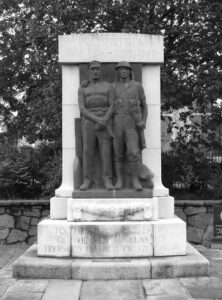
Llanelli War Memorial, The Great War, 1914-1918 (Surnames A to H)
Clement Adams, Private, 8080, Dorsetshire Regiment. Clement was the son of Mary Adams, of Swell, Taunton. He resided at Llanelli prior to the war, and enlisted at Porth into the 1st Battalion, Dorsetshire Regiment, which moved to France at the outbreak of war attached to 15 Brigade, 5th Division. The Division had landed at Havre on 15 August, 1914, and fought at the Battle of Mons, and during the retreat south, fighting at Le Cateau, then down to the Marne where the German attack was halted. They took part in the advance to the Aisne, before moving to Flanders, where they fought at the Battle of La Bassée, then at Messines in October, 1914. They fought here through First Ypres, and took part in the capture of Hill 60. Clement was killed here on 14 March 1915, aged 21. He is commemorated on the Ypres (Menin Gate) Memorial, Belgium.
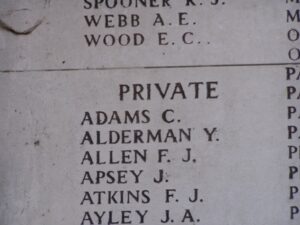
William John Almon, Private, 10901, Devonshire Regiment. William was the son of John and Margaret Almon, of Treharris. He resided at Llanelli prior to the war, enlisting there into the 8th (Service) Battalion, Devonshire Regiment. The battalion landed at Le Havre on 26 July 1915, and joined 20 Brigade, 7th Division. William was killed during his first major action, at the Battle of Loos, on 25 September 1915, aged 22. He is commemorated on the Loos Memorial, France.
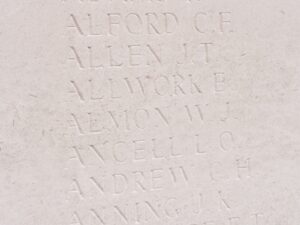
Thomas Kernahan Anderson, Private, S/924, Queen’s (Royal West Surrey) Regiment. Thomas was the son of Ninian and Jane Anderson, of Cecil Terrace, Glasgow. He was the husband of Emily Anderson (nee Jones), of 95, Ivanhoe Road, Denmark Park, London, and had been the Manager of Messrs. Foley Bros., Tooley Street, London prior to the war. Thomas was serving with the 2nd Battalion, Queen’s at the outbreak of war, which was recalled from South Africa, joining 2 Brigade, 7th Division, and landing at Zeebrugge on 6 October 1914. The Division moved to positions east of Ypres, where it took part in the First Battle of Ypres. Thomas was killed here on 18 December 1914. He was 30 years old, and is commemorated on the Ploegsteert Memorial, Belgium.
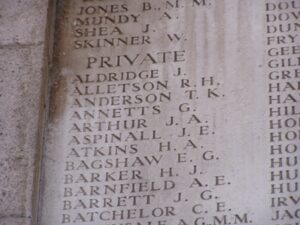
James Anthony, Lance Corporal, 21585, South Wales Borderers. James was born at Mountain Ash, probably the son of William and Rachel Anthony. He must have resided at Llanelli prior to the war, and enlisted at Newport into the South Wales Borderers. James was posted to the 2nd Battalion, South Wales Borderers, which was attached to 87 Brigade, 29th Division. The Division had fought at Gallipoli before moving to France on 15 March 1915. The Division took part in its first major action in France during the 1916 Somme Offensive, and fought at the Battles of Albert and Le Transloy, suffering heavy casualties. In the spring of 1917 they fought at the Battle of the Scarpe, which was part of the Arras Offensive, and then moved further north to Ypres. Here they fought at the Battle of Langemarck, and then at the Battles of the Menin Road, Polygon Wood, Broodseinde and Poelcappelle, before moving to Cambrai. Here they fought at the Battle of Cambrai. James was killed here on 3 December 1917, aged 19. He is commemorated on the Cambrai Memorial, Louverval, France.
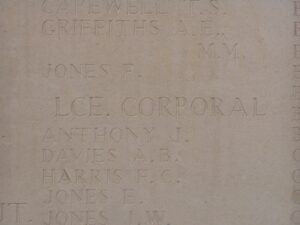
Percy Samuel Burroughs Arthur, Private, 200998, Welsh Regiment. Percy was the son of Samuel and Elizabeth Arthur, of 20, Brynallt Terrace, Stebonheath, Llanelli. He enlisted at Llanelli into the 1/4th Battalion, Welsh Regiment, and had fought at Gallipoli with the battalion, where it was attached to 159 Brigade, 53rd (Welsh) Division. Percy had returned home, and was stationed at Penally Camp, when he drowned whilst swimming under the Esplanade at Tenby on Saturday 18 August 1917. He was 19 years old, and was brought back to Llanelli for burial at Box Cemetery, Llanelli.
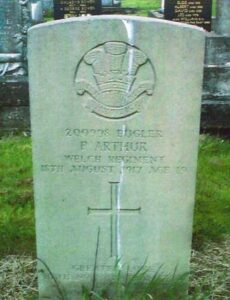
David Gwilym Jones Augustus, Private, 39574, South Wales Borderers. David was the son of David and Elizabeth Ann Jones-Augustus, of Llanelli. He enlisted at Llanelli into the army, and was posted to France in 1916, where he joined the 2nd Battalion, South Wales Borderers, which was attached to 87 Brigade, 29th Division. The Division had moved to the Western Front on 15 March 1915, and took part in its first major action in France during the 1916 Somme Offensive, fighting at the Battles of Albert and Le Transloy. David was wounded at Le Transloy, and evacuated to the Base Hospital at Etaples, where he died of wounds on 4 November 1916. He was 26 years old, and was buried at Etaples Military Cemetery, France.
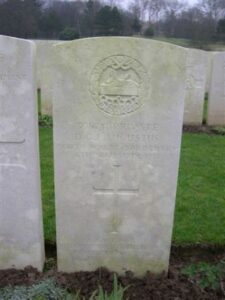
John Robert Awbery, Sapper, 42306, Royal Engineers. Robert was born at Llanelli, the son of Charles and Elizabeth Awbery (nee Nash). His parents later resided at Castlefield, Devonshire Road, Hornchurch, Romford, but John remained at Llanelli, with his wife Margaret. He enlisted at Llanelli into the Royal Engineers, and was posted to France with the 79th Field Company, which was attached to the 18th (Eastern) Division. On 25 May 1915 the Division landed in Boulogne, and didn’t see its first major action until July 1916 when it took part in the Somme Offensive. In March 1917 they followed the German Retreat to the Hindenburg Line, and in May took part in the Third Battle of the Scarpe, which was part of the Arras Offensive. July 1917 saw the Division at Ypres, and they took part in the Battle of Pilckem, where they helped capture Westhoek, before fighting at the Battle of Langemarck and the First and Second Battles of Passchendaele, followed by the Second Battle of Passchendaele. Robert was killed at Ypres when a German shell crashed into his hut while he was sleeping on 1 December 1917. He was 32 years old, and is buried at Bleuet Farm Cemetery, Belgium.
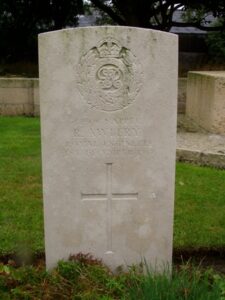
Harry Bagnall, Private, 48295, Welsh Regiment. Harry was the son of Edward and Elizabeth Bagnall, of Wesley Street, West Bromwich, and the husband of Mabel Maud Bagnall, of 64, George Street, Spon Lane, West Smethwick, Staffs. He must have resided at Llanelli prior to the war, as he enlisted there into the Welsh regiment. He was posted to Egypt, where he joined the 24th Battalion, Welsh Regiment, which had been formed by the merging of the Pembroke and Glamorgan Yeomanry regiments in February 1917. On 2 March 1917 the battalion joined 231 Brigade, 74th (Yeomanry) Division, and took part in the advance into Palestine from March 1917. Harry was wounded in Palestine, and died in Hospital on 4 October 1917. He was 27 years old, and is buried at Deir El Belah War Cemetery, Egypt.
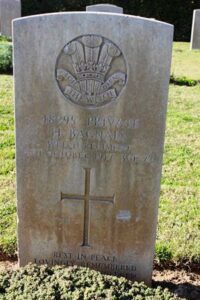
Thomas George Ballinger, Private, 12616, South Wales Borderers. Thomas was the son of Thomas and Margaret Ballinger, of 113, Lower Ann Street, Llanelli. He enlisted at Llanelli in August 1914 into the 4th Battalion, South Wales Borderers, which moved to the Mediterranean in June 1915 attached to 40 Brigade, 13th (Western) Division. From 6 July onwards the Division landed at Cape Helles, relieving the 29th Division. Thomas was killed in action just five days after he set foot on Gallipoli, when he was shot in the head by a sniper on 23 July 1915. He was 20 years old, and is commemorated on the Helles Memorial, Gallipoli.
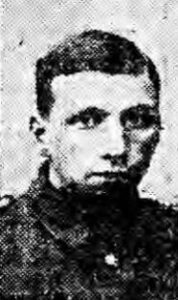
Gwilym Banks, Private, 13136, Welsh Regiment. Gwilym was born at Llangennech in March 1888, the son of William and Mary Banks. He enlisted at Llanelli into the 9th Battalion, Welsh Regiment, which was attached to 58 Brigade, 19th (Western) Division. The Division moved to France during July 1915, and moved to positions near Loos, where it took part in the opening attack of the Battle of Loos on 25 September 1915. The following year the Division moved to the Somme, where it took part in the second wave of the attack on Ovillers-La Boiselle on 1 July, capturing the village at heavy cost. It then fought through the Somme Battles of Pozieres and the Ancre in 1916. In 1917 the Division moved north to Ypres, taking part in the Battle of Messines, and throughout the Third Battle of Ypres. During December 1917 the Division moved into the Ribecourt Sector. Gwilym was killed here on 26 February 1918, aged 29. He is buried at Metz-En-Couture Communal Cemetery British Extension, France. Gwilym is not commemorated locally.
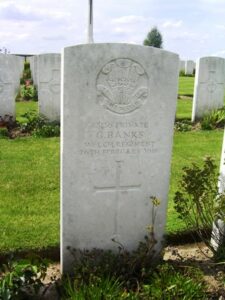
Richard Stanley Barkway, Private, 30802, East Yorkshire Regiment. Richard was the son of Richard and Kate Ellen Barkway, and had been born at Hinchley. The family resided at the Grove Hotel, St. David’s prior to moving to 53, Robinson Street, Llanelli prior to the war. Richard then enlisted at Carmarthen into the army sometime in 1917, and was posted to France to join the 1/4th Battalion, East Yorkshire Regiment, which was attached to 150 Brigade, 50th (Northumbrian) Division. The Division had fought at Second Ypres in 1915, and on the Somme in 1916. In 1917 it had fought at the Battle of Arras, and then at Passchendaele later that year. It remained at Ypres for the winter, before moving to St. Quentin, where it was hard hit by the German Spring Offensive of 21 March 1918, during the Battle of St Quentin. They took part in a gallant rearguard action during the Actions at the Somme Crossings, and then at the Battle of Rosieres. After suffering terrible casualties, the Division moved north to Flanders to rest and rebuild, but in April the Germans launched an attack in Flanders, around the Lys, and the Division took part in the Battle of Estaires, and it was here that Richard was mortally wounded. He died of his wounds aged just 18, on 21 April 1918, and is buried at Aire Communal Cemetery, France.
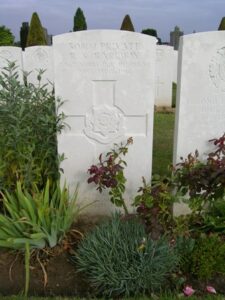
Charles Henry Bastin, Private, 23826, South Wales Borderers. Charles was born on 12 May 1897, the son of Robert and Emily Jane Bastin, of 5, Easton Rd., St. Philips, Bristol. He resided at Llanelli prior to the war, and enlisted there into the 14th Battalion, South Wales Borderers, which was a Home Service battalion. Charles took ill and died at Kinmel Park on 8 July 1916, aged 19. He is buried at Rhyl Church Cemetery, Wales.
Fred Bateman, Lance Corporal, 56719, Royal Welsh Fusiliers. Fred was the son of William and Margaret Bateman, of Green St., Kilkenny. He worked at Llanelli prior to the war, and enlisted there into the Welsh Regiment. Fred was posted to France, where he joined the 2nd Battalion, Royal Welsh Fusiliers, which at the time was on the Somme, attached to 19 Brigade, 33rd Division. Fred was wounded during the Battle of Bazentin Ridge, and died on 26 October 1916. He was 19 years old, and is buried at Grove Town Cemetery, Meaulte, France.
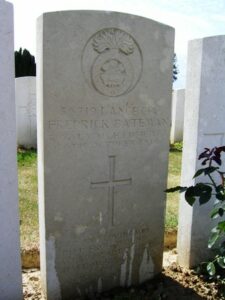
Richard Henry Bellows, Private, 38513, King’s Shropshire Light Infantry. Richard was the son of James and Alice Bellows, of Llanelli. He enlisted at Llanelli into the army, and was posted to the 7th Battalion, King’s Shropshire Light Infantry. The battalion initially moved to France on 28 September 1915 attached to 76 Brigade, 25th Division. It then transferred to 8 Brigade, 3rd Division, so that it could gain experience from the regular units within the division. The 7th KSLI saw action at the Somme the following year, then at Ypres and Cambrai in 1917. The Division was hit by the German Spring Offensive of 21 March 1918, and suffered heavy losses before being moved to Flanders to rebuild. However the Germans switched the focus of their offensive to Flanders, and the Division were caught up in the worst of the fighting there, at the Battle of Estaires, and then at the Battles of Hazebrouck and Bethune. By now the German offensive had stalled, and the Division were moved south to the Somme. Richard was killed on the Somme on 2 August 1918. He was 19 years old, and was buried at Sandpits British Cemetery, Fouqueureil, France.
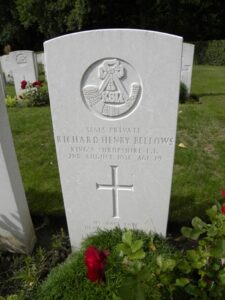
Harry Reeves Bennett, Gunner, 76058, Royal Garrison Artillery. Harry was born at Norwich, the son of Samuel Thomas Bennett and Mary Ann Bennett. He resided at Llanelli prior to the war, before enlisting into the Royal Garrison Artillery on 12 April 1916. Harry was posted to France where he joined the 79th Siege Battery, Royal Garrison Artillery during June 1916. Harry fought throughout the war, but was reported missing on 11 October 1918. A court of enquiry later found him to be missing presumed dead on that date, so Harry is commemorated on the Vis-En-Artois Memorial, France.
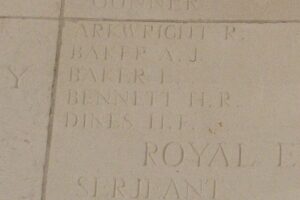
S. Bennett, Rifleman, King’s Royal Rifle Corps. This man cannot be positively identified. He could be one of three men of that name who fell with the KRRC during the Great War; Samuel was killed on 5 May 1915; Sidney William died of wounds on 15 October 1916, and Sylvester died of wounds on 9 May 1915. He could well be an error on the County War Memorial roll. (see below).
Sidney Llewellyn Bennett, Private, 226929, Monmouthshire Regiment. Sidney was the son of Llewellyn and Hannah Bennett, of 81, Old Castle Road, Llanelli. He enlisted at Newport into the 1st Battalion, Monmouthshire Regiment, which landed in France on 13 February 1915, attached to 84 Brigade, 28th Division. After suffering heavy casualties at Ypres, the battalion transferred to the 46th (North Midland) Division, as Pioneers on 3 September 1915. The Division took part in the Attack on the Gommecourt Salient, which was a diversionary attack on 1 July 1916 intended to draw attention away from the main attack on the Somme, but suffered heavy casualties during the attack. They rested for several months at Arras, and at the end of 1916 took part in Operations on the Ancre. During March 1917 the Division followed the German Retreat to the Hindenburg Line, and then fought in the Battle of Arras, taking part in the Battle of Hill 70. They were near Bethune when Sidney was wounded in July 1918. He died of his wounds on 7 July 1918, aged 21, and is buried at Fouquieres Churchyard Extension, France.
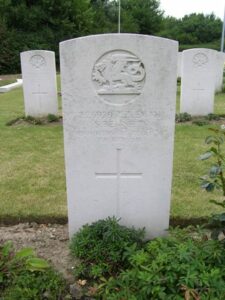
Thomas Bennett, Seaman, R/3452, Royal Naval Reserve. Thomas was born on 21 September 1888, and was the husband of Catherine Bennett, 42 Woodfield Terrace, Penrhiwceiber. He enlisted into the Pembroke Yeomanry, but transferred into the Royal Naval Division on 11 July 1917. Thomas was a draft for the BEF on 6 August 1917, and joined the 10th Entrenching Battalion. On 28 August 1917 he joined Nelson Battalion, RND, remaining with them until being hospitalised with a wounded hand on 14 October 1917. On 5 April 1918 Thomas was posted to Anson Battalion, 189 Brigade, 63rd (Royal Naval) Division, but was killed in action during the Battle of St. Quentin, on 9 April 1918. Thomas was 29 years old, and is commemorated on the Pozières Memorial, France.
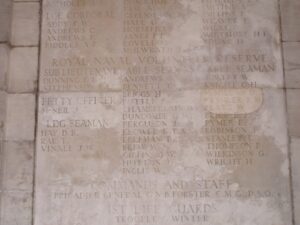
Thomas Lewis Bennett, Sapper, 175528, Royal Engineers. Thomas was the son of Thomas and Elizabeth Bennett of Red Lion Hotel, Drefach Henllan. He was a native of Kidderminster but the family had moved to the School House, Ferryside prior to the outbreak of war, where his father was a Policeman. Thomas had worked as a Collier and Policeman at Llanelli prior to the war and enlisted at Carmarthen into the Pembroke Yeomanry in December 1914. Thomas transferred into the Royal Engineers, where he served as a Sapper in 174 Tunnelling Company from 8 July 1916. This Tunnelling Company served on the Western Front throughout the war, and Thomas joined them on the Somme. By October 1916,174 Tunnelling Company had moved north of the Ancre, facing Beaumont-Hamel, before following the German withdrawal in 1917 towards the Cambrai area. Thomas was killed in Action here on 20 November 1917, during the Battle of Cambrai. He was 23 years old and was buried in Croisilles Railway Cemetery, France. His grave was lost during the battle but as he was definitely known to have been buried in the cemetery, Thomas is now remembered by a Special Memorial.
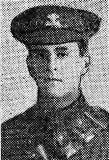
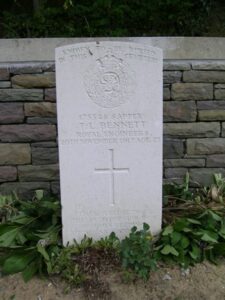
William Edgar Bevan, Private, 49613, Bedfordshire Regiment. William was the son of William John and Mary Eliza Bevan, of Cawdor Place, Upper Mill, Llanelli. He enlisted at Chiswick into the Army Service Corps, but later transferred into the 2nd Battalion, Bedfordshire Regiment, which was attached to 54 Brigade, 18th (Eastern) Division. The Division had been in France Since May 1915, and had fought throughout the Battle of the Somme the following year. They fought at Arras in 1917, then at the Third Battle of Ypres, before moving to the Somme area. The Division was one of the Divisions hit by the German Spring Offensive of 21 March 1918, and saw heavy fighting. When the great advance began on 21 August 1918, the Division took part in the drive towards the Hindenburg Line, and after the Line had been broken fought at the Battle of the Selle. William was killed here on 24 October 1918, aged 18. He is commemorated on the Vis-En-Artois Memorial, France.
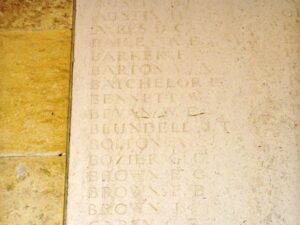
Albert Didymus Beynon, Private, 13165, Royal Welsh Fusiliers. Albert was the son of Evan and Margaret Ann Beynon, of 72, Pembrey Road, Llanelli. He was a fine athlete, having played full back for the Scarlets prior to the war; he was also an accomplished cricketer. He enlisted at Llanelli into the 9th Battalion, Royal Welsh Fusiliers, which moved to France in June 1915 attached to 58 Brigade, 19th (Western) Division. The Division saw its first action during the opening assault of the Battle of Loos on 25 September 1915, and it was here that Albert was killed, when he was struck by shrapnel in the head. He was 28 years old, and is commemorated on Panel 50-52 of the Loos Memorial, France.
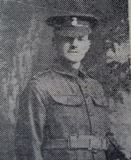
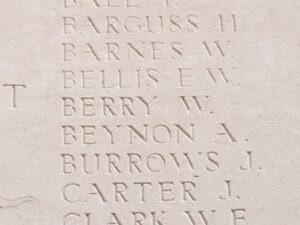
Herbert John Beynon, Private, G/15694, Royal Sussex Regiment. Herbert was born in 1877, the son of James and Margaret Beynon, of 18, Glanmor Road, Llanelli. He worked as a Draper at London prior to the war and married Ellen Lewis at Hendon on 1907. Herbert enlisted at Warley, Essex into the army. He was posted to the 11th Battalion, Royal Sussex Regiment, which was attached to 116 Brigade, 39th Division. The Division moved to France at the end of February 1916, and on 30 June 1916 it took part in an attack near Richebourg l’Avoue. The Division moved to the Somme in August 1916, where it fought at the Battle of the Ancre Heights, where they captured the Schwaben Redoubt, and helped capture Regina Trench. They then fought at the Battle of the Ancre, and remained on the Somme over the winter. Herbert was killed on the Ancre on 8 October 1916, aged 39. He is buried at Auchonvillers Military Cemetery, France.
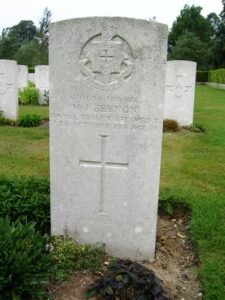
Frank Blackmore, Sergeant, 24082, Welsh Regiment. Frank was born at Llanelli in 1878, the son of Thomas and Sarah Blackmore. He had moved to Penarth prior to 1900, and lived at 40, Hewell Street, Penarth with his wife Elizabeth, and their five daughters. Frank enlisted at Penarth into the 16th Battalion (Cardiff City), Welsh Regiment, which was attached to 115 Brigade, 38th (Welsh) Division. The Division had landed in France during December 1915 and had spent their first winter in the trenches near Armentieres. In June they marched south to the Somme, where they were tasked with the capture of Mametz Wood. The attack on the wood began on 7 July, but met with fierce resistance, with the wood being well covered by German machine-guns. Frank was killed during the second assault on the wood, on 10 July 1916. He was 38 years old, and is commemorated on the Thiepval Memorial, France.
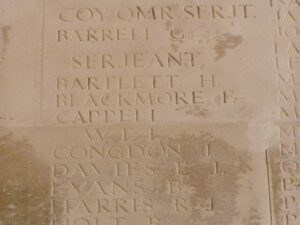
Julian Victor Blackwell, Second Lieutenant, Lancashire Fusiliers. Julian was born at Llanelli in 1898, the son of Julian and Emma Blackwell. The family later resided at 34, Austin Street, Tunstall, Wolverhampton, and Julian was educated at Wolverhampton Higher Grade School. He was commissioned in August 1917 into the 11th Battalion, Lancashire Fusiliers, which was in France attached to 74 Brigade, 25th Division. Julian probably joined the battalion after it had moved to Arras from Ypres. Here the Division was used to reinforce the badly depleted British units that were hit in the area by the German Spring Offensive. They moved north to Flanders on the night of 30 March 1918, where they took up positions at Ploegsteert, where they received reinforcements, and rebuilt. However, on 9 April 1918 the Germans launched an offensive on the Lys, and the Division was caught up in the terrible fighting here. Julian was killed in action on 11 April 1918, while attempting to rush a machine gun emplacement. He was 20 years old, and is commemorated on the Ploegsteert Memorial, Belgium.
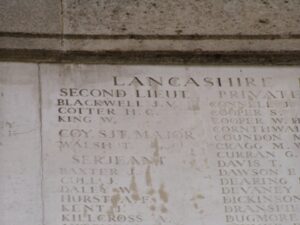
George Cyril Blake, Lieutenant, Welsh Regiment. George was the Only son of George Frederick and Annie Lambert Blake, of 35, College Hill, Llanelli. He was commissioned into the 1/4th Battalion, Welsh Regiment, which was the local Territorial Battalion, attached to 159 Brigade, 53rd (Welsh) Division. The Division landed at Cape Helles, Gallipoli, on 9 August 1915, and was immediately thrown into action, spending the next few days in isolated pockets, fighting against a Turkish counter-attack during the Battle of Sari Bair, and then at the Attack on Scimitar Hill. The Division remained here throughout the coming months, and suffered severe losses in manpower strength during the great November 1915 blizzard on Gallipoli, when its total strength was reduced to less than that of a full-strength Brigade. On 11 December 1915 the Division was evacuated to Mudros, and by 23 December 1915 were moved to Egypt. They remained on the Suez Canal Defences for the next twelve months, where it took part in operations against the Sultan of Darfur, and in March 1917 took part in the advance into Palestine. George must have taken ill during this time, and was evacuated to England, where he was hospitalised at Manchester. He died there on 5 November 1917, aged 31, and is buried at Manchester Southern Cemetery.
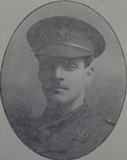
William Henry Bodman, Private, 8510, Royal Irish Regiment. William was the son of William and Sarah Ann Bodman, of 134, Old Castle Road, Llanelli. He was a Tinplater prior to the war, and enlisted at Llanelli into the Hussars on 30 August 1914. He embarked for France on 22 June 1915 to join the 2nd Battalion, Royal Irish Regiment, which was attached to 22 Brigade, 7th Division. William then fought at the Battle of Loos in September, and moved with his Battalion to the Somme in July 1916. He was killed there at the Battle of Delville Wood on 3 September 1916. William was 24 years old, and is buried at Delville Wood Cemetery, Longueval, France.
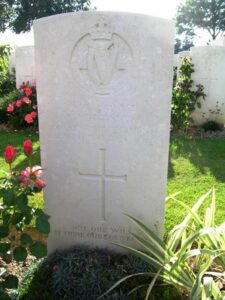
William Bourne, Private, 5344, Welsh Regiment. William was born at Llanelli, and enlisted there the 1/4th Battalion, Welsh Regiment, which was the local Territorial Battalion, attached to 159 Brigade, 53rd (Welsh) Division. The Division landed at Cape Helles, Gallipoli, on 9 August 1915, and was immediately thrown into action, spending the next few days in isolated pockets, fighting against a Turkish counter-attack during the Battle of Sari Bair. William was wounded during the coming days, and evacuated to Hospital at Alexandria, where he died of his wounds on 28 August 1915. He is buried at Alexandria (Chatby) Military Cemetery, Egypt.
Clifford Anderson Bowen, Private, 13437, Royal Welsh Fusiliers. Clifford was the youngest child of Morgan and Sarah Emily Bowen (née Fleming), of 6, Llwynwhilog Terrace, Llanelli. His father died in 1895 and his mother married William Moodie in 1897. Clifford enlisted at Llanelli into the 9th Battalion, Royal Welsh Fusiliers, which was attached to 58 Brigade, 19th (Western) Division. The Division crossed to France during July 1915, and moved to positions near Loos, where it took part in the opening attack of the Battle of Loos on 25 September 1915. The following year the Division moved to the Somme, where it took part in the second wave of the attack on Ovillers-La Boisselle on 1 July, capturing the village at heavy cost. It then fought through the Somme Battles of Pozières and the Ancre in 1916. Clifford was shot in the head on 18 August 1916, and was evacuated to Hospital for treatment. He died of his wounds on 25 August 1916, and is buried at Bailleul Communal Cemetery Extension, France.
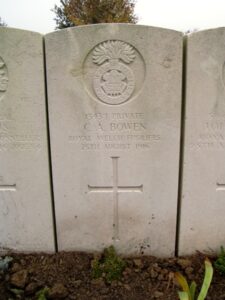
G. Bowen, Private, South Wales Borderers. This man cannot presently be identified, but is probably Griffith Bowen, of 6, Havelock Street, Llanelli. Griffith served as a Private with the South Wales Borderers, with the service number 16671. He survived the war but died at Llanelli in 1920, aged 32.
Oliver Bowen, Private, 227373, Monmouthshire Regiment. Oliver was the son of Daniel and Sarah Ann Bowen, of 21, Pentrepoeth, Furnace; Llanelli. He enlisted at Newport into the 1st Battalion, Monmouthshire Regiment. The battalion had landed in France on 13 February 1915, joining 84 Brigade, 28th Division at Ypres. It fought at Second Ypres, and in September 1915 became the Pioneer Battalion to the 46th (North Midland) Division. The Monmouths then fought at the Hohenzollern Redoubt near Loos, before temporarily departing for Egypt, where it was immediately recalled to France, and took part in the attack on the Gommecourt Salient on 1 July 1916. The Division rested for several months at Arras, and at the end of 1916 took part in Operations on the Ancre. During March 1917 the Division followed the German Retreat to the Hindenburg Line, and then fought in the Battle of Arras, taking part in the Battle of Hill 70. Oliver was killed near Arras on 22 November 1917. He was 24 years old, and is commemorated on the Cambrai Memorial, Louverval, France.
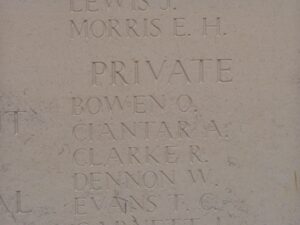
Sydney Bowen, Private, 285058, Cheshire Regiment. Sydney was born at Llanelli, and enlisted at Bridgend into the Glamorgan Yeomanry. He was later posted to France, where he joined the 11th Battalion, Cheshire Regiment. The battalion had been in France since September 1915 attached to 7 Brigade, 25th Division, and were posted to the Vimy area. They then moved to the Somme and attacked on 3 July 1916 near Thiepval. They fought throughout the Battle of the Somme, and then moved to Ploegsteert, where they held the line for the months leading up the Battle of Messines in June 1917. After fighting at Messines, the Division moved north, and fought at Pilckem, before moving south again, where they took up positions around Bullecourt in reserve. Here the Division was used to reinforce the badly depleted units that were hit in the area by the German Spring Offensive. They moved north to Flanders on the night of 30 March 1918, where they took up positions at Ploegsteert again, where they received reinforcements, and rebuilt. However on 9 April the Germans launched an offensive on the Lys, and the Division was caught up in the terrible fighting here. Sydney was killed during the Battle of Kemmel, on 20 April 1918. He is commemorated on the Tyne Cot Memorial, Belgium.
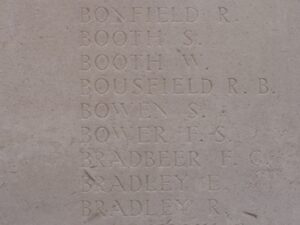
Thomas John Bowen, Private, 14480, South Wales Borderers. Thomas was the son of Thomas and Jane Bowen, of 21, Custom House Bank, Llanelli. Prior to the war he lived with his wife, Sarah, at 81, Dillwyn Street, Llanelli. Thomas had enlisted at Llanelli into the 5th Battalion, South Wales Borderers, which was attached to 58 Brigade, 19th (Western) Division. The Division crossed to France during July 1915, and moved to positions near Loos, where it took part in the opening attack of the Battle of Loos on 25 September 1915. The following year the Division moved to the Somme, where it took part in the second wave of the attack on Ovillers-La Boiselle on 1 July 1916, capturing the village at heavy cost. Thomas was killed during later fighting at Pozieres, on 30 July 1916. He was 28 years old, and is commemorated on the Thiepval Memorial, France.
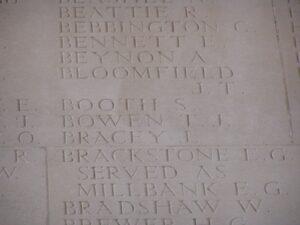
William George Bowen, Sapper, 908, Royal Engineers. William was born at Llanelli in 1887. He married Margaret Hannah Anthony in 1909, and the couple resided at 34, Penygroes Street, Llanelli. William enlisted in April 1915 into the 3rd/1st Welsh Field Company, Royal Engineers. He was discharged from the army on 4 June 1915 as being deemed unlikely to become an efficient soldier. No more is currently known of him, but he died in 1918, aged 32, and is not commemorated by the CWGC.
William James Bowen, Private, 28712, Somerset Light Infantry. William was the son of Benjamin and Mary Anna Bowen, of 5, Annesley Street, Llanelli. He served with the Monmouth Regiment before being transferred into the 1st Battalion, Somerset Light Infantry, which was attached to 11 Brigade, 4th Division. The Division had been in France since the outbreak of war, and had fought in the retreat from Mons to the Marne. The Division was then moved north to Flanders, and took part in the Battle of Messines. In 1915 the Division fought at the Second Battle of Ypres, and in the summer of 1916 were on the Somme, where they fought at the Battle of Albert and the Battle of Le Transloy. In April 1917 they fought at the Battle of Arras, before moving back to Ypres, and fighting throughout the Passchendaele Offensive In spring 1918 the Division fought at the First Battle of Arras, and were then moved back to Flanders, where they were caught up in heavy fighting during the German attack on the Lys. William was wounded here during the Battle of Hazebrouck, and died on 16 April 1918. He was 26 years old, and is buried at Pernes British Cemetery, France.
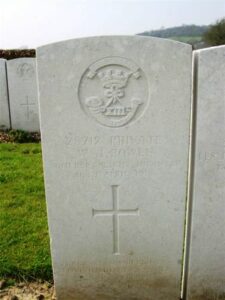
Robert Bowser, Lance Corporal, 202636, Welsh Regiment. Robert was the son of Alfred and Hannah Bowser, of Llanelli. He joined the 18th Battalion, Welsh Regiment, which was attached to 119 Brigade, 40th (Bantam) Division. The Division moved to France during June 1916, and moved to the front near Loos. Late in 1916 they moved south to the Somme, and fought at the Battle of the Ancre, and remained in the area over the winter. In March 1917 the Germans withdrew to their shortened line, called the Hindenburg Line, and the 40th Division were one of the Divisions that followed the withdrawal. Later in the year they took part in the Battle of Cambrai, playing an important role in the attack on Bourlon Wood. They remained in the area over the coming months, but were caught here by the German Spring Offensive of 21 March 1918, and suffered heavy casualties in the coming days. Robert was shot in the neck during this period, and sent back to King George’s Hospital, London for treatment. He died of his wounds on 29 April 1918, aged 32, and is buried at Llanelli (Old Road) Church Cemetery.
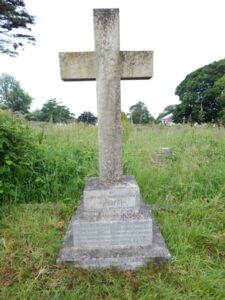
William George Brewer, Private, 5022, Welsh Regiment. William was the son of Samuel and Ellen Brewer, of 3, Crooked Row, Llanelli. He was a Tinworker prior to enlisting at Llanelli into the 1/4th Battalion, Welsh Regiment, which was the local Territorial Battalion, attached to 159 Brigade, 53rd (Welsh) Division. The Division landed at Cape Helles, Gallipoli, on 9 August 1915, and was immediately thrown into action, spending the next few days in isolated pockets, fighting against a Turkish counter-attack during the Battle of Sari Bair. William was killed here on 10 August 1915, aged 19, and is commemorated on the Helles Memorial, Gallipoli.
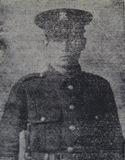
William Thomas Brookes, Private, 33521, Welsh Regiment. William was born in Lostock Gralam, Cheshire, and worked at Llanelli prior to the war. He enlisted there into the army, and was posted to France, where he joined the 2nd Battalion, Welsh Regiment, which was attached to 3 Brigade, 1st Division. The Division had been one of the first to arrive in France, fighting at the Battle of Mons, and taking part in the retreat to the Marne, where the Germans were stopped. They then fought at the Aisne, and at Chivy, before being moved north to Ypres. Here they fought at the First Battle of Ypres, where they again stopped the German Offensive, before wintering in Flanders. The following year saw them in action again at the Battle of Aubers, before moving South to Loos. William was killed here during the Battle of Loos, on 25 September 1915. He is commemorated on the Loos Memorial, France.
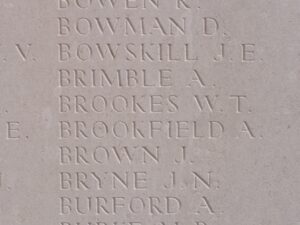
William Henry Albert Brown, Private, 52687, Welsh Regiment. William was the son of Henry and Mary Ann Brown, of Swansea, and the husband of Annie Brown, of 24, Downing Street, Llanelli. He joined the army at Cardiff, and was posted to France late in 1916, joining the 9th Battalion, Welsh Regiment, which was attached to 58 Brigade, 19th (Western) Division. In 1917 the Division moved North to Ypres, taking part in the Battle of Messines. William was wounded early in August 1917, and died of his wounds on 11 August 1917, aged 27. He is buried at Bailleul Communal Cemetery Extension, France.
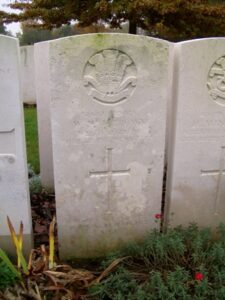
William Joseph Barry Brown, Lieutenant, Royal Flying Corps. William was the son of Richard and Margaret Brown, of 10, Great Western Terrace, Llanelli. He had served with the 1st City of London Yeomanry (Rough Riders), before volunteering to serve with the Royal Flying Corps, and was posted to Egypt, where he joined the Aerial Fighting School, 38th Training Wing. William was killed in an accident on 21 February 1918. He was 29 years old, and is buried at Cairo War Memorial Cemetery, Egypt.
Joseph Bulcock, Private, 63064, Welsh Regiment. Joseph was the son of Joseph and Elizabeth Bulcock, of 16, Fir Street, Burnley. He resided at 69, Pottery Street, Llanelli prior to the war, playing football for Swansea City AFC, and enlisted at Pembrey into the Pembroke Yeomanry on 11 December 1915. On 29 September 1917 Joseph landed in France, and was posted to the 9th Battalion, Welsh Regiment, which was at Ypres attached to 58 Brigade, 19th (Western) Division. The Division had been in France since July 1915, and moved to positions near Loos. The Division fought during the opening attack of the Battle of Loos, and then moved to the Somme, where they took part in the second wave of the attack on Ovillers-La Boiselle on 1 July 1916, capturing the village at heavy cost, and fought through the Somme Battles of Pozieres and the Ancre in 1916. They then moved north to Ypres, taking part in the Battle of Messines, and fought on the Menin Road. The division then moved south to the Hindenburg sector north east of Bapaume for the winter, and on 21 March 1918 were hit by the German offensive, Operation Michael, suffering heavy casualties over the coming days. The battered division then moved north, taking up positions again along Messines Ridge. Unfortunately the division was hit again, by a renewed German offensive on the Lys, which was launched on 9 April, and took part in heavy fighting over the coming days. Joseph was wounded by a bullet in the head during the Battle of the Lys. He was transported back to the Casualty Clearing Station at Haringhe for treatment, but died of wounds there on 20 April 1918, age 39. He is buried at Haringhe (Bandaghem) Military Cemetery, Belgium. Joseph is not commemorated locally.
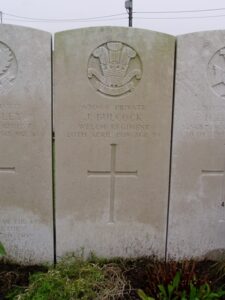
Alfred Ernest Bullock, Private, 50898, North Staffordshire Regiment. Alfred was the son of Alfred and Annie Bullock of Bath. He had served in the army during the Boer War, then married, and resided with his wife, Lily Louisa Bullock, at Thornsbeach Bungalow, New Road, Pwll, Llanelli. Alfred re-enlisted at the outbreak of war, and was posted to the Depot Battalion of the North Staffordshire Regiment. Alfred was deemed as unfit for service overseas, and remained on home service for the duration, being attached to the 504th Agricultural Company at Carmarthen Grammar School on 26 February 1918. He became ill, and died on 14 March 1919, aged 35, and is buried at Llanelli (Old Road) Church Cemetery.
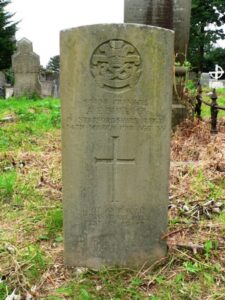
Ernest Barron Burgess, Private, 55558, Royal Welsh Fusiliers. Ernest was the son of George and Harriet Burgess, of St. Hilda, Merthyr-Mawr Road, Bridgend, and the husband of Muriel Jane Burgess. Ernest had served with the Welsh Horse Yeomanry before being transferred into the 2nd Battalion, Royal Welsh Fusiliers, probably late in 1916, which was attached to 19 Brigade, 33rd Division. They then fought at the Battle of the Scarpe and at Bullecourt, before heading to Ypres, and fighting at the Menin Road and at Polygon Wood. Ernest was killed at Ypres on 10 October 1917. He was 24 years old, and is buried at La Plus Douve Farm Cemetery, Belgium.
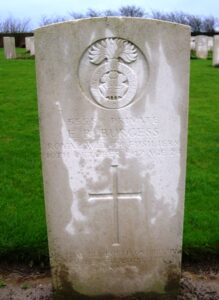
Alfred Leonard Burton, Corporal, 7809, King’s Royal Rifle Corps. Alfred was the son of Alfred E. and Harriet Burton, of 2, Lichfield Street, Stourport, Worcs. He had lived with his Uncle, Charles Herbert Burton, at 87, Old Castle Road, Llanelli prior to joining the army in 1907, and served with the King’s Royal Rifle Corps. At the outbreak of war, Alfred moved to France with their 2nd Battalion, which was attached to 2 Brigade, 1st Division. The Division took part in the retreat from Mons to the Marne, before being sent to Ypres. Here they fought at the First Battle of Ypres, where they helped stop the German Offensive, before wintering in Flanders. The following year saw them in action again at the Battle of Aubers Ridge, and it was here on 9 May 1915 that Alfred was killed. He was 28 years old, and is commemorated on the Le Touret Memorial, Richebourg L’Avoue, France.
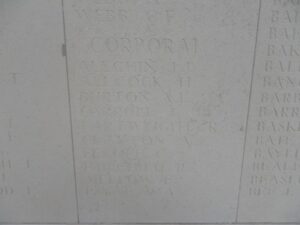
Charles Edward Butcher, Private, 9817, Worcestershire Regiment. Charles was the son of Charles and Mary Ann Butcher, of Brook Street, Benson, Wallingford, Berks. He enlisted into the 4th Battalion, Worcestershire Regiment, which became attached to 88 Brigade, 29th Division. The Division moved to the Mediterranean, landing at Gallipoli on 25 April 1915, and remained here for the duration of the campaign. Charles was killed in action during the Battle of Krithia Vineyard on 6 August 1915. He was 19 years old, and is commemorated on the Helles Memorial, Gallipoli.
Arthur Butchers, Private, 539, Royal Irish Regiment. Arthur was the fifth son of Thomas and Frances Butchers, of 15, Custom House Bank, Seaside, Llanelli. He enlisted at Llanelli into the army, and was posted to the 5th Battalion, Royal Irish Regiment, which was attached to 29 Brigade, 10th (Irish) Division. On 27 June 1915 the Division received orders to prepare for service on Gallipoli, and embarked at Liverpool on 9 July. By the end of the month most units had assembled on Lemnos, and on 6 August 1915 29 Brigade landed at Anzac Cove, Gallipoli. Parts of 29 Brigade took part in actions on Sari Bair from 6 August, and it was here that Arthur was killed on 16 August 1915. He was 18 years old, and is commemorated on the Helles Memorial, Gallipoli. His cousin Thomas also fell.
Thomas Butchers, Private, 20133, Royal Welsh Fusiliers. Thomas was the son of John and Mary Butchers, of 23, Ropewalk Road, New Dock, Llanelli. He enlisted at Llanelli into the 14th Battalion, Royal Welsh Fusiliers, which moved to France in December 1915 attached to 113 Brigade, 38th (Welsh) Division. After several months initiating into trench warfare around the Fleurbaix and Givenchy sectors, the Division moved to the Somme in June 1916, and on 7 July 1916 launched its assault on Mametz Wood. The first attack failed, with many lives lost, and it wasn’t until 10 July that the assault was renewed. Thomas was killed that day. He was 23 years old, and is commemorated on the Thiepval Memorial, France. His cousin Arthur also fell.
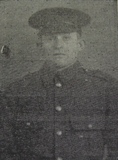
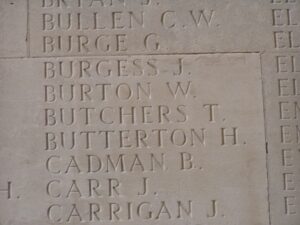
David Walter Cainan, Lance Corporal, 9866, Rifle Brigade. David was born on 9 April 1886, the son of William and Catherine Cainan, of 49 Albert Street, Llanelli. He had enlisted into the army on 4 May 1903, and had served in Malta and India, prior to the outbreak of war, with the 2nd Battalion, Rifle Brigade. The battalion was recalled to Britain from India, where it joined 25 Brigade, 8th Division, and moved to the Western Front in October 1914. They saw their first major action at the Battle of Neuve Chapelle, and it was here, on 14 March 1915, that David was killed. He was 28 years old, and is commemorated on the Le Touret Memorial, Richebourg L’Avoue, France.
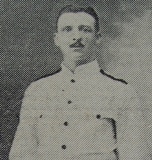
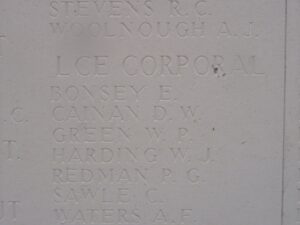
Ernest George Cairns, Private, 59172, Royal Army Medical Corps. Ernest was the son of Robert and Annie Cairns, of London. He resided at Llanelli prior to the war, and enlisted at Carmarthen into the Royal Army Medical Corps. He served aboard HMHS Galeka, a Hospital Ship. She served on the South Africa route until the First World War when she was used as a troop transport, carrying troops of the Australian and New Zealand Army Corps to the Gallipoli Campaign. Galeka was then refitted as a hospital ship with accommodation for 366 wounded passengers. On 28 October 1916, while entering Le Havre, HMHS Galeka struck a mine. She was not carrying patients, but 19 Royal Army Medical Corps personnel died in the explosion. Ernest was 37 years old when he was killed that day. He is buried in the Galeka Plot at Ste. Marie Cemetery, Le Havre, France.
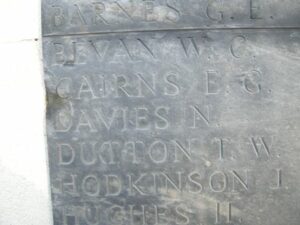
William Callaghan, Acting Corporal, 200766, Welsh Regiment. William was the son of John and Mary Callaghan, of 19, Oxen Street, Llanelli. He enlisted there into the 1/4th Battalion, Welsh Regiment, which was the local Territorial Battalion, attached to 159 Brigade, 53rd (Welsh) Division. The Division landed at Cape Helles, Gallipoli, on 9 August 1915, and was immediately thrown into action, spending the next few days in isolated pockets, fighting against a Turkish counter-attack during the Battle of Sari Bair. The Division remained here throughout the coming months, and suffered severe losses in manpower strength during the great November 1915 blizzard on Gallipoli, when its total strength was reduced to less than that of a full-strength Brigade. On 11 December 1915 the Division was evacuated to Mudros, and by 23 December 1915 were moved to Egypt. They remained on the Suez Canal Defences for the next twelve months, where it took part in operations against the Sultan of Darfur, and in March 1917 took part in the advance into Palestine. William was wounded at Gaza, and died on 18 July 1917 of his wounds. He was 22 years old, and is buried at Haifa War Cemetery, Egypt.
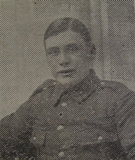
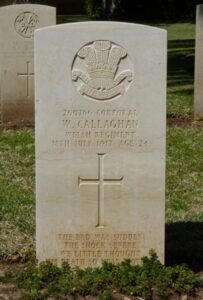
Martin Carey, Gunner, 7505, Royal Garrison Artillery. Martin was born at Tipperary on 15 June 1876, the son of Martin and Mary Carey. He worked at Llanelli prior to the war. He had served in France from 5 December 1915, before returning home to serve with No.2 Depot Company, Royal Garrison Artillery, which was a Home Service unit. Martin was accidentally killed at Fareham, Hampshire on 25 November 1916. Martin is buried at Fareham Cemetery, England.
Thomas Wright Carson, Second Lieutenant, West Riding Regiment. Thomas was born on 29 November 1884, the son of Rev. William Carson, Vicar of Girlington, Bradford, and Fanny Carson (nee Bairstow), of Salisbury Street, Skipton, Yorks. He worked as a Solicitor at Llanelli prior to the war, and lived at New Road, Llanelli. Thomas was commissioned on 6 October 1914 into the 6th Battalion, West Riding Regiment. On 14 April 1915 the battalion landed at Boulogne, and on 15 May 1915 became part of 147 Brigade, 49th (West Riding) Division. Thomas was killed in action while leading a patrol at Hill 62, Ypres on 27 December 1915. He was 31 years old, and is buried at Sanctuary Wood Cemetery, Belgium.
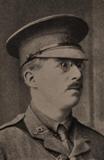
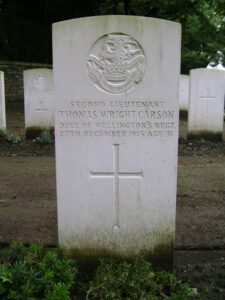
Frederick John Carter, Private, 37080, Cameronians. Frederick was born at Castleford, Yorkshire, the son of William and Laura Carter. By 1911 the family had moved to 9, Office Road, Maesteg, and Frederick came to work at Llanelli. He enlisted at Bridgend into the Army Service Corps. Frederick was later posted to the 11th Battalion, Cameronians, which were attached to 77 Brigade, 26th Division. The Division moved to France in September 1915, and concentrated at Guignemicourt, west of Amiens. In November 1915 the Division moved to Salonika, where it remained. Frederick was killed in Salonika, during the Battle of Doiran, on 19 September 1918, aged 24. He is commemorated on the Doiran Memorial, Greece.
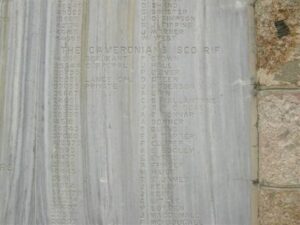
William Charles Carter, Private, 8139, Royal Berkshire Regiment. William was the husband of Mary J. Carter, of 16, St. John’s St., Malmesbury, Wilts. He worked for the Great Western Railways at Llanelli prior to the war, and enlisted there into the army. William was posted to the 1st Battalion, Royal Berkshire Regiment, which was attached to 99 Brigade, 2nd Division. William was killed at Loos on 6 February 1916. He was 36 years old, and is buried at Chocques Military Cemetery, France.
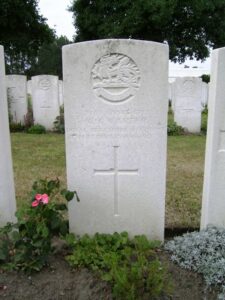
W. Cartwright, Private. This man cannot presently be identified.
Hubert Brabyn Chapman, Private, 43584, Worcestershire Regiment. Hubert was the son of James and Annie Mary Chapman, of 38, Pembrey Road, Llanelli. He enlisted there into the Cheshire Regiment. He was posted to the 2/8th Battalion, Worcestershire Regiment, which was attached to 182 Brigade, 61st (2nd South Midland) Division. The Division moved to the Western Front in May 1916, moving to positions at Fromelles, and took part in the disastrous attack there on 19 July 1916. The Division suffered very heavy casualties, and didn’t see action again until March 1917, when it followed the German withdrawal to the Hindenburg Line. Later that year it fought at the Battle of Langemarck. The Division then moved south, where it took part in the Battle of Cambrai. During March 1918 the Division was holding the forward defences in the sector northwest of Saint Quentin, near Ham, and lost many men during the coming days. After suffering heavy casualties, the depleted Division was moved to Flanders to rest, but the Germans launched the second phase of their offensive here just weeks later, seeing the Division in the thick of the action again. Hubert was wounded on 9 April 1918, and died two days later, on 11 April 1918, aged 19. He is buried at Lillers Communal Cemetery, France.
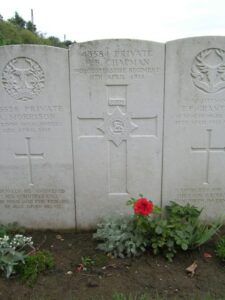
James Chappell, Private, 17965, Grenadier Guards. James was born in Wiltshire, but worked at Llanelli prior to the war. He enlisted there into the 1st Battalion, Grenadier Guards, which had moved to France in September 1914 attached to 20 Brigade, 7th Division. On 4 August 1915 the battalion transferred to 3rd Guards Brigade, Guards Division, and took part in the Battle of Loos. In July 1916 the Division moved to the Somme, where they fought at the Battle of Flers-Courcelette, and then at the Battle of Morval, capturing Lesboeufs Village. They remained here for the winter, and in March 1917 took part in the advance caused by the German Retreat to the Hindenburg Line. Later that year they moved north to Ypres, where they fought at the Battle of the Pilkem Ridge. James was killed here on 5 August 1917. He is commemorated on the Ypres (Menin Gate) Memorial, Belgium.
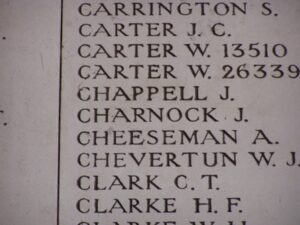
David John Charles, Private, 43298, Welsh Regiment. David was the son of John and Mary Ann Charles, of 22, George Street, Llanelli. He enlisted at Llanelli into the army, and was posted to the 9th Battalion, Welsh Regiment, which was attached to 58 Brigade, 19th (Western) Division. David probably joined the battalion after its successful attack on La Boiselle, on the Somme in July 1916. In 1917 the Division moved North to Ypres, taking part in the Battle of Messines, and fought on the Menin Road and at Polygon Wood, before moving up to Broodseinde, Poelcappelle and Passchendaele Village itself. In 1918 they were caught up in the German Spring Offensive near St. Quentin, where they suffered terrible casualties, and fought at the Battle of Bapaume. They moved to Ypres, but were caught up in the German attack at Messines, and at Bailleul, and Kemmel. After suffering terribly again, they moved South to the quieter French sector to rebuild, but were caught up in the German offensive on the Aisne, and suffered heavy casualties again. David was killed here on 30 May 1918. He was 38 years old, and is commemorated on the Soissons Memorial, France.
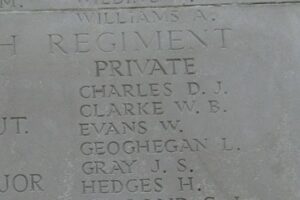
Howell Charles, Private, 4325, Welsh Regiment. Howell was the son of Griffith and Hannah Charles, of 11, Caroline Street, Llanelli. He was employed at Llanelli Copper Works before the war, and enlisted at Llanelli into the 1/4th Battalion, Welsh Regiment, which was the local Territorial Battalion, attached to 159 Brigade, 53rd (Welsh) Division. The Division landed at Cape Helles, Gallipoli, on 9 August 1915, and was immediately thrown into action, spending the next few days in isolated pockets, fighting against a Turkish counter-attack. Howell was killed here on 10 August 1915. He was just 19 years old, and is commemorated on the Helles Memorial, Gallipoli.
Joseph Emlyn Charles, Private, 306895, Tank Corps. Joseph was the son of John and Elizabeth Charles, of 3, Charles Street, Marble Hall, Llanelli. He originally served with the Cheshire Regiment, but volunteered to serve with the 4th Battalion, Tank Corps. The Battalion was caught up in the German offensive on the Somme on 21 March 1918, and lost all bar one of its tanks over the coming days. The survivors must have moved north to Flanders to rebuild, but were caught up in a fresh German attack here on 9 April 1918. Joseph was killed near Hazebrouck on 25 April 1918. He was 19 years old, and is buried at Morbecque British Cemetery, France.
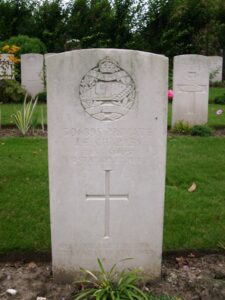
Sidney Thomas Chatham, Sergeant, 18801, Royal Welsh Fusiliers. Sidney was born at Llanelli in December 1888, the son of Stephen and Sarah Chatham. The family later moved to 19, Maesteg Road, Port Talbot, and Sidney enlisted at Neath into the 14th Battalion, Royal Welsh Fusiliers, which was attached to 113 Brigade, 38th (Welsh) Division. The Division had landed in France during December 1915 and had spent their first winter in the trenches near Armentieres. In June they marched south to the Somme, where they famously captured Mametz Wood during July 1916. During the following year the Division fought at Pilckem Ridge and Langemarck, before wintering in the Armentières sector, where they remained until March 1918 when the German Spring Offensive was launched on the Somme. The British had been over-run on the Somme, and so in April the 38th Division was moved south, taking up positions North of Albert, from where they weathered the storm of the coming months. On 21 August 1918 the Division launched its assault across the River Ancre, and over the coming weeks drove the Germans back to the Hindenburg Line, before heading towards Le Cateau and the Forest of Mormal. Sidney was killed in action here, during the Battle of the Selle, on 20 October 1918. He was 29 years old, and is commemorated on the Vis-En-Artois Memorial, France.
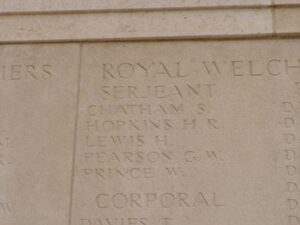
Matthew Cheevers, Private, 14121, King’s Liverpool Regiment. Matthew was the son of James and Catherine Cheevers (nee Hanlon), of Horeswood, Campile, Co. Wexford. He worked at Llanelli prior to the war, along with his brother Patrick, and enlisted with Patrick into the army on 28 September 1914. He was posted to France with the 12th Battalion, King’s Liverpool Regiment, which was attached to 61 Brigade, 20th (Light) Division. On 26 July 1915 the Division moved to the Fleurbaix Sector for trench familiarisation and training. When the Battle of Loos was launched on 25 September 1915 the Division fought a diversionary attack towards Fromelles. Later that year they moved north, and fought at the Battle of Mount Sorrel alongside the Canadian Corps. They then fought through the Somme Offensive, at the Battles of Delville Wood, Guillemont, Flers-Courcelette, Morval and Le Transloy, and took part in the advance to the Hindenburg Line in March 1917. Matthew was wounded here, and died on 27 March 1917, aged 23. He is buried at Hermies Hill British Cemetery, France. His brother Patrick was killed on 3 May 1917.
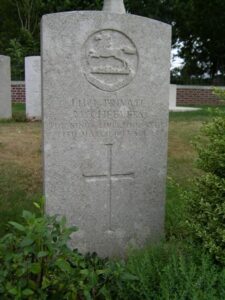
Patrick Cheevers, Sergeant, 14122, King’s Liverpool Regiment. Patrick was the son of James and Catherine Cheevers, of Horeswood, Campile, Co. Wexford. He worked at Llanelli prior to the war, along with his brother Michael, and enlisted with Michael into the army on 28 September 1914. He was posted to France with the 12th Battalion, King’s Liverpool Regiment, which was attached to 61 Brigade, 20th (Light) Division. On 26 July 1915 the Division moved to the Fleurbaix Sector for trench familiarisation and training. When the Battle of Loos was launched on 25 September 1915 the Division fought a diversionary attack towards Fromelles. Later that year they moved north, and fought at the Battle of Mount Sorrel alongside the Canadian Corps. They then fought through the Somme Offensive, at the Battles of Delville Wood, Guillemont, Flers-Courcelette, Morval and Le Transloy, and took part in the advance to the Hindenburg Line in March 1917. Patrick was killed here on 3 May 1917, aged 26. He is commemorated on the Arras Memorial, France. His brother Michael died on 27 March 1917.
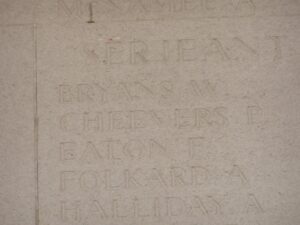
George Henry Chester, Private, 102172, Machine Gun Corps. George was the son of Joseph and Sarah Ann Chester, of Union Row, Llanelli. He resided at Bryntirion Terrace, Llanelli prior to the war, and served with the 228th Company, Machine Gun Corps, which was attached to the 39th Division. The Division moved to France at the end of February 1916, and moved to the Neuve Chapelle sector. The Division moved to the Somme in August 1916, where it fought at the Battle of the Ancre Heights, where they captured the Schwaben Redoubt, and helped capture Regina Trench. They then fought at the Battle of the Ancre, and remained on the Somme over the winter. In 1917 the Division was at Ypres. George was killed here during the Battle of the Menin Road, on 22 September 1917, aged 24. He is commemorated on Tyne Cot Memorial, Belgium.
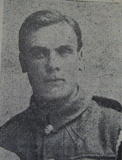
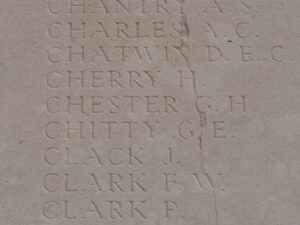
Alfred Chudley, Private, 7248, Devonshire Regiment. Alfred was born at Morchard Bishop, Devon, the son of John and Mary Chudley. He was the husband of Ann Stentiford. Alfred had served for several years in the Militia prior to the war, and had fought in the Boer War before leaving the army and moving to Llanelli in 1907. He re-enlisted there into the 2nd Battalion, Devonshire Regiment, which was attached to 23 Brigade, 8th Division. The 8th Division was formed during October 1914, by the bringing together of regular army units from various points around the British Empire. The Division moved to the Western Front in November 1914, a badly-needed reinforcement to the BEF which had been all but wiped out at Ypres. Alfred was killed at Ypres on 18 December 1914, aged 33. He is commemorated on the Le Touret Memorial, Richebourg L’Avoue, France.
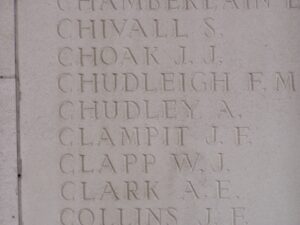
Cecil John Clark, Lance Corporal, 39436, Welsh Regiment. Cecil was the son of John and Albina Elizabeth Clark, of 111, Devon Road, Lower Easton, Easton, Bristol. He resided at Pontyates prior to the war and enlisted at Llanelli into the Welsh Regiment. Cecil landed in France on 21 December 1915, joining the 2nd Battalion, Welsh Regiment which was attached to 3 Brigade, 1st Division. The Division was still at Loos, and moved to the Somme in mid 1916. Cecil was killed, during the Battle of Pozieres, on 26 July 1916, aged 19. He has no known grave, and is commemorated on the Thiepval Memorial, France. His brother Sidney Herbert Clark also fell, and is commemorated at Pontyates.
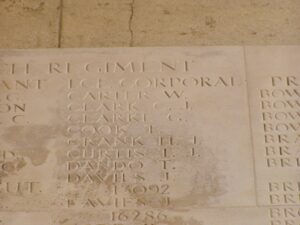
John Henry Clarke, Private, 202945, South Lancashire Regiment. John was the son of Henry Albert Clarke and Emily Clarke, of 14, Christopher Street, Llanelli. He enlisted at Cardiff into the army, and was posted to the 2/4th Battalion, South Lancashire Regiment, which was attached to 172 Brigade, 57th (2nd West Lancs) Division. The Division moved to France between 7 and 22 February 1917, and moved to positions near Ypres, where they took part in the Second Battle of Passchendaele. In 1918 they took part in the 1918 Battle of the Scarpe, and at the Battle of Drocourt-Queant. They fought on the Hindenburg Line during the Battle of the Canal du Nord, and it was here that John was wounded. He died on 28 September 1918, aged 28, and is buried at Beaumetz Cross Roads Cemetery, France.
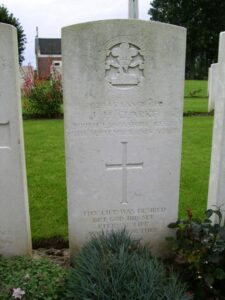
Michael Codd, Private, 6621, Royal Munster Fusiliers. Michael was the son of Nicholas Codd, of Milehouse, Enniscorthy, Co. Wexford. He worked at Llanelli prior to the war, and enlisted there into the army. Michael was posted to the 2nd Battalion, Royal Munster Fusiliers, which landed in France on 14 August 1914, taking part in the retreat from Mons to Le Cateau over the coming weeks. On 9 November 1914 the battalion transferred to 3 Brigade, 1st Division, and fought at the First Battle of Ypres, where the German drive to the Channel was halted. The following year saw them in action again at the Battle of Aubers, before moving South to Loos, where they fought during the Battle of Loos, and the action at the Hohenzollern redoubt. Again they were required for a major offensive, moving south to the Somme, where they fought during the opening of the Somme Offensive at the Battle of Albert, then at Bazentin, Pozières, Flers-Courcelette and Morval. They followed the German retreat to the Hindenburg Line in early 1917, and were then briefed for an operation on the Flanders Coast, and moved there during the summer of 1917. While training on the coast, the Battle of Third Ypres had stalled in the mire, and the Division were recalled to Ypres, where they fought at the Second Battle of Passchendaele. Michael was killed here on 10 November 1917. He was 39 years old, and is commemorated on the Tyne Cot Memorial, Belgium.
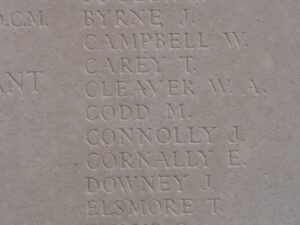
Abraham Cohen, Private, 14347, Welsh Regiment. Abraham was born at Leeds. He resided at Llanelli prior to the war, and enlisted there into the 2nd Battalion, Welsh Regiment, which was attached to 3 Brigade, 1st Division. Abraham survived the war, but died of wounds in Hospital in Leeds on 6 March 1919. He is buried at Leeds Jewish Cemetery, Yorkshire.
Victor James Cole, MSM, Acting Lance Corporal, WR/178798, Royal Engineers. Victor was the son of George and Elizabeth Cole, and the husband of Margaret Cole, of 5, Dolan Road, New Dock, Llanelli. He enlisted at Carmarthen into the Pembroke Yeomanry in November 1914, and later transferred into the Railways Division, Royal Engineers in February 1917. The RE Railway workers served on the Western Front throughout the whole of the war, often in close proximity to the front. Victor was awarded the Meritorious Service Medal at some time here, but was wounded on 2 September 1918 and came home for treatment at the 53rd General Hospital, Bagthorpe. He sadly died of wounds on 27 September 1918, aged 28, and was buried at Box Cemetery, Llanelli.
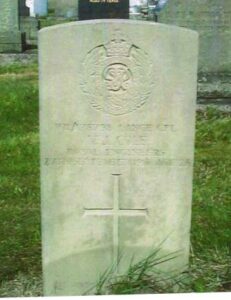
William Coleman, MM, Sergeant, 4947, Machine Gun Corps. William was the Adopted son of William and Esther Carpenter, Fruiterers, of Church Street, Llanelli. He married Sarah Jane Jones on 28 October 1911, and the couple lived with their two children, at 8, Ford Road, Velindre, Port Talbot. William enlisted on 11 January 1915 into the 15th Battalion, Welsh Regiment, known as the Carmarthen Pals battalion, but later transferred into the 62nd Company, Machine Gun Corps, which was attached to the 21st Division. The Division crossed to France during September 1915, and saw its first action at the Battle of Loos. They moved to the Somme in 1916, and fought at the Battle of Albert. William was killed on the Somme on 13 July 1916. He was 28 years old, and is commemorated on the Thiepval Memorial, France. William had been awarded the Military Medal for bravery prior to his death.
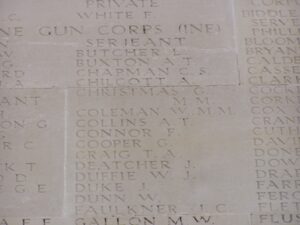
Harry Collins, Private, 266145, West Yorkshire Regiment. Harry had enlisted at Leeds into the 2/7th Battalion, West Yorkshire Regiment, which was attached to 185 Brigade, 62nd (2nd West Riding) Division. The Division concentrated on the Western Front by 18 January 1917, and took part in Operations on the Ancre. In March 1917 the Division followed the German Retreat to the Hindenburg Line, and then fought at the Battle of Arras, during the Flanking Operations Round Bullecourt. Harry was killed here on 12 May 1917, and is commemorated on the Arras Memorial, France.
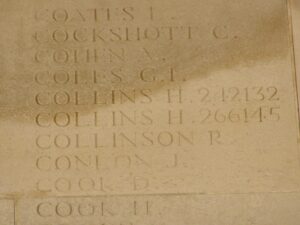
Rees Connick, Stoker, K/53680, Royal Navy. Rees was born on 16 April 1892, the son of Thomas and Ann Connick, of 31, Mysydd Terrace, Landore, Swansea. He had resided at Llanelli prior to the war, working for the GWR, and enlisted into the Royal Navy. Rees served at HMS Vivid towards the end of the war. He took ill and died at Plymouth on 20 September 1918. He was 26 years old, and is buried at Swansea (Cwmgelly) Cemetery.
Michael John Connolly, Bombardier, 65837, Royal Horse Artillery. Michael was the son of Mrs. A. M. Connolly, of 8, Council Houses, Fair Oak. He resided at Llanelli prior to the war, and enlisted at Winchester into the Royal Horse Artillery. Michael served with E Battery, RHA, which was attached to the 5th Cavalry Brigade, 1st Cavalry Division. He survived the war, but died of wounds in hospital on 9 February 1919. He was 29 years old, and is buried at Fair Oak (St. Thomas) Churchyard.
Thomas Coonan, MM, Guardsman, 76, Guards Machine Gun Regiment. Thomas was the son of William and Margaret Coonan, of O’Gonnelloe, Killaloe, Co. Clare. He worked at Llanelli prior to the war, and enlisted there into the Grenadier Guards. Thomas was transferred into the 4th Battalion, Guards Machine Gun Regiment, which was formed on 1 March 1918, attached to the Guards Division. Thomas was killed during the latter stages of the German offensive on the Somme, on 7 May 1918. He was 23 years old, and is buried at Gommecourt Wood New Cemetery, Fonquevillers, France. He was awarded the Military Medal for bravery on the Somme, which was published in the London Gazette of 11 October 1916.
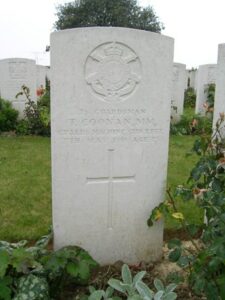
Fred Cooper, Private, 13380, Royal Welsh Fusiliers. Fred was the son of Moses and Myra Edith Cooper, of 41, New Dock Road, Llanelli. He enlisted at Birmingham into the 1st Battalion, Royal Welsh Fusiliers, which moved to France on 6 October 1914 attached to 22 Brigade, 7th Division. They fought during the First Battle of Ypres, and in March 1915 fought at the Battle of Neuve Chapelle. During May they fought at the Battle of Aubers Ridge, and at Festubert, before taking part in the Battle of Loos in September. In the summer of 1916, the Division were on the Somme, and took part in the Battle of Albert, where they captured Mametz, one of the few successes of 1 July 1916. They then fought at the Battle of Bazentin, and the Attacks on High Wood. Fred was killed during the Battle of Delville Wood, on 3 September 1916. He was 20 years old, and is commemorated on the Thiepval Memorial, France.
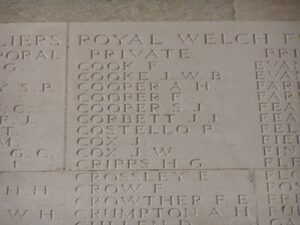
Thomas Coote, (alias Thomas Cook), Private, 16343, Welsh Regiment. Thomas was born at Birmingham, but resided at Llanelli prior to the war. He enlisted there under the name Thomas Cook, into the 8th Battalion, Welsh Regiment, the Pioneer Battalion to the 13th (Western) Division. On 13 June 1915 the Division sailed for Alexandria, and moved to Mudros before being landed at Cape Helles, Gallipoli from 6 July 1915, relieving the 29th Division. Thomas was killed during the Battle of Sari Bair, on 8 August 1915. He is commemorated on the Helles Memorial, Gallipoli.
Arthur Corbett, Private, 9668, Wiltshire Regiment. Arthur was born on 22 September 1894, the son of Henry and Marian Corbett, of 8, Albion Street, Swindon, Wilts. He worked at the Great Western railway Depot at Llanelli prior to the war, before returning home to enlist into the 2nd Battalion, Wiltshire Regiment. The battalion was attached to 21 Brigade, 7th Division, and on 7 October 1914 landed at Zeebrugge, before moving to positions east of Ypres. After helping stop the German drive towards the Channel Coast at Ypres, the Division moved south to Fleurbaix, and it was here, on 23 February 1915 that Arthur was killed. He was 20 years old, and is buried at Rue-David Military Cemetery, Fleurbaix, France. Arthur is not commemorated locally, but is named among the Llanelli staff on the GWR Memorial.
David John Coslett, Private, 15108, South Wales Borderers. David was born at Swansea in 1876, and for several years prior to the war had lived with his wife Elizabeth Ann Coslett, at 28, Waterloo Street, Llanelli. He had originally enlisted into the South Wales Borderers on 17 September 1896, and transferred to the army reserve in December 1905 after having served in India. He rejoined the South Wales Borderers in August 1914 at the start of the First World War. He arrived in France on 29 November 1914, and was wounded at the Battle of Loos at the end of September 1915, losing both of his legs due to machine gun fire. He died of his wounds in St Omer on 3 November 1915, aged 41, and is buried in Longuenesse Military Cemetery, France.
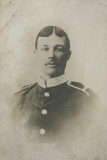
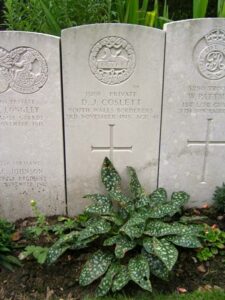
Stephen Charles Court, Private, 28606, Canadian Infantry. Stephen was born in Jersey on 10 September 1872, the son of Stephen and Mary Jane Court. His mother was from Llanelli, and by 1881 the family had moved back to her native town, while his father remained at sea with the Merchant Navy. Stephen married Emily Rees, of 16, Ropewalk Road, Llanelli on 26 September 1903, and the couple had three children. Stephen had served for six years with the Royal Marines, before going to Canada, where he enlisted into the 16th Battalion (Manitoba), Canadian Infantry, at Valcartier, on 23 September 1914. The battalion moved to France attached to the 3rd Brigade, 1st Canadian Division, and took up positions around Ypres. Stephen was killed here on 4 September 1915. He was 45 years old, and was buried at La Plus Douve Farm Cemetery, Belgium.
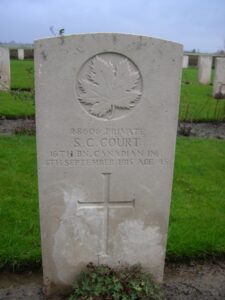
David James Crawford, Private, 46155, Welsh Regiment. David was the son of James and Sarah Crawford, of Castlefield, Station Road, Llanelli. He enlisted into the army at Llanelli, and was posted to the 1/5th Battalion, Welsh Regiment, which was attached to 159 Brigade, 53rd (Welsh) Division, in Palestine. David embarked at Marseilles on 3 May 1917 aboard the troopship RMS Transylvania, which was bound for Alexandria, carrying around 3,000 troops. On 4 May 1917, she was struck in the port engine room by a torpedo fired by the German submarine U-63. While the troops were transferring to another ship, another torpedo struck Transylvania, sinking her, with the loss of ten crew members, 29 army officers and 373 soldiers. David was 22 years old, and is commemorated on the Savona Memorial, Italy.
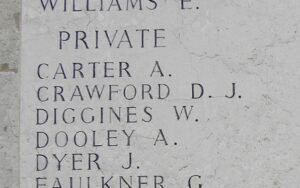
Charles Croxon, Private, 15734, Worcestershire Regiment. Charles was born at Tipsend, Cambridge, and worked at Llanelli prior to the war. He enlisted there into the army. He was posted to the 9th Battalion, Worcestershire Regiment, which was attached to 39 Brigade, 13th (Western) Division. On 13 June 1915 the Division sailed for Alexandria, and moved to Mudros before being landed at Cape Helles, Gallipoli from 6 July 1915, relieving the 29th Division. Charles was wounded at Gallipoli, and evacuated to hospital at Malta, where he died of his wounds on 17 September 1915. He is buried at Pieta Military Cemetery, Malta.
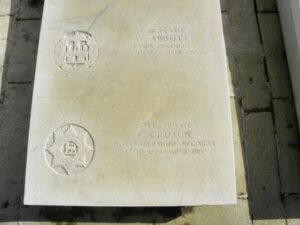
William George Crumpler, Private, 10727, Devonshire Regiment. William was born at Wareham, Dorset in 1884. He worked as a Painter at Llanelli prior to the war, and enlisted there on 1 September 1914 into the 6th Battalion, Devonshire Regiment, which was a Reserve Battalion. William was posted to France on 18 July 1915. He soon became ill, and died of dysentery at 16 General Hospital, France on 14 September 1915, aged 34. He is buried at Le Treport Military Cemetery, France.
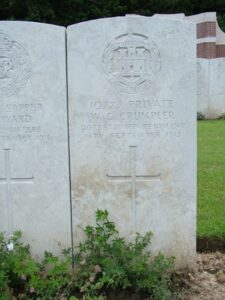
John Daley, Private, 291149, Royal Welsh Fusiliers. John was the son of Henry and Ann Daley of Portmadoc. He was the husband of Margaret Ann Daley (formerly Price), of 27, Florence Street, Llanelli. John enlisted at Harlech on 16 September 1915 into the 1/7th Battalion, Royal Welsh Fusiliers, which was the Merioneth and Montgomery battalion, attached to 158 Brigade, 53rd (Welsh) Division. The Division sailed from Devonport in July 1915, and arrived at Mudros on 5 August 1915. From here they moved to Gallipoli, landing on 9 August 1915. Here the Division was immediately thrown into action, and spent the next few days in isolated pockets, fighting against a Turkish counter-attack during the Battle of Sari Bair, then the ensuing Attack on Scimitar Hill. The Division remained here throughout the coming months, and suffered severe losses in manpower strength during the great November 1915 blizzard on Gallipoli, when its total strength was reduced to less than that of a full-strength Brigade. On 11 December 1915 the Division was evacuated to Mudros, and by 23 December 1915 were moved to Egypt. They remained on the Suez Canal Defences for the next twelve months, and in early 1917 moved into Palestine, where they remained for the duration of the war, fighting at the Battles of Gaza, and successfully capturing Jerusalem. John was killed at the Third Battle of Gaza on 6 November 1917. He was 27 years old, and is commemorated on the Jerusalem Memorial, Israel.
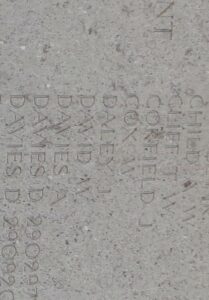
David Daniels, Private, 3867, Welsh Regiment. David was the son of Benjamin and Ann Daniels, of 9, Box Terrace, Llanelli. He enlisted at Llanelli into the 1/4th Battalion, Welsh Regiment, which was the local Territorial Battalion, attached to 159 Brigade, 53rd (Welsh) Division. The Division landed at Cape Helles, Gallipoli, on 9 August 1915, and was immediately thrown into action, spending the next few days in isolated pockets, fighting against a Turkish counter-attack during the Battle of Sari Bair. David was wounded during the latter stages of the campaign at Gallipoli, and died on 10 December 1915 aboard a Hospital Ship, aged just 19. He was buried at sea, so is commemorated on the Helles Memorial, Gallipoli.
William Daniels, Private, Welsh Horse. William is mentioned in an article in the Llanelli Mercury, as residing at 9, Box Terrace, Llanelli, and serving with the 4th Battalion, Welsh Horse, when he was killed at Gallipoli. There was no such unit at Gallipoli, only the 1/1st Welsh Horse, so William cannot presently be identified, especially as a Davies family lived at that address in 1911.
Horace Norman Dash, Private, 20480, Welsh Regiment. Horace was born at Wood Green, Middlesex on 13 March 1895, the son of Edmund John Dash and Rosa Belle Dash. He had moved to Llanelli by 1911. He enlisted at Llanelli in February 1915 into the 15th Battalion, Welsh Regiment, which was known as the Carmarthen Pals battalion. Horace was transferred at some time to the 13th Battalion, Welsh Regiment, which was attached to 114 Brigade, 38th (Welsh) Division. Horace probably fought at Mametz Wood with the Division, before being sent back to England sick. He died on 5 April 1917, aged 21, and is buried at St. Pancras Cemetery, England.
Thomas H Davey, Private, 12270, Royal Welsh Fusiliers. Thomas was the son of Sarah Rees, of Whitstable Inn, Llanelli. He served with the Royal Welsh Fusiliers, landing in the Balkans on 9 July 1915. No more can presently be traced of Thomas.
O. G. David, Private, Welsh. This man cannot presently be identified, but may be Gomer O. David, who served with the 24th Battalion, Welsh Regiment.
William Gordon David, Private, 36364, Welsh Regiment. William was the son of John and Mary Jane David, of 54, Bryn Road, Llanelli. He enlisted there into the South Wales Borderers. William later transferred into the 1st Battalion, Welsh Regiment, which was attached to 84 Brigade, 28th Division. The Division formed in England between December 1914 and January 1915 from regular units returning from India, Singapore and Egypt. During January 1915 it moved to France, landing at Le Havre and moved to the Western Front, where it saw its first major action during the Second Battle of Ypres. The Division suffered heavy casualties, and rebuilt before taking part in the Battle of Loos. William was killed at Loos on 2 October 1915, aged 27. He is commemorated on the Loos Memorial, France.
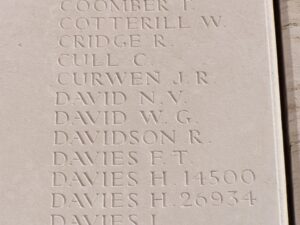
Albert George Davies, Sapper, 158410, Royal Engineers. Albert was the son of William and Jane Davies, of Llanelli, and the husband of Caroline Matilda Davies, of 72, Andrew Street, Llanelli. He worked as a haulier at Pwll Colliery prior to enlisting at Llanelli into the Royal Engineers, and was sent to France, where he joined the 176th Tunnelling Company, Royal Engineers. Albert was killed while the Company was stationed in the Vimy sector, on 15 March 1918. He is buried at St. Nicolas British Cemetery, France.
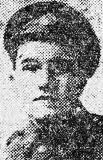
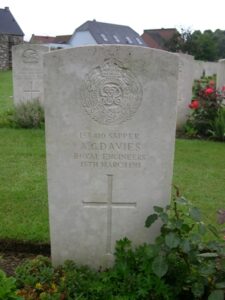
Benjamin Davies, Private, 13095, Welsh Regiment. Benjamin was the son of David and Esther Davies, of 41, Stanley Street, Senghenydd. The family moved to 4, Thomas Terrace, Pwll prior to the war, and Benjamin worked as a traction engine driver at Llandefeilog. Benjamin enlisted at Carmarthen into the 2nd Battalion, Welsh Regiment, which moved to France at the outbreak of war, attached to 3 Brigade, 1st Division. The Division took part in the retreat from Mons to the Marne, before moving to Ypres, where they famously helped stop the German advance on the ancient city. They remained in the area over the winter, before moving to the Neuve Chapelle sector. Benjamin was killed here on 25 May 1915, aged 21. He is commemorated on the Le Touret Memorial, Richebourg L’Avoue, France.
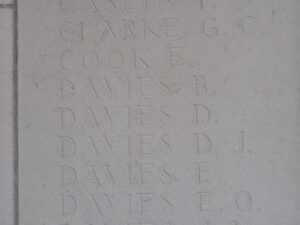
Benjamin Davies, Private, R2776, King’s Royal Rifle Corps. Benjamin was the son of Daniel and Jane Davies, of 41, Hoskin Terrace, Cwmbwrla, Swansea. He resided at Llanelli prior to the war, working as a tinsmith, and enlisted there into the army. Benjamin was posted to the 12th Battalion, King’s Royal Rifle Corps, which was attached to 60 Brigade, 20th (Light) Division. On 26 July 1915 the Division completed concentration in the Saint-Omer area, and moved to the Fleurbaix Sector for trench familiarisation and training. When the Battle of Loos was launched on 25 September 1915 the Division fought a diversionary attack towards Fromelles. Later that year they moved north, and fought at the Battle of Mount Sorrel alongside the Canadian Corps. Benjamin was killed here on 12 February 1916. He was 23 years old, and is commemorated on the Ypres (Menin Gate) Memorial, Belgium.
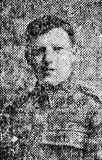
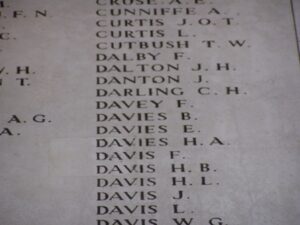
Benjamin Daniel Rowland Davies, Second Lieutenant, Royal Air Force. Benjamin was the son of David and Hannah Davies, of 13, Roch Terrace, Swansea. He was employed at the Capital and Counties Bank at Oswestry prior to the war. Benjamin originally enlisted into the 26th Battalion, Royal Fusiliers, and had served in the ranks in France before being wounded. He was commissioned on 28 August 1917, and possibly served with the Royal Welsh Fusiliers, before volunteering for pilot training, and transferred to the Royal Flying Corps. Benjamin was training at Grantham when his aircraft nose-dived into the ground on 11 March 1918, killing him instantly. He was 23 years old, and his body was brought back to Morriston, where he was buried with full military honours at Horeb Congregational Chapelyard. Benjamin is commemorated on a special memorial at Cwmgelly Cemetery, Swansea.
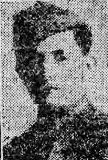
C. Davies, Sapper, Royal Engineers. This man cannot presently be identified.
Cadwalader Davies, Private, 201586, South Wales Borderers. Cadwallader had been born at Lampeter, the son of John and Hannah Davies, who later moved their family to Llanelli. He enlisted at Brecon into the 6th Battalion, South Wales Borderers, which was the Pioneer Battalion to the 25th Division. The Division moved to France in September 1915 and took the line at Vimy Ridge. It fought on the Somme in 1916, and at Messines and Pilckem in 1917. It was used to plug a gap in the line near Arras during the German Offensive of March 1918 before being moved to positions near Ploegsteert, where it faced the German Offensive on the Lys in April 1918. After suffering heavy losses, the Division moved to Soissons to rest, but were hit by another German offensive there in May. Now decimated, the Division returned to England to rebuild, before moving back to France at the end of August 1918. Cadwallader was wounded soon after, and died of his wounds on 27 August 1918 aged 22. He is buried at Terlincthun British Cemetery, Wimille, France, in Grave II.E.19.
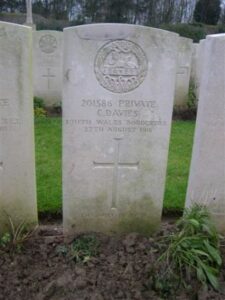
Clifford Davies, Private, 14733, Royal Welsh Fusiliers. Clifford was the son of Edwin Thomas Davies and Sarah Ann Davies, of 29, Mausel Street, Llanelli. He enlisted at Llanelli into the 8th Battalion, Royal Welsh Fusiliers, which was attached to 40 Brigade, 13th (Western) Division. In July 1915 the Division landed at Mudros, then moved to the Gallipoli peninsula. After evacuation in January 1916, the Division was sent to Egypt, before heading through Suez on 14 February 1916, arriving at Basra on 28 February 1916. The 8th RWF was then involved in the bitter campaign against the Turkish army in Mesopotamia. The Battalion fought on throughout April 1916, pushing the Turks back through Falahiyeh, Sannaiyat, Beit Aieesa and Abu Roman Mounds. They fought here for the remainder of the war, but Clifford took ill, and was sent to a Hospital in India, where he died on 25 September 1918, aged 21. Clifford is commemorated on the Kirkee Memorial, Poona, India.
D. J. Davies, Private, South Wales Borderers. This man cannot presently be identified.
Dan Davies, Captain, Welsh Regiment. Dan was the son of Herbert and Mary Davies, of Llanelli, and the husband of Ellen Ann Davies, of 4, Tulloch Street, Roath Park, Cardiff. He enlisted into the King’s Royal Rifle Corps at the outbreak of war, and was quickly promoted to sergeant, before being commissioned into the 10th Battalion, Welsh Regiment. The battalion was attached to 114 Brigade, 38th (Welsh) Division, and had landed in France in December 1915. Dan survived the attack on Mametz Wood the following year, and also took part in the Battle of Pilckem Ridge on 31 July 1917. He was badly wounded near Langemarck on 10 September 1917, and died that same day, aged 42. Dan is buried in Bard Cottage Cemetery, Belgium.

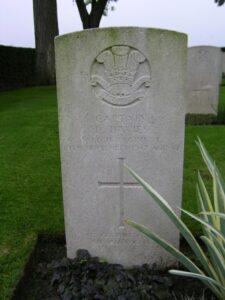
Daniel Davies, Private, 13369, Royal Welsh Fusiliers. Daniel was the son of Thomas and Mary Davies of the Grist, Laugharne. He had worked at Llanelli for several years prior to the war, and was married with six children. Daniel enlisted at Llanelli into the 8th (Service) Battalion, Royal Welsh Fusiliers, which was attached to 40 Brigade, 13th (Wetsern) Division. In July 1915 the Division landed at Mudros, then moved to the Gallipoli peninsula. Daniel landed on Gallipoli on 15 October 1915, as part of a batch of reinforcements. In January 1916 the 8th RWF were sent to Egypt, before heading through Suez on 14 February 1916, arriving at Basra on 28 February 1916. The 8th RWF was then involved in the bitter campaign against the Turkish army in Mesopotamia. The Battalion fought on throughout April 1916, pushing the Turks back through Falahiyeh, Sannaiyat, Beit Aieesa and Abu Roman Mounds. They were hit by savage Turkish counter-attacks, but held on, before being replaced in the front line on 28 April and moving to a rest camp. The Battalion were then entrenched in Beit Aieesa. At some time during this period, Daniel was shot in the back by a German sniper, and was sent to a Hospital in India. There he was operated on, having the bullet successfully removed, but succumbed to his wounds on 10 May 1916. Daniel is commemorated on the Kirkee Memorial, Poona, India.
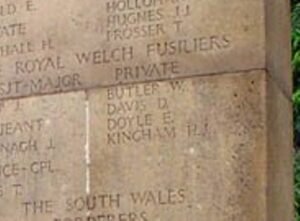
Daniel Davies, Private, 1671, Welsh Regiment. Daniel was the son of Mrs Jenkins, of 10, Thomas Street, Llanelli. He was a reservist with the 3rd Welsh prior to the war, and upon the outbreak of war went to France with the 2nd Battalion, Welsh Regiment, which was attached to 3 Brigade, 1st Division. The Division took part in the retreat from Mons to the Marne, before being moved to Ypres, where the 2nd Welsh gained fame in their historic stand at Gheluveldt. They moved to the Cuinchy sector afterwards, and it was there, during the Affair of Cuinchy, that Daniel was killed on 30 January 1915. He was 24 years old, and is commemorated on the Le Touret Memorial, Richebourg L’Avoue, France.
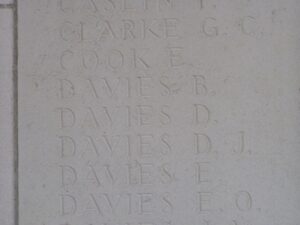
Daniel Stanley Davies, Private, 126137, Machine Gun Corps. Daniel was born in 1896, the son of David and Catherine Davies, of 21, Ann Street, Llanelli. He married Harriet Ann Rees in 1914, and resided with his wife and children at 7, Cross Road, Union Buildings, Llanelli prior to the war. Daniel had originally served with the 4th Welsh before being posted to the 50th Battalion, Machine Gun Corps, which was attached to the 50th (Northumbrian) Division. It moved to France 16 April 1915, and took part in the Second Battle of Ypres from April to June 1915. During the summer of 1916 the Division fought on the Somme. After spending a winter on the Somme, they took part in the Arras Offensive of April 1917, before being sent north to Ypres, were they fought at the Second Battle of Passchendaele, and remained here for the winter. During March 1918 they were stationed near St. Quentin, and were hit here by the German Spring Offensive of 21 March 1918. After suffering terrible casualties, the Division moved north to Flanders to rest and rebuild, but in April the Germans launched an attack in Flanders, around the Lys, and the Division took part in heavy fighting again. The Division was withdrawn and sent to the Aisne, believed to be a much quieter area, but was hit hard by a surprise enemy attack, and took heavy casualties again. Daniel was killed on the Aisne on 29 May 1918, aged 24. He is buried at La Ville-Aux-Bois British Cemetery, France. Daniel was a brother-in-law to Ivor Rees, VC, the Llanelli war hero.
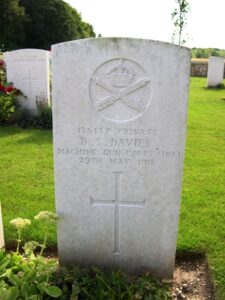
David Davies, Sapper, 790, Royal Engineers. David was the husband of Gwen Davies, of 7, Water Street, Llanelli, and had served for five years with the 1st Volunteer Battalion, Welsh Regiment prior to the war. He enlisted at Llanelli into the 3/1st Welsh Field Company, Royal Engineers on 10 May 1915. David remained on home service until 27 September 1916, when he was discharged as permanently unfit for service. Nothing else can presently be traced about him, but he possibly died in 1920, aged 33.
David Davies, Gunner, 82072, Royal Field Artillery. David was the son of David and Margaret Davies, of Inkerman Street, Llanelli. He enlisted at Llanelli into the Royal Artillery, and was posted to D Battery, 62nd Brigade, Royal Field Artillery, which was attached to the 12th (Eastern) Division. The Division landed at Boulogne on 31 May 1915, and took over the line at Ploegsteert Wood. They then moved south and fought in the Battle of Loos, and the subsequent actions of the Hohenzollern Redoubt, and remained there until March 1916. By June they were in position at the Somme, and attacked Ovillers on 2 July 1916. They then fought at the later Battles of Pozieres and Le Transloy, and it was during the latter, that David was killed on 24 October 1916, aged 22. He has no known grave, and is commemorated on the Thiepval Memorial, France.
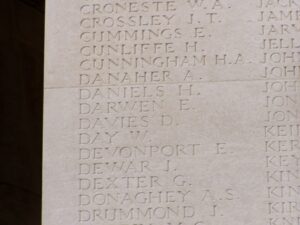
David Guy Davies, MC, Captain, King’s Royal Rifle Corps. David was commissioned into the King’s Royal Rifle Corps, and served with their 10th Battalion, which was attached to 59 Brigade, 20th (Light) Division. On 26 July 1915 the Division completed concentration in the Saint-Omer area, and moved to the Fleurbaix Sector for trench familiarisation and training. When the Battle of Loos was launched on 25 September 1915 the Division fought a diversionary attack towards Fromelles. Later that year they moved north, and fought at the Battle of Mount Sorrel alongside the Canadian Corps. They then fought through the Somme Offensive, at the Battles of Delville Wood, Guillemont, Flers-Courcelette, Morval and Le Transloy, and took part in the advance to the Hindenburg Line in March 1917. David was wounded on the Somme, then promoted Captain before being awarded the Military Cross. He was killed in action during an attack on Metz-en-Couture on 4 April 1917, and is buried at Gouzeaucourt New British Cemetery, France. The citation for his Military Cross read; ‘For conspicuous gallantry in action. On three occasions he went forward into our own barrage, and brought back some of his men who had pushed too far forward. Later, he re-organised his company to complete their task.’
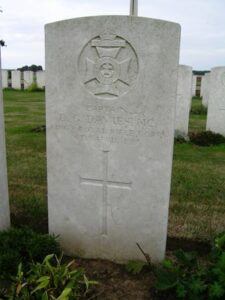
David John Davies, Private, 49411, South Wales Borderers. David was born at Llanelli, and enlisted there into the army. He was posted to France late in 1916, where he joined the 10th Battalion, South Wales Borderers. The battalion was attached to 115 Brigade, 38th (Welsh) Division, and had recently moved to Boesinghe after the capture Mametz Wood. During July and August 1917 the Division fought at Pilckem and Langemarck, before spending the winter around Armentieres. In April 1918 the Division moved back to the Somme, and from 21 August 1918 took part in the great 100 days offensive, driving the Germans back off the old Somme Battlefields towards the Hindenburg Line. David was killed during the Battle of Épehy, on 19 September 1918. He is buried at Gouzeaucourt New British Cemetery, France.
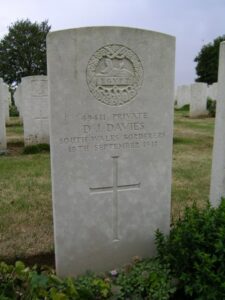
David Thomas Davies, Private, 315120, Tank Corps. David served during the war with the Tank Corps. Very little is presently known of him, but after the armistice he remained with the Tank Corps Training School in France. David died of influenza on 24 November 1918, and is buried at Etaples Military Cemetery, France.
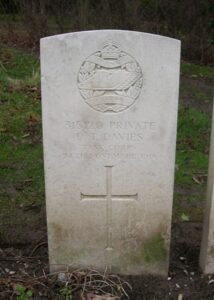
E. H. Davies, Sergeant, South Wales Borderers. This man cannot presently be identified.
Ernest Wilberforce Davies, Private, 49278, Royal Army Medical Corps. Ernest was the son of Thomas Rhys Davies and Margaret Davies, of Compton House, Vaughan Street, Llanelli. Educated at Llandovery from 1909 to 1912, Ernest entered St. David’s College, Lampeter, where he was studying at the time when he volunteered for military service, enlisting into the Royal Army Medical Corps at Llanelli. Ernest sailed for the Mediterranean on 13 June 1915, and landed at Anzac Cove, Gallipoli, in early August, in preparation for the attack on Sari Bair. His Field Ambulance Unit established a Dressing Station at the crossroads near Aghyl Dere, and in the battle which followed, Ernest Davies died of wounds on 13 August 1915. He was 23 years old, and is commemorated on a Special Memorial at the 7th Field Ambulance Cemetery, Gallipoli.
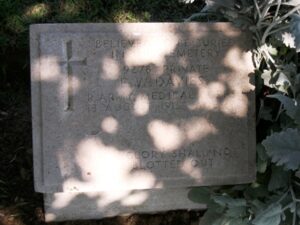
Evan Davies, Private, 202823, Oxfordshire and Buckinghamshire Light Infantry. Evan was the son of David and Mary Davies, of Rhoslwyn, Bridge Street, Llanddewi Brefi, Cardiganshire. He resided at Llanelli prior to the war, and enlisted there into the Welsh Regiment. He was later posted to France, where he joined the 2/4th Battalion, Ox and Bucks Light Infantry, which was attached to 184 Brigade, 61st (2nd South Midland) Division. The Division moved to the Western Front in May 1916, and took part in the disastrous assault on Fromelles on 19 July 1916. In March 1917 the Division followed the German retreat to the Hindenburg , and later that year fought at the Battle of Langemarck. The Division then moved south, and took part in the Battle of Cambrai. During March 1918 the Division was in the front line near Ham when it was hit by the German offensive of 21 March 1918. Evan was killed a day later, on 22 March 1918. He was 21 years old, and is buried at Ham British Cemetery, Muille-Villette, France.
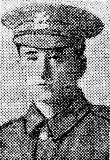
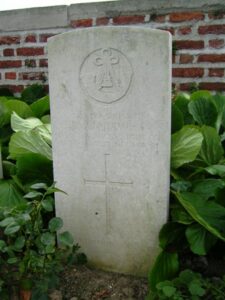
Evan Idwal Davies, Private, 57545, Welsh Regiment. Evan was the son of George and Elizabeth Davies, of 43, Brynmor Road, Llanelli. He enlisted into the Royal Welsh Fusiliers on 7 March 1917, and was posted to France on 11 April 1918, and he joined the 24th Battalion, Welsh Regiment in June 1918. The battalion had been formed in March 1917 from the merging of the Pembroke and Glamorgan Yeomanry, becoming attached to 231 Brigade, 74th (Yeomanry) Division, and had fought in Palestine until moving to France in May 1918. Evan was killed during the Battle of Epehy, on 21 September 1918, aged just 19. His grave was never located, so Evan is commemorated on the Vis-En-Artois Memorial, France. A Gunner Lee wrote to George and Elizabeth just after the war to say that he had seen Evan’s body lying in a shell hole, along with another Welshman.
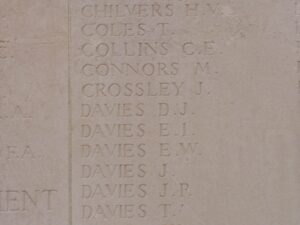
Evan John Davies, Private, 4162, Welsh Regiment. Evan was the son of David and Emma Davies, of 12, Caroline Street, Llanelli. He resided at Pontyberem prior to the war, and served with the 1/4th Battalion, Welsh Regiment, which was the local Territorial Battalion, attached to 159 Brigade, 53rd (Welsh) Division. The Division landed at Cape Helles, Gallipoli, on 9 August 1915, and was immediately thrown into action, spending the next few days in isolated pockets, fighting against a Turkish counter-attack during the Battle of Sari Bair, and then at the Attack on Scimitar Hill. Evan was killed here on 16 August 1915, aged 19. He is commemorated on the Helles Memorial, Gallipoli.
Evan John Davies, Private, 20739, Welsh Regiment. Evan was from Austin Cottage, Llanelli. He enlisted at Llanelli into the 15th Battalion, Welsh Regiment, which was known as the Carmarthen Pals battalion, attached to 114 Brigade, 38thg (Welsh) Division. On 2 December 1915 the battalion moved to France, and the entire Division moved to the Fleurbaix sector, where it was initiated into trench warfare. During June 1916 the Division marched south to the Somme, and on 7 July 1916 attacked Mametz Wood. The initial attack failed, and it was three days later, on 10 July, that a fresh attack was mounted. Evan was killed in the wood on 10 July 1916. He was just 17 years old, and is commemorated on the Thiepval Memorial, France.
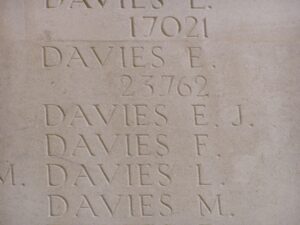
Evan Samuel Davies, Gunner, 141082, Royal Garrison Artillery. Evan was the son of Mr. Evan Davies, of 7, Delabecke Street, Llanelli. Evan worked as a shell filler in a munitions works prior to enlisting into the Royal Garrison Artillery on 28 February 1916, and was posted to France where he joined their 101st Siege Battery on 29 June 1917. Evan was wounded during the German offensive on the Lys, and died at 15 Casualty Clearing Station on 26 April 1918, aged 22. He is buried at Ebblinghem Military Cemetery, France.
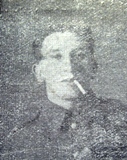
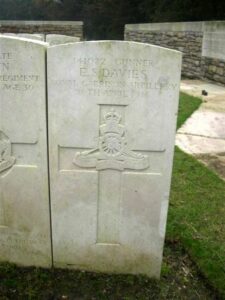
Frangcon Davies, Private, 41975, Welsh Regiment. Frangcon was the son of William and Elizabeth Davies, of Gwymbyrhaul, Beulah, Garth, Breconshire. He had resided at 1, Blaen y Morfa, New Dock, Llanelli prior to the war, and enlisted there into the army. Frangcon was posted to the 23rd Battalion, Welsh Regiment, which was the Pioneer Battalion to the 28th Division. The Division moved to France during January 1915, and saw its first major action during the Second Battle of Ypres. It fought at Loos in September that year, before entraining for Marseilles, where it sailed for Salonika. Frangcon was wounded at Salonika, and died on 5 October 1916. He was 20 years old, and is buried at Lahana Military Cemetery, Greece.
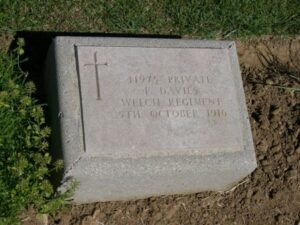
Frederick William Davies, Sergeant, 63129, Welsh Regiment. Frederick was the son of William and Hannah Davies, of 15, Bury Street, Seaside, Llanelli. He worked as a Tinplater prior to enlisting into the 4th Welsh on 26 October 1914. Frederick served at Gallipoli with the 1/4th Welsh, before transferring to the 11th Battalion, Welsh Regiment in February 1917. The battalion was in Salonika attached to 67 Brigade, 22nd Division. Frederick was killed during the Battle of Doiran on 18 September 1918. He was 25 years old, and is buried at Doiran Military Cemetery, Greece.
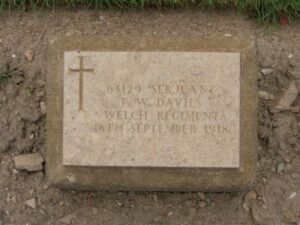
Frederick William Davies, Private, 11641, Welsh Regiment. Frederick was born at Llanelli, and resided at Nevill Street. He married Mary Annie Clement in the summer of 1914 and their daughter, Mary Zarifa Davies was born soon after. Frederick enlisted at Llanelli into the 8th Battalion, Welsh Regiment soon after the outbreak of war. The battalion was the Pioneer battalion to the 13th (Western) Division, which sailed for the Mediterranean on 13 June 1915. Between 6 and 16 July 1915 the Division landed on Cape Helles and relieved the 29th Division. They left and returned to Mudros at the end of the month, and the entire Division landed at ANZAC Cove from 3 August 1915, taking part in the Battles of Sari Bair, Russell’s Top, and Hill 60, ANZAC. Frederick was taken ill at Gallipoli, and evacuated to Egypt for treatment. He died of dysentery in hospital at Alexandria on 13 September 1915, and is buried in Alexandria (Chatby) Military & War Memorial Cemetery, Egypt.
Griffith Davies, Private, 64841, Welsh Regiment. Griffith was the son of William Griffith Davies and Catherine Davies, of Glandulyn, Abersoch, Carnarvonshire. He resided at 85, Bigyn Hill, Llanelli prior to the war, where he worked as a Draper. Griffith enlisted at Llanelli on 2 December 1915 into the Welsh Regiment. Griffith was posted to France on 5 May 1918, joining the 9th Battalion, Welsh Regiment, which was in France attached to 58 Brigade, 19th (Western) Division. The battalion had been decimated during heroic fighting during the German Spring offensive on the Somme, and on the Lys during the preceding months, and had been moved to the more peaceful Aisne sector to rebuild. Unfortunately the division was caught up in the German offensive on the Aisne, and saw heavy fighting again. Griffith was taken prisoner by the Germans on 30 May, and brought to Cassel POW Camp in Germany, where he died on 28 September 1918, aged 30. Griffith is buried at Niederzwehren Cemetery, Germany.
Gwilym Davies, Driver, 3203, Royal Field Artillery. Gwilym was the son of Jared and Catherine Davies, of 25, Union Buildings, Llanelli. He enlisted at Llanelli into the Royal Field Artillery, and was posted to France with ‘A’ Battery, 63rd Brigade, RFA, which was attached to the 12th (Eastern) Division. The Division landed at Boulogne on 31 May 1915, and took over the line at Ploegsteert Wood. They then moved south and fought in the Battle of Loos, and the subsequent actions of the Hohenzollern Redoubt, and remained there until March 1916. By June they were in position at the Somme, and attacked Ovillers on 2 July. They fought at Pozières and Le Transloy before being moved to the Arras area during October, 1916, where they fought in the March 1917 Battle of Arras, taking part in the First Battle of the Scarpe, and the Battle of Arleux. Gwilym died during the Battle of Arleux, on 13 May 1917, aged 26. He is buried at Duisans British Cemetery, Etrun, France.
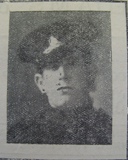
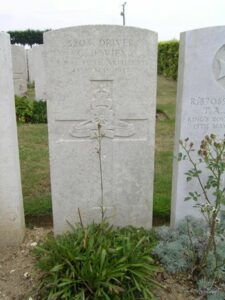
Gwilym Arthur Davies, Private, 658, Welsh Guards. Gwilym was the son of Arthur and Mary Davies, of Swansea Road, Llanelli. He had formerly served in the Grenadier Guards, before transferring to the 1st Battalion, Welsh Guards upon its formation in 1915, and moved to France with in August 1915 where the Welsh Guards joined 3 Guards Brigade, Guards Division. The new Division saw its first action at the Battle of Loos in September 1915, and fought in the area over the winter. It moved to the Somme in August 1916, and took part in the Battle of Flers-Courcelette. Gwilym was killed here on 10 September 1916, aged 23. He has no known grave, and is commemorated on the Thiepval Memorial, France.
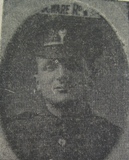
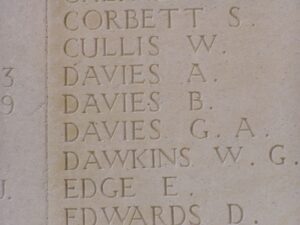
Henry Davies, Private, 27240, Welsh Regiment. Henry was born at Pyle, but resided at Llanelli prior to the war. He enlisted there into the army, and was posted to the 8th Battalion, Welsh Regiment, which was the Pioneer battalion to the 13th (Western) Division. On 13 June 1915 the Division sailed for Alexandria, and moved to Mudros before being landed at Cape Helles, Gallipoli from 6 July 1915, relieving the 29th Division. Henry was killed during the Battle of Sari Bair, on 8 August 1915. He is buried at The Farm Cemetery, Anzac, Gallipoli.
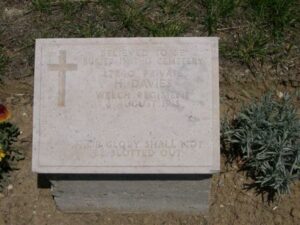
H. E. Davies, Corporal, Welsh Regiment. This man cannot presently be identified.
Howell John Davies, MM, Private, 14222, Royal Welsh Fusiliers. Howell was the son of John and Elizabeth Davies, of 3, Russell Street, Llanelli. He enlisted at Llanelli into the 9th Battalion, Royal Welsh Fusiliers, which moved to France in July 1915 attached to 58 Brigade, 19th (Western) Division. The Division saw its first action at Loos in September, and the following year fought on the Somme. In 1917 it fought at Messines, and at Third Ypres, and was back on the Somme early in 1918. They were caught up in the German Spring Offensive of 21 March 1918 near St. Quentin, where they suffered terrible casualties. They moved to Ypres, but were caught up in the German attack at Messines, and at Bailleul, and Kemmel. After suffering terribly again, they moved south to the quieter French sector to rebuild, but were caught up in the German offensive on the Aisne, and fought during the Battle of the Selle. Howell was wounded here, and died, aged 26, on 4 October 1918. He is buried at Bethune Town Cemetery, France. Howell was awarded the Military Medal for bravery in the field just prior to his death.
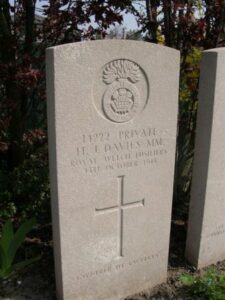
Hubert Davies, Private, 316108, Cheshire Regiment. Hubert was the son of Henry and Rachel Davies, of 17, Gilbert Place, Llanelli. He enlisted at Llanelli into the army, and was posted to the 16th Battalion, Cheshire Regiment, which was in France attached to 105 Brigade, 35th Division. The Division moved to France during February 1916, and saw its first major action during the Battle of the Somme. The Division then followed the German Retreat to the Hindenburg Line in March 1917. Later in the year they moved north to Ypres, and fought at the Battle of Passchendaele. Hubert was killed here on 22 October 1917. He was 19 years old, and is commemorated on the Tyne Cot Memorial, Belgium.
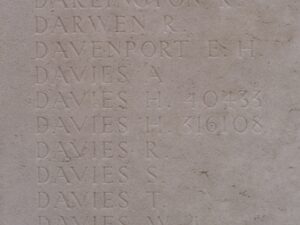
J. R. Davies, Corporal, Welsh Regiment. This man cannot presently be identified.
Jack Davies, Private, 203011, South Lancashire Regiment. Jack was the son of Daniel and Anne Davies, of Myrtle Hill Dairy, Llanelli. He enlisted at Llanelli into the army, and was posted to the 1/4th Battalion, South Lancashire Regiment, which was the Pioneer battalion to the 55th (West Lancashire) Division. The Division was formed in France during January 1916, and relieved the French 88th Division south of Arras. Relieved on 25 July, the Division moved south and took up a place in the front line opposite the village of Guillemont, fighting in the Somme offensive. Relieved on 28 September, the Division withdrew, before relieving the 29th Division at Ypres in October 1916. It remained in the Railway wood sector until taking part in the Third Battle of Ypres. Jack was killed on 6 November 1917 during the Second Battle of Passchendaele. He was 24 years old, and is buried at Poelcapelle British Cemetery, Belgium.
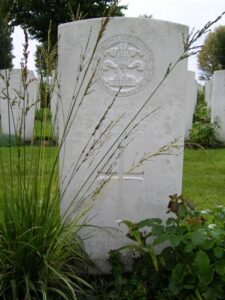
James Davies, MM, Lance Corporal, Deal/3477/S, Royal Marines. James was born at Port Talbot on 21 July 1886. Prior to the war he resided with his wife Elizabeth Davies, at Glyncelyn, Felinfoel. He enlisted on 9 February 1915 into the RM Medical Unit, and was posted to the 3rd (RN) Field Ambulance, Royal Naval Division. The division moved to Egypt preparatory to the Gallipoli campaign, and landed on 25 April 1915. After the evacuation of Gallipoli, the Division was transferred from the Admiralty to the War Office, and was redesignated the 63rd (Royal Naval) Division on 19 July 1916 after having moved to France in May 1916. The division moved to positions on the Somme, where it took part in the Battle of the Ancre, and the resulting Operations on the Ancre. In April 1917 the Division were at Arras, and fought at the Second Battle of the Scarpe, where they captured Gavrelle. They then fought at the Battle of Arleux, before moving north to Ypres, where they took part in the Second Battle of Passchendaele. Their next major action was at Cambrai, during the Action of Welch Ridge, and they were still in the area when the Germans launched their Spring Offensive, and fought at the Battle of St Quentin, and then the First Battle of Bapaume. In August, the Division took part in the Battle of Albert, which marked the beginning of the great offensive which was to end the war. They then fought at the Battle of Drocourt-Queant, the Battle of the Canal du Nord and the Battle of Cambrai, before forcing the Passage of the Grand Honelle. James sadly died of the influenza epidemic that swept through Europe at the end of the war, on 20 November 1918. He was 32 years old, and is buried at Etaples Military Cemetery, France. He had been awarded the Military Medal during the Somme Offensive for; ‘He displayed great courage and energy in removing patients from a position which was being heavily shelled to one of greater safety on 14 November 1916 near the River Ancre’.
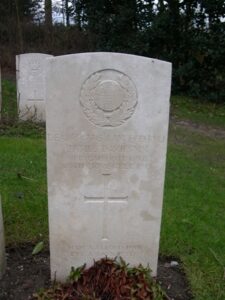
John Albert Davies, Air Mechanic 3rd Class, 215108, Royal Air Force. John was born at Llanelli on 23 October 1892, the son of Richard and Zillah Davies. The family later moved to Kent, where they took over the Mitre Hotel, Gravesend. John had served as an Air Mechanic with the Royal Naval Air Service, and when the RNAS was merged with the RFC to create the Royal Air Force, joined 66th Wing, RAF, which was in Italy. John became ill, and died of pneumonia on 1 December 1918. He was 27 years old, and is buried at Taranto Town Cemetery Extension, Italy.
John Edgar Davies, Private, 15250, Connaught Rangers. John was the son of William and Margaret Davies, of 5, Pennant Terrace, Llanelli. He enlisted at Marylebone into the Wiltshire Regiment, but was later posted to the 5th Battalion, Connaught Rangers, which was attached to 197 Brigade, 66th (2nd East Lancs) Division. The Division concentrated on the Western Front in March 1917 and moved to the Flanders Coast. At the end of September 1917 they moved to Ypres, and took part in the Battle of Poelcapelle. They then moved south to the Somme, and on 21 March 1918 were hit by the German Spring Offensive at the Battle of St Quentin, and moving back west fought at the Actions at the Somme Crossings, and the Battle of Rosieres. After suffering very heavy casualties during the Battles of the Somme in 1918, the Division was first reduced to a training cadre and then reformed and reconstituted, before taking part in the final offensive, fighting at the Battle of Cambrai, and the Pursuit to the Selle and the Battle of the Selle. John was wounded during the final days of the war, and died on 8 November 1918, aged 22. He is buried at Pont-Sur-Sambre Communal Cemetery, France.
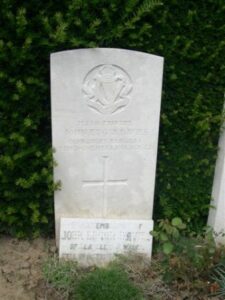
John Lewis Davies, Stoker 1st Class, SS/105269, Royal Naval Reserve. John was born at Llanelli on 19 September 1887, and was the husband of Maggie Davies, of 1, Pemberton Street, Llanelli. He was a Royal Naval Reservist at the outbreak of war, and was called up, joining Nelson Battalion, Royal Naval Division. The Naval Brigades were originally sent to Antwerp and Dunkirk in September and October 1914 to guard against invasion by the Germans. However Antwerp fell to the Germans soon after, and so many of the RND units were withdrawn to England. After a lengthy period of refit and training the Division moved to Egypt preparatory to the Gallipoli campaign. Landing on 25 April 1915, the Division fought throughout the Campaign on Gallipoli. John was killed during the Third Battle of Krithia, on 6 June 1915. He was 27 years old, and is commemorated on the Helles Memorial, Gallipoli.
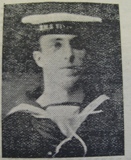
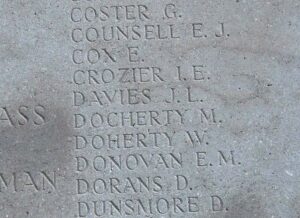
John Rees Davies, Private, 10111, South Wales Borderers. John was the son of William and Janet Davies, of 28, Mill Lane, Llanelli. He had enlisted around 1908 into the South Wales Borderers, and was with the 2nd Battalion at the outbreak of war. The battalion fought an action against a German garrison at Tientsin, China, before returning to England, where it joined 87 Brigade, 29th Division. The Division moved to Gallipoli via Egypt, landing on 25 April 1915. John was killed during the Second Battle of Krithia on 8 May 1915. He was 24 years old, and is commemorated on the Helles Memorial, Gallipoli.
Philip Davies, Private, 182, Welsh Horse. Philip was the son of William and Mary Davies, of 32, Wern Road, Llanelli. He had served for seven years with Royal Engineers previous to 1914, when he enlisted into the Welsh Horse Yeomanry, which formed in August 1914, joining the 1st Eastern Mounted Brigade. On 25 September 1915 the Welsh Horse was dismounted and the 1/1st Battalion sailed from Liverpool on SS Olympic for service at Gallipoli, landing at Anzac Cove on 10 October 1915. On 20 November 1915, Philip was one of a section of Welsh Horsemen working in a tunnel beneath the Turkish lines when the Turks blew a large mine, collapsing the workings. Philip was one of eight men buried when the mine blew that day. He was 29 years old, and is commemorated on the Helles Memorial, Gallipoli.
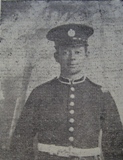
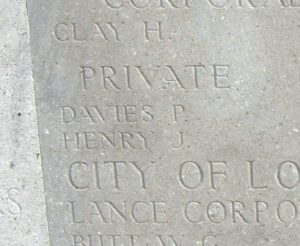
Philip Brynmor Davies, Private, 22836, Royal Welsh Fusiliers. Philip was the son of Richard and Catherine Davies, of The Emporium, Llanelli. He enlisted at Llanelli into the 15th Battalion, Royal Welsh Fusiliers, which was attached to 113 Brigade, 38th (Welsh) Division. On 2 December 1915 the battalion moved to France, and the entire Division moved to the Fleurbaix sector, where it was initiated into trench warfare. During June 1916 the Division marched south to the Somme, and on 7 July 1916 attacked Mametz Wood. The initial attack failed, and it was three days later, on 10 July, that a fresh attack was mounted. Philip was killed on 10 July 1916, aged 25. He is commemorated on the Thiepval Memorial, France.
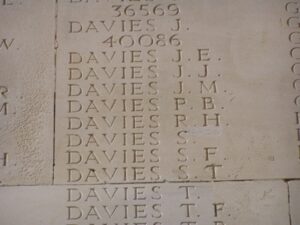
R. G. Davies, Private, Royal Welsh Fusiliers. This man cannot presently be identified.
Rees Davies, Private, 8275, Grenadier Guards. Rees was born on 14 August 1877, the son of Edwin and Ann Davies, of 8, George Street, Seaside, Llanelli. He had served with the 1st Volunteer Company, Welch regiment prior to enlisting in Cardiff into the 3rd Battalion, Grenadier Guards on 14 September 1899. Rees served with the Grenadier Guards in South Africa during the Boer War until returning home on 7 October 1902, and was still serving in August 1914 when war erupted. By then he had married Emily Mary Lanman, a domestic servant, at Llanelli on 20 February 1913, and Emily set up the family home at 20, Copperwork Road, Llanelli, where their two sons were born. Rees embarked for France with the Grenadier Guards on 4 November 1914, seeing action during the First Battle of Ypres. On 3 February 1915 Rees was invalided home after being wounded at Neuve Chapelle, and remained on home service until being discharged as medically unfit on 2 May 1917. He died on 4 May 1918, aged 41. Little else is presently known of him, as he is not commemorated by the CWGC, but further investigation is ongoing.
Richard Francis Davies, Private, 14139, South Wales Borderers. Richard was the son of David and Mary Ann Davies, of 10, Downing Street, Llanelli. He enlisted at Llanelli into the 5th Battalion, South Wales Borderers, which was attached to 58 Brigade, 19th (Western) Division. The Division crossed to France during July 1915, and moved to positions near Loos, where it took part in the opening attack of the Battle of Loos on 25 September 1915. The following year the Division moved to the Somme, where it took part in the second wave of the attack on Ovillers-La Boiselle on 1 July, capturing the village at heavy cost. It then fought through the Somme Battles of Pozieres and the Ancre in 1916. In 1917 the Division moved North to Ypres, taking part in the Battle of Messines, and fought on the Menin Road and at Polygon Wood, before moving up to Broodseinde, Poelcappelle and Passchendaele Village itself. In 1918 they were caught up in the German Spring Offensive near St. Quentin, where they suffered terrible casualties, and fought at the Battle of Bapaume. They moved to Ypres, but were caught up in the German attack at Messines, and it was here that Richard was killed on 12 April 1918. He was 26 years old, and is buried at Wulvergem-Lindenhoek Road Military Cemetery, Belgium.
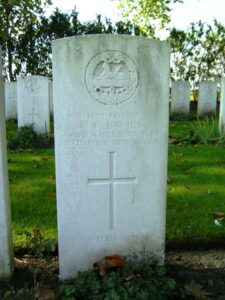
Robert Davies, Private, 14142, South Wales Borderers. Robert was the son of William and Catherine Davies, of 38, Island Place, Llanelli. Bob was a well known Llanelli rugby player, and enlisted at Llanelli into the 4th Battalion, South Wales Borderers. The battalion was attached to 40 Brigade, 13th (Western) Division, and landed at Gallipoli from 6 July 1915, at Cape Helles, relieving the 29th Division. They left and returned to Mudros at the end of the month, and the entire Division landed at ANZAC Cove between 3 and 5 August, 1915, taking part in the Battle of Sari Bair. Robert was killed here on 13 August 1915. He was 32 years old, and is buried at Hill 60 Cemetery, Gallipoli.
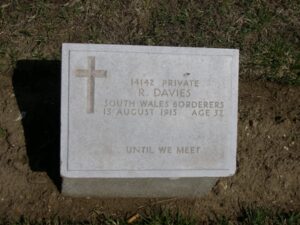
Robert Clifford Davies, Lance Corporal, 267414, Royal Warwickshire Regiment. Robert was the son of David and Ann Davies, of 8, Ralph Terrace, Llanelli. He had served with the 4th Welsh from September 1914, with the regimental number 5338, before being transferred to the 2/7th Battalion, Royal Warwickshire Regiment. Robert was posted as missing in action during the Battle of Fromelles on 19 July 1916. He was later found by a military enquiry to have been killed. Robert was 19 years old, and is commemorated on the Loos Memorial, France. He is possibly one of the men recently discovered in a mass grave at Fromelles.
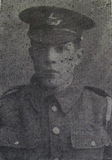
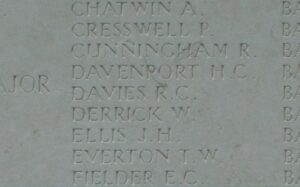
Robert Henry Davies, Private, 62306, Welsh Regiment. Robert was the son of James and Elizabeth Davies, of Westbourne Cottage, Tenby. He was a porter with the Great Western Railway prior to the war, and lived at Tyisha Road, Llanelli. He enlisted there on 12 December 1915 into the 4th Welsh, and was sent to France on 15 March 1918 where he joined the 15th Battalion, Welsh Regiment, which was the Carmarthen Pals battalion, attached to 114 Brigade, 38th (Welsh) Division. Robert would have joined the battalion just before it moved to the Somme in April 1918, and took part in the great offensive on the Somme from 21 August 1918. Robert was killed during the Battle of Cambrai on 8 October 1918, aged 25. He is buried at Moulin-De-Pierre British Cemetery, France.
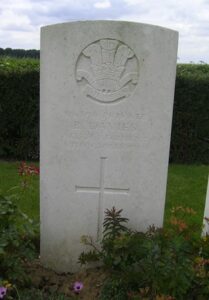
S. Davies, Corporal, Welsh Regiment. This man cannot presently be identified.
Samuel Davies, Gunner, 94468, Royal Garrison Artillery. Samuel was the son of Thomas and Mary Davies, of Wood Street, Lanesfield, Bilston. He lived with his wife, Blanche Davies, at Stafford Street, Llanelli. He enlisted on 9 December 1915 into the Royal Garrison Artillery and on 15 September 1916 was posted to France, joining the 170th Siege Battery, Royal Garrison Artillery. Samuel was mortally wounded during the Third Battle of the Scarpe, on 13 May 1917, and was invalided to hospital, dying that same day. Samuel is buried at Duisans British Cemetery, Etrun, France.
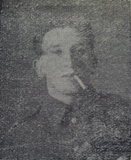
Stanley Davies, Seaman, Z/1679, Royal Naval Reserve. Stanley was born on 21 January 1892, probably the son of Thomas and Mary Davies, of 9, Forest Road, Llanedy. He was the husband of Minnie Davies, Sunny Cottage, Gowerton. Stanley was a Tinworker at Llanelli prior to enlisting on 26 July 1915 into the Royal Naval Reserve, and was posted to the Mediterranean on 5 December 1915, joining Howe Battalion, RND. On 10 January 1916 he was posted to Anson Battalion, which was attached to 189 Brigade, 63rd (Royal Naval) Division, and fought on the Somme with the Division later that year. In April 1917 the Division was at Arras, and fought at the Second Battle of the Scarpe, where they captured Gavrelle. They then fought at the Battle of Arleux, before moving north to Ypres, where they took part in the Second Battle of Passchendaele. Their next major action was at Cambrai, during the Action of Welch Ridge, and they were still in the area when the Germans launched their Spring Offensive, and fought at the Battle of St Quentin, and then the First Battle of Bapaume. Stanley was shot in the head on 7 April 1918, and died of wounds in the 20th General Hospital on 10 April 1918. He was 26 years old, and is buried at Etaples Military Cemetery, France.
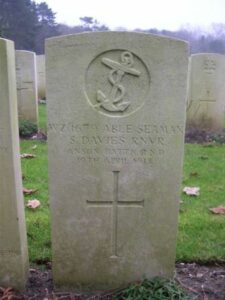
T. Davies, Private, Brecknocks. This man cannot presently be identified.
T. Davies, Sapper, Royal Engineers. This man cannot presently be identified.
Thomas Davies, Private, 260430, Gloucestershire Regiment. Thomas was the husband of Elizabeth M. Davies, of 43, Mansel Street, Llanelli. He enlisted at Llanelli into the army, and was posted to the 1/6th Battalion, Gloucestershire Regiment. The battalion had served in France and Italy with the 48th (South Midland) Division, and returned to France, where it joined 75 Brigade, 25th Division. Thomas was killed soon after, during the Battle of Albert, on 25 August 1918. He was 31 years old, and is buried at Gommecourt Wood New Cemetery, Fonquevillers, France.
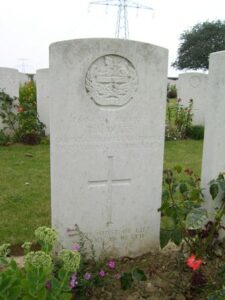
Thomas Davies, Private, 12159, Welsh Regiment. Thomas was the son of David and Esther Davies, of 4, Thomas Terrace, Pwll, Llanelli. He enlisted there into the 8th Battalion, Welsh Regiment, which was the Pioneer battalion to the 13th (Western) Division. On 13 June 1915 the Division sailed for Alexandria, and moved to Mudros before being landed at Cape Helles, Gallipoli from 6 July 1915, relieving the 29th Division. Thomas was killed here during the Battle of Sari Bair, on 8 August 1915. He was 19 years old, and is commemorated on the Helles Memorial, Gallipoli. His brother Benjamin also fell.
Thomas Davies, Private, Y/1871, King’s Royal Rifle Corps. Thomas was the son of Rees and Mary Davies, of 62, Brynmor Road, Llanelli. He enlisted in September 1914 into the 5th Battalion, King’s Royal Rifle Corps, and then transferred to their 11th Battalion, which was attached to 59 Brigade, 20th (Light) Division. The Division fought a diversionary attack at Fromelles on 25 September 1915. Later that year they moved north, and fought at the Battle of Mount Sorrel alongside the Canadian Corps. They then fought through the Somme Offensive, and took part in the advance to the Hindenburg Line in March 1917. Later that year they fought at Third Ypres, before moving south in November, to take part in the Battle of Cambrai. Thomas was wounded and taken prisoner during the Battle of Cambrai on 30 November 1917. He died in a German Hospital on 7 December 1917, aged 30, and is buried at Caudry British Cemetery, France.
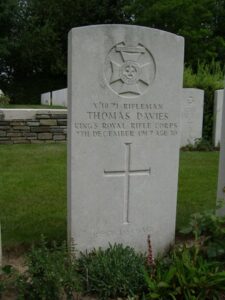
Thomas Davies, Private, 185, Welsh Guards. Thomas was the son of David and Margaret Jane Davies, of 8, Victoria Terrace, Sea Side, Llanelli. He was serving with the Grenadier Guards at the outbreak of war, before being one of several hundred men transferred to the newly formed Welsh Guards on 25 February 1915. The battalion moved to France in July 1915 attached to the 3rd Guards Brigade, Guards Division, and saw their first action during the Battle of Loos in September. Thomas was wounded during a short spell at Ypres in June 1916, and died on 3 July 1916, aged 22. He is buried at Lijssenthoek Military Cemetery, Belgium.
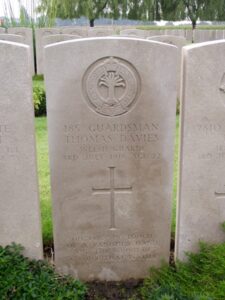
Thomas Dixon Davies, Sergeant, 3336, Welsh Regiment. Thomas was the son of James and Elizabeth Davies, of Llanelli. He had married in 1901, and lived with his wife Nancy Davies, at Stepney Place, Llanelli. Thomas enlisted at Llanelli into the 1/4th Battalion, Welsh Regiment, which was the local Territorial Battalion, attached to 159 Brigade, 53rd (Welsh) Division. The Division landed at Cape Helles, Gallipoli, on 9 August 1915, and was immediately thrown into action, spending the next few days in isolated pockets, fighting against a Turkish counter-attack during the Battle of Sari Bair. Thomas was wounded at Gallipoli, and evacuated to Hospital at Malta, where he died on 6 October 1915, aged 41. Thomas is buried at Pieta Military Cemetery, Malta.
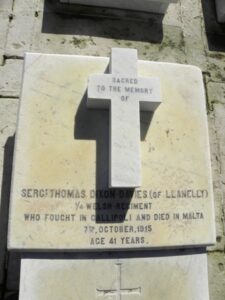
Thomas James Davies, Private, 1149, Welsh Guards. Thomas was born at Llanelli, and enlisted there into the 1st Battalion, Welsh Guards. The battalion moved to France in July 1915 attached to the 3rd Guards Brigade, Guards Division, and saw their first action during the Battle of Loos in September. In July 1916 the Division moved to the Somme, where they fought at the Battle of Flers-Courcelette. Thomas was killed here on 10 September 1916. He is buried at Delville Wood Cemetery, Longueval, France.
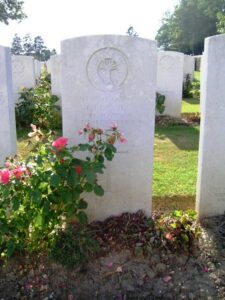
Thomas John Davies, Corporal, 21074, Welsh Regiment. Thomas was the son of Evan and Rachel Davies, of Ty Mawr, Llanddewi Brefi. He worked for the GWR and resided at Llanelli prior to the war. He enlisted there on 19 November 1914 into the 15th Battalion, Welsh Regiment, which was known as the Carmarthen Pals battalion, attached to 114 Brigade, 38th (Welsh) Division. On 2 December 1915 the battalion moved to France, and the entire Division moved to the Fleurbaix sector, where it was initiated into trench warfare. During June 1916 the Division marched south to the Somme, and on 7 July 1916 attacked Mametz Wood. The initial attack failed, and it was three days later, on 10 July, that a fresh attack was mounted. After two days of heavy hand to hand fighting within the wood, the Germans withdrew, leaving Mametz Wood in British hands. Thomas was killed in the wood on 11 July 1916, aged 24. He is commemorated on the Thiepval Memorial, France.
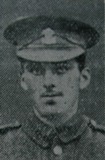
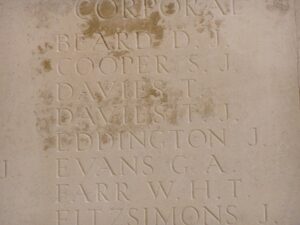
Thomas John Davies, Sapper, 448405, Royal Engineers. Thomas was born in Llanelli, and enlisted there into the Welsh Field Company, Royal Engineers. The company served at Gallipoli with the 53rd (Welsh) Division, before the division moved to Egypt, where the Welsh Field Company was renamed the 437th Field Company, RE, taking part in the advance into Palestine. Thomas became ill and died during the Final Offensive beyond the Jordan, on 23 October 1918. Thomas is buried at Gaza War Cemetery, Israel.
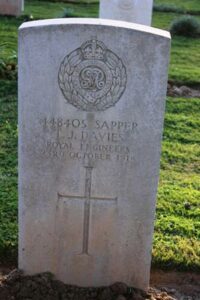
W. Davies, Private, Welsh Regiment. This man cannot presently be identified.
William Davies, Private, 18994, Royal Berkshire Regiment. William was born at Llanelli, and lived with his wife, Mary Davies, at Llwynypia at the outbreak of war. He enlisted at Tonypandy into the army, and was posted to the 8th Battalion, Royal Berkshire Regiment, which landed in France on 8 August 1915, becoming attached to 1 Brigade, 1st Division. The battalion saw its first major action during the Battle of Loos the following month. In 1916 the Division moved to the Somme, and it was during the Battle of Guillemont that William was killed on 18 August 1916. He was 26 years old, and is commemorated on the Thiepval Memorial, France.
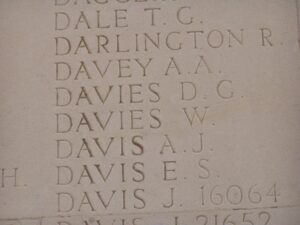
William Davies, Private, 16412, South Wales Borderers. William was the brother of Mrs. David Fisher, of 28, Mill Lane, Llanelli. He enlisted at Llanelli into the 6th Battalion, South Wales Borderers, which was the Pioneer Battalion to the 25th Division. The Division landed in France on 26 September 1915, and was posted to the Vimy area. They then moved to the Somme, and attacked on 3 July near Thiepval. They fought throughout the Battle of the Somme, and then moved to Ploegsteert, where they held the line for the months leading up the Battle of Messines in June 1917. After fighting at Messines, the Division moved north, and fought at Pilckem, before moving south again, where they took up positions around Bullecourt in reserve. William was wounded here by gunshot in the abdomen, and died at the 3rd Casualty Clearing Station on 25 January 1918. He was 24 years old, and is buried at Grevillers British Cemetery, Bapaume, France.
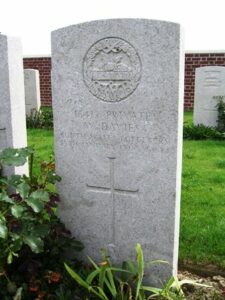
William David Davies, Private, 52657, Welsh Regiment. William was born on 12 June 1897, the son of Mary and the late John Davies, of Greencastle, Llanstephan Road, Carmarthen. He worked at Llanelli prior to the war and enlisted at Cardiff into the Welsh Regiment. William was posted to France, where he joined the 9th Battalion, Welsh Regiment, which was attached to 58 Brigade, 19th (Western) Division. William probably joined the battalion after the Somme battles of 1916. In 1917 the Division moved North to Ypres, taking part in the Battle of Messines, and fought on the Menin Road and at Polygon Wood, before moving up to Broodseinde, Poelcappelle and Passchendaele Village itself. In 1918 they were caught up in the German Spring Offensive near St. Quentin, where they suffered terrible casualties, and fought at the Battle of Bapaume. They moved to Ypres, but were caught up in the German attack at Messines, and fought a terrible rearguard action over the coming days. William was wounded around this time, and died on 25 April 1918, aged 21. He is buried at Etaples Military Cemetery, France.
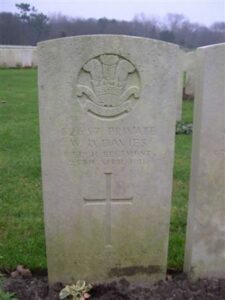
William Edwin Davies, Private, 28997, South Wales Borderers. William was the son of David Lloyd Davies, and Mary Ellen Davies, of 14 Pottery Road, Llanelli. He enlisted at Brecon into the 2nd Battalion, South Wales Borderers, which was attached to 87 Brigade, 29th Division. William joined the Division in France, where it was stationed near Beaumont Hamel. The Division took part in its first major action in France during the 1916 Somme Offensive, and fought at the Battles of Albert and Le Transloy, suffering heavy casualties. In the spring of 1917 they fought at the Battle of the Scarpe, which was part of the Arras Offensive, and then moved further north to Ypres. Here they fought at the Battle of Langemarck, and then at the Battles of the Menin Road, Polygon Wood, Broodseinde and Poelcappelle, before moving to Cambrai. Here they fought at the Battle of Cambrai. William was killed here on 3 December 1917. He was 26 years old, and is commemorated on the Cambrai Memorial, Louverval, France. Many thanks to Mervyn Lewis for the photograph of William.
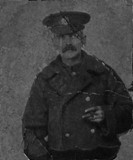
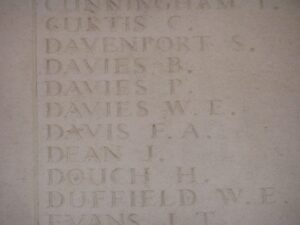
William Henry Davies, Private, 17991, Welsh Regiment. William was the son of Sophia Davies, of Garden Village, Gorseinon. He worked as a Steelworker at Llanelli prior to the war and enlisted at Swansea into the 14th Battalion, Welsh Regiment on 28 November 1914. The battalion moved to France on 2 December 1915 attached to 114 Brigade, 38th (Welsh) Division. The entire Division moved to the Fleurbaix sector, where it was initiated into trench warfare. During June 1916 the Division marched south to the Somme, and on 7 July 1916 attacked Mametz Wood. The initial attack failed, and it was three days later, on 10 July, that a fresh attack was mounted. William was killed in the wood on 10 July 1916, aged 34. He is commemorated on the Thiepval Memorial, France.
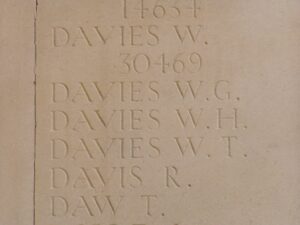
William Howard Davies, Private, 116422, Machine Gun Corps. William was the son of William and Elizabeth Davies, of Kidwelly. He lived at Llanelli prior to the war and enlisted at Pembrey into the 2nd Battalion, South Wales Borderers. William was later posted to the 21st Company, Machine Gun Corps which was attached to the 30th Division. William may have just caught up with the Division to serve in the Somme Offensive, and in March 1917 the Division followed the German retreat to the Hindenburg Line. It was here that they took part in the Battles of Arras, fighting at the Scarpe, before they moved north to Ypres. Here they fought at Pilckem Ridge, before moving south again to the St. Quentin sector. They were here in March 1918 when the German Spring Offensive swept over the area, and William was taken prisoner by the Germans. Sadly he had been wounded when he was captured, and he died of Wounds on 15 October 1918 as a POW. William was 35 years old, and is buried at Cologne Southern Cemetery, Germany.
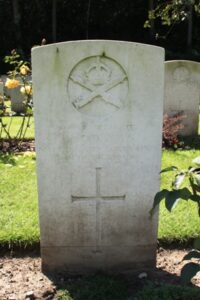
William Llewellyn Davies, Private, 12792, South Wales Borderers. William was the son of James and Frances Davies, of 2, Caroline Street, Llanelli. He enlisted at Llanelli on 20 August 1914 into the 4th Battalion, South Wales Borderers, which was attached to 40 Brigade, 13th (Western) Division. On 13 June 1915 the Division sailed for Alexandria. The Division landed at Cape Helles, Gallipoli, from 6 July 1915, relieving the 29th Division. They left and returned to Mudros at the end of the month, and the entire Division landed at ANZAC Cove between 3 and 5 August, 1915, taking part in the Battle of Sari Bair. William was wounded here, and taken aboard a Hospital Ship, where he died on 10 August 1915, aged 24. William was buried at sea, so is commemorated on the Helles Memorial, Gallipoli.
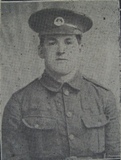
William Rhys Davies, Private, 64098, Machine Gun Corps. William was the son of Henry and Jane Davies, of 1, Palace Avenue, Llanelli. He enlisted on 11 May 1916 into the Welsh Regiment, and was posted to France on 10 August 1917, joining the 61st Company, Machine Gun Corps, which was attached to the 20th (Light) Division. He joined the Division at Ypres, and saw his first action at Third Ypres, at the Battles of Langemarck, the Menin Road, and Polygon Wood, before moving south in November, to take part in the Battle of Cambrai. William was killed at Cambrai on 30 November 1917, aged 20. He is commemorated on the Cambrai Memorial, Louverval, France.
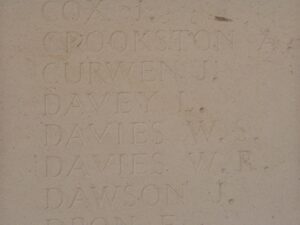
Henry Ernest Davis, Private, 60708, Welsh Regiment. Henry was the son of Francis Thomas and Bessie Davis, of Pretoria House, Brynallt Terrace, Llanelli. He enlisted at Llanelli into the 4th Welsh, and was posted to France in March 1918, where he joined the 14th Battalion, Welsh Regiment, which was attached to 114 Brigade, 38th (Welsh) Division. Henry would have joined the battalion just before it moved to the Somme in April 1918, and took part in the great offensive on the Somme from 21 August 1918. He was killed during the Battle of Cambrai, on 8 October 1918, aged 20. Henry is buried at Bois-Des-Angles British Cemetery, Crevecouer-Sur-L’Escaut, France.
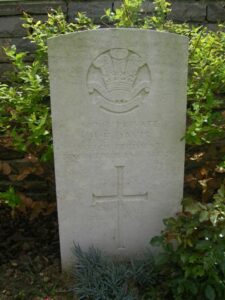
Sidney Charles Davis, Stoker, 3791S, Royal Navy. Sidney was born at Rhode Island, America on 8 May 1896, the son of Sidney Charles Davis and Caroline Davis. By the turn of the centery the family had moved to 10, Thompson St., Stockton-on-Tees. Sidney resided at Mansel Street, Llanelli prior to the war, and served with the Royal Navy, aboard HMS Defence. Defence was a Minotaur class armoured cruiser, and was stationed in the Mediterranean at the outbreak of war, taking part in the pursuit of the German battlecruiser SMS Goeben and light cruiser SMS Breslau. Defence then transferred to the Grand Fleet in January 1915 and remained there for the rest of her career. Sidney was killed when Defence was sunk on 31 May 1916, during the Battle of Jutland, after being struck by two salvoes from German ships that detonated her rear magazine, which exploded, sinking her with no survivors. Sidney was 20 years old, and is commemorated on the Chatham Naval Memorial, Kent.
William Gilbert Daw, Private, 6516, Honourable Artillery Company. William was the son of William and Elizabeth Agnes Daw, of Gunnerside, Queen Victoria Road, Llanelli. He enlisted in December 1915 into the 5th Battalion, Honourable Artillery Company. On 18 November 1916 he was posted to the 2/1st Battalion, Honourable Artillery Company, which was attached to 22 Brigade, 7th Division. In March 1917 the Division followed the German Retreat to the Hindenburg Line. Later in the year the Division took part in the Third Battle of Ypres, suffering significant losses during the fighting for Polygon Wood. Immediately on their relief, the Division was moved to Italy. William was shot in the knee, and captured by the Austrians on 29 June 1917, during the Battle of The Piave River. He died of his wounds on 13 July 1918, aged 27, and was buried at Magnaboschi Military Cemetery, Italy by the Austrian Chaplain Franz Kokol.
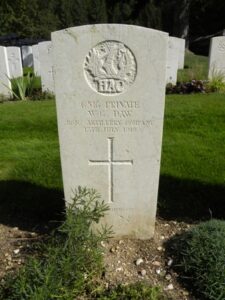
Albert Edward Dawson, Private, 42715, King’s Liverpool Regiment. Albert was the son of Albert and Ellen Dawson, of 2, Mount Pleasent Building, Llanelli. He enlisted at Cardiff into the army. He served on the Western Front with the 7th Labour Company, King’s Liverpool Regiment, and was killed in action during the First Battle of Passchendaele, on 24 October 1917, aged 20. He is buried at Duhallow A. D. S. Cemetery, Belgium.
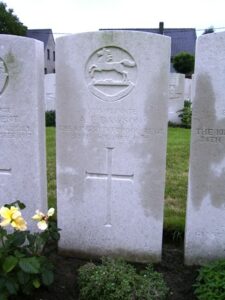
Edwin James Day, Private, 39470, Welsh Regiment. Edwin was born at Swindon, and resided at Llanelli prior to the war, working for the GWR. He enlisted there into the army, and was posted to France, where he joined the 2nd Battalion, Welsh Regiment, which was attached to 1 Brigade, 1st Division. Edwin would have fought with the Division at the Battle of Loos in September 1915. The following year the Division moved south, and took part in the Somme offensive. Edwin was killed here during the Battle of Pozières, on 25 July 1916, aged 30. He is commemorated on the Thiepval Memorial, France.
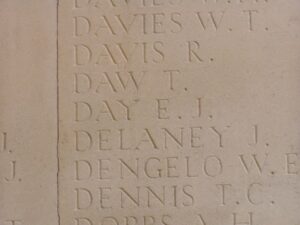
William John Delaney, Private, 22899, Welsh Regiment. William was the son of Mathew and Edna Delaney, of 6, Campbell Street, New Dock, Llanelli. He enlisted at Llanelli into the 9th Battalion, Welsh Regiment, which was attached to 58 Brigade, 19th (Western) Division. The Division crossed to France during July 1915, and moved to positions near Loos, where it took part in the opening attack of the Battle of Loos on 25 September 1915. William was killed in action during the charge of the 9th Welsh near Givenchy that day. He was 20 years old, and is commemorated on the Loos Memorial, France.
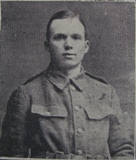
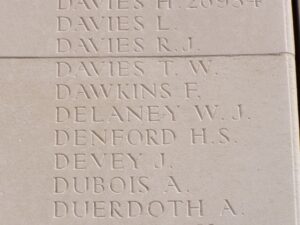
Harry Skeel Duncan Dempster, Lance Corporal, R/6328, Kings Royal Rifle Corps. Harry was born at Bromyard, Herefordshire in 1888, the son of Robert Dempster and Margaret Dempster (nee Evans). By 1891 the family had moved to Canal Bank Cottage, Brecon, where his father had gained a position as Huntsman. He was educated at Christs College and at Brecon Grammar School. Harry worked as a clerk prior to enlisting at Haverfordwest into the King’s Royal Rifle Corps on 2 November 1914 and was posted to their depot at Winchester, before joining the newly formed 7th Battalion, King’s Royal Rifle Corps, which was at Marlborough Lines, Aldershot, attached to 41 Brigade, 14th (Light) Division. In November 1914 the battalion moved to Grayshott, near Hindhead in billets, then in February 1915 to Bordon, before moving to Aldershot in March to complete its training. On 19 May 1915 the battalion landed at Boulogne and the entire division moved to the Ypres Salient, for trench initiation alongside the 5th Division. The Division was to see its first major action during the Action of Hooge in July 1915, where the Division became the first to be attacked by the German use of flamethrowers. The Division remained in the Hooge Sector, in terrible conditions after this horrific attack, suffered heavy casualties on a regular basis. Harry was shot in the head and badly wounded at the end of July 1915 and was evacuated to No 24 General Hospital at Étaples, where he died of his wounds on 2 August 1915. The 27-year-old was buried in Étaples Military Cemetery, France. His brother Robert George Duncan Dempster was killed in France in 1918.
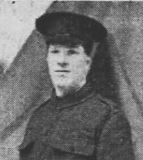
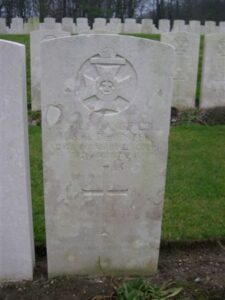
Hubert Gilmore Dewsberry, Lance Corporal, 200356, Welsh Regiment. Hubert was the son of Robert and Lizzie Dewsberry, of Hendre, Box, Llanelli. He resided in Ammanford prior to the war, and enlisted at Llandeilo into the 1/5th Battalion, Welsh Regiment, attached to 159 Brigade, 53rd (Welsh) Division. The Division moved to the Mediterranean, sailing from Devonport in July 1915 arriving at Mudros by 5 August 1915. From here they moved to Gallipoli, landing on 9 August, and were immediately thrown into action, and spent the next few days in isolated pockets fighting against a Turkish counter-attack. The Division remained here throughout the coming months, and suffered severe losses in manpower strength during the great November 1915 blizzard on Gallipoli, when its total strength was reduced to less than that of a full-strength Brigade. On 11 December 1915 the Division was evacuated to Mudros, and by 23 December 1915 were moved to Egypt. They remained on the Suez Canal Defences for the next twelve months, and in early 1917 moved into Palestine, where they remained for the duration of the war, fighting at the Battles of Gaza, and successfully capturing Jerusalem. Hubert was wounded during the Second Battle of Gaza, and died of wounds on 28 April 1917 aged just 19. He is buried at Deir El Belah War Cemetery. He is also remembered on his parent’s gravestone at Box, Llanelli.
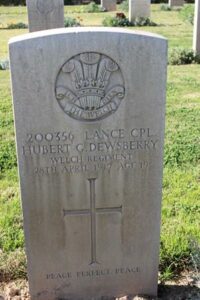
George William Dobson, Private, G/7643, Middlesex Regiment. George was the son of George and Annie Dobson, of 81, Hartland Rd., Kentish Town, London. He married Annie Edith Reynolds on 6 April 1904 but she did soon after, aged 24, possibly in childbirth. George moved to Llanelli at some time after, enlisting there into the army. He was posted to France with the 3rd Battalion, Middlesex Regiment, which was attached to 85 Brigade, 28th Division. On 19 January 1915 the battalion landed at Le Havre and moved to the Western Front, where it saw its first major action during the Second Battle of Ypres. Later that year the Division took part in the Battle of Loos, and it was there, on 29 September 1915 that George was killed. He was 33 years old, and is commemorated on the Loos Memorial, France.
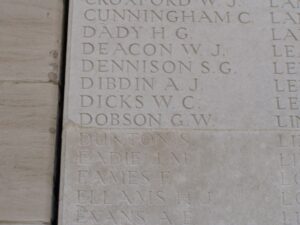
Richard Donoghue, Private, 291761, Welsh Regiment. Richard was the son of Richard and Mary Ellen Donoghue, of 7, Bevan Rd., Plumstead, London. By 1910 the family had moved to 8, Stepney Road, Burry Port, and Richard enlisted at Cardiff into the Welsh Regiment. During the summer of 1918 Richard was sent to France, where he joined the 24th Battalion, Welsh Regiment, which was the Pembroke and Glamorgan Yeomanry battalion, attached to 231 Brigade, 74th (Yeomanry) Division. The Division had formed in Egypt in January 1917 and had fought through the Palestinian Campaign, at the Battles of Gaza and the Battle and capture of Jerusalem. Due to the terrible casualties suffered by the British on the Western Front in March and April 1918 the Division was recalled to the Western Front, and arrived at Marseilles during May 1918. They then fought at the Second Battle of Bapaume during the great offensive, and fought in Flanders before returning to the Somme and fighting at the Battle of Épehy, as part of the offensive towards the Hindenburg Line. Richard was wounded during the Battle of Épehy, and died on 23 September 1918. He was 20 years old, and is buried at Doingt Communal Cemetery Extension, France.
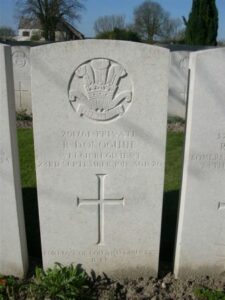
George Duckett, Private, 11952, Welsh Regiment. George was the son of George and Selina Duckett, of 64, Rosebery Avenue, East Ham, London. He worked at Llanelli prior to the war, and enlisted under the name of George Morris at Llanelli, into the 2nd Battalion, Welsh Regiment. The battalion moved to France after the outbreak of war attached to 3 Brigade, 1st Division, and took part in the retreat from Mons to the Marne, before moving to positions at Gheluveldt, near Ypres. Here they fought at the First Battle of Ypres, before wintering in Flanders. The following year saw them in action again at the Battle of Aubers, before moving South to Loos, where they fought during the Battle of Loos. Again they were required for a major offensive, and fought throughout the Somme Offensive. They followed the German retreat to the Hindenburg Line in early 1917, and were then briefed for an operation on the Flanders Coast, and moved there during the summer of 1917. While training on the coast, the Battle of Third Ypres had stalled in the mire, and the Division were recalled to Ypres, where they fought at the Second Battle of Passchendaele. George was killed here on 8 November 1917. He was 28 years old, and is commemorated on the Tyne Cot Memorial, Belgium.
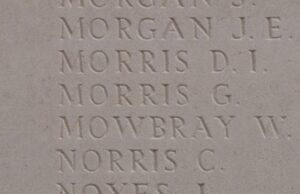
Frank Edmunds, Sapper, 448148, Royal Engineers. Frank was the son of John and Ellen Edmunds, of 125, Old Castle Road, Llanelli. He enlisted at Llanelli into the Welsh Field Company, Royal Engineers. He served with the Company, which was attached to the 53rd (Welsh) Division, at Gallipoli, before the entire Division was withdrawn to Egypt. Frank was then posted to the 455th Field Company, and was wounded during Operations in Palestine. He died of wounds on 12 August 1917, aged 19, and is buried at Deir El Belah War Cemetery, Egypt.
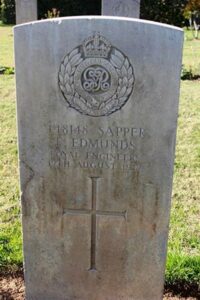
Albert Llewellyn Edwards, Private, 39318, Essex Regiment. Albert was the son of Joseph and Jemima Edwards, of 110, Station Road, Llanelli. He enlisted at Llanelli into the army, and was posted to the 1st Battalion, Essex Regiment, which was attached to 112 Brigade, 37th Division on 4 February 1918, after having spent most of the war with the 29th Division. During March 1918 the Division was at the Somme, and fought during the German Offensive, at the Battle of Albert. Albert was killed here on 23 August 1918. He was 22 years old, and is buried at Fillievres British Cemetery, France.
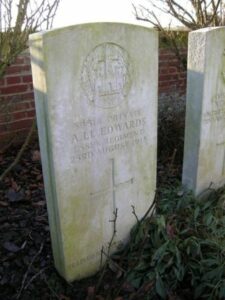
Alfred Edwards, Private, 102001, Machine Gun Corps. Alfred was born at Frederick Street, Llanelli, and enlisted there into the Welsh Regiment. He was then transferred into the 5th Battalion, Machine Gun Corps, which was attached to the 5th Division. The Division had taken part in the retreat from Mons to the Marne at the outbreak of war, and had fought at every major battle which followed. On 21 August 1918 the Division took part in the great offensive across the old Somme battlefields, and it was on this opening day of the attack that Alfred was killed, on 21 August 1918. He is buried at Adanac Military Cemetery, Miraumont, France.
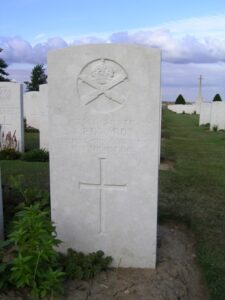
David James Edwards, Private, 1514, Welsh Guards. David was the son of John and Mary Edwards, of Llanelli, and lived with his elder sister, Susan Edwards, at 3, Gilbert Place, Llanelli prior to the war. He was a Policeman before enlisting in May 1915 into the 1st Battalion, Welsh Guards. The battalion moved to France in July 1915, joining the 3rd Guards Brigade, Guards Division. The Division saw its first action at the Battle of Loos. David was killed here on 27 September 1915, aged 32. He is commemorated on the Loos Memorial, France.
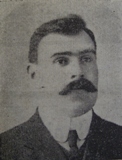
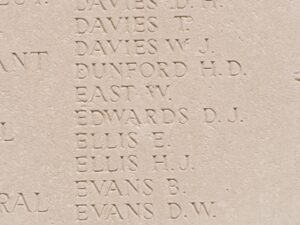
George Benjamin Edwards, Able Seaman, 195104, Royal Navy. George was born on 21 August 1881, the son of George and Louise Edwards, of 2, Lime Kiln Row, Llanelli. He was a long serving Royal Naval seaman, and lived with his wife Elizabeth Charlotte Edwards, at 30, Edinburgh Road, Devonport. George had served at sea for the first two years of the war, before becoming ill, and died at Devonport on 23 October 1916, aged 35. He is buried in Plymouth (Ford Park) Cemetery, Devon.
Thomas Edwards, Private, 12776, South Wales Borderers. Thomas was born at Llanelli, and enlisted there into the 4th Battalion, South Wales Borderers. The battalion was attached to 40 Brigade, 13th (Western) Division, which landed at Cape Helles, Gallipoli from 6 July 1915, relieving the 29th Division. They left and returned to Mudros at the end of the month, and the entire Division landed at ANZAC Cove between 3 and 5 August, 1915, taking part in the Battle of Sari Bair. Thomas was killed here on 10 August 1915. He is buried at No. 2 Outpost Cemetery, Gallipoli.
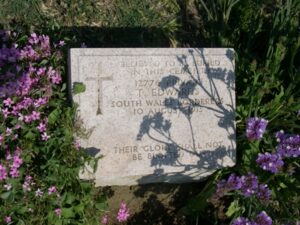
William Edwards, Private, 5484, Royal Welsh Fusiliers. William was the son of John and Margaret Edwards of 4, Shaws Lane, Carmarthen. He had resided at Llanelli prior to the war, and enlisted at Cardiff into the 2nd Battalion, Royal Welsh Fusiliers. The battalion moved to France at the outbreak of war, where it joined 19 Brigade, an independent unit, and took part in the retreat from Mons to the Marne. The Brigade was used to fill holes during its time at war. In the spring of 1916 the 2nd RWF were stationed in the Givenchy sector, an area renowned for its mining activities. On 22 June 1916 the Germans exploded a massive mine beneath the 2nd RWF positions at the Duck’s Bill, almost wiping out half the battalion. William was one of the men lost that day. He was 39 years old, and is commemorated on the Loos Memorial, France.
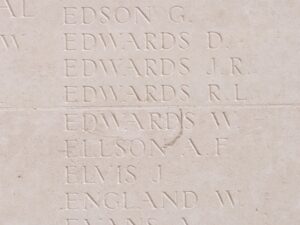
Thomas Ellery, Private, 345507, Royal Welsh Fusiliers. Thomas was born in Bodmin in 1897, the son of Thomas and Kathleen Ellery. By 1902 the family had moved to 6, Ropewalk Road, Llanelli, and his father found work as a Tinsmith. Thomas enlisted at Llanelli on 20 August 1914 into the Royal Welsh Fusiliers. In December 1914 he was posted to the 3rd Royal Welsh Fusiliers, and had then fought in Gallipoli and Mesopotamia with the 8th Royal Welsh Fusiliers before becoming ill with cholera, and sent home. On 16 February 1917 Thomas sailed from Southampton for Egypt, joining the 24th Battalion, Royal Welsh Fusiliers. The battalion was attached to 231 Brigade, 74th (Yeomanry) Division, and took part in the advance into Palestine from April 1917. Thomas was killed during the Third Battle of Gaza, on 31 October 1917. He was 20 years old, and is buried at Beersheba War Cemetery, Israel. Thomas had been awarded the Indian Royal Humane Society Medal for life saving while on the Tigris River, when rescuing a Private Williams, who had fallen overboard from a paddle steamer on 18 March 1916.
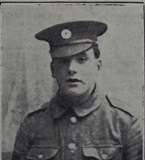
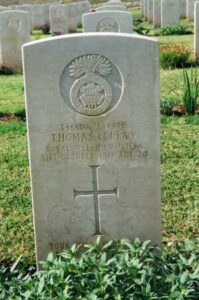
Llewellyn Benjamin Elsmere, Private, 30455, Kings Own Royal Lancaster Regiment. Llewellyn was the son of Benjamin J. and Anne Elsmere, of Hill Park, Hendry Road, Llangennech. He worked at the Capital and Counties Bank, Llanelli prior to the war, and enlisted at Carmarthen into the army. He was posted to the 1st Battalion, King’s Own Royal Lancaster Regiment, which was attached to 12 Brigade, 4th Division. The Division had been in France since the Battle of Le Cateau in August 1914, and had fought at every major battle thereafter. In the summer of 1917 the Division was at Ypres, where it took part in the Passchendaele Offensive. Llewellyn was killed in action during the Second Battle of Passchendaele on 3 November 1917. He was 31 years old, and is buried at Duisans British Cemetery, Etrun, France.

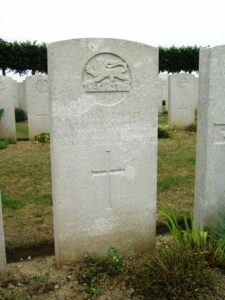
Alfred Evans, Private, 12878, Royal Welsh Fusiliers. Alfred was the son of William and Rachel Evans, of 10, Sandy Gate Terrace, Llanelli. He enlisted there into the 9th Battalion, Royal Welsh Fusiliers, which was attached to 58 Brigade, 19th (Western) Division. The Division moved to France during July 1915, and moved to positions near Loos, where it took part in the opening attack of the Battle of Loos on 25 September 1915. Alfred was killed during the attack near Givenchy that day, aged 23. He is commemorated on the Loos Memorial, France.

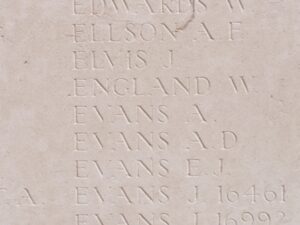
Arthur Evans, Private, 156259, Machine Gun Corps. Arthur was born in 1889, the son of James Evans and Lucy Evans (nee Walters), of 68, Alban Road, Llanelli. He worked as a furnaceman at the South Wales Tinplate Works prior to the war and was a highly regarded player for the Oriental Stars Rugby Team at Llanelli. Arthur originally enlisted into the South Wales Borderers in 1916 and served in France with the regiment before being sent home suffering from trench fever and spent over four months recovering at Epsom Hospital. Upon his recovery he was drafted back out to France in the summer of 1918, joining the 3rd Battalion, Machine Gun Corps, which was attached to the 3rd Division. On 21 August 1918 the Allies launched a huge offensive from the Somme Sector and began driving the Germans back towards the mighty Hindenburg Line. The 3rd Division was in positions at Fouquereuil, south of Bethune, and moved to Camblain-Chatelaine before entraining for Warlincourt and marched to Monchy Au Bois before joining the great offensive, advancing through Mory on 12 September. Arthur was killed in action near Ribecourt, during the fighting around the Canal Du Nord, on 6 October 1918. The 28-year-old is buried in Ribecourt British Cemetery, France.
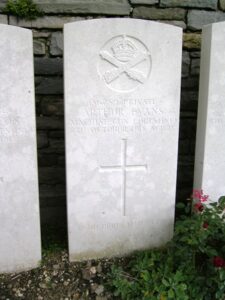
Claude Vincent Evans, Lance Corporal, 55702, Northumberland Fusiliers. Claude was born at Coleford, Gloucester, the son of John and Margaret Evans. He resided in Llanelli prior to the war, and enlisted there into the army. Claude was posted to the 11th Battalion, Northumberland Fusiliers, who were attached to 68 Brigade, 23rd Division. The Division had been in France since August 1915, and saw their first major action at the Battle of the Somme. In May 1917 they took part in the Battle of Messines, before taking part in the Third Battle of Ypres. During October 1917 the Division moved to Italy, and remained here for the remainder of the war. Claude was killed in action during the Battle of the Piave River, on 15 June 1918, aged 26. He is buried at Magnaboschi British Cemetery, Italy.
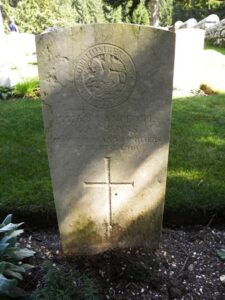
David Evans, Gunner, 3907, Royal Field Artillery. David was born at Llanelli, and enlisted there into the army. He was posted to France with D Battery, 159th Brigade, Royal Field Artillery, which was attached to the 35th Division. The Division moved to France in late January 1916, and saw its first major action during the Battle of the Somme. The Division then followed the German Retreat to the Hindenburg Line in March 1917. Later in the year they moved north to Ypres, and fought at the Second Battle of Passchendaele. By spring of 1918 they were back on the Somme, and fought at the First Battle of Bapaume, during the German Offensive. David was killed on the Somme on 6 May 1918. He was buried at Varennes Military Cemetery, France.
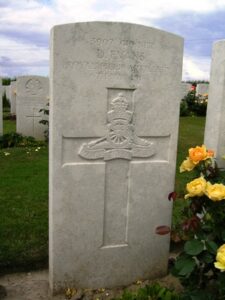
David Evans, Private, 37705, Welsh Regiment. David was born at Llanelli, and resided at Ystradgynlais prior to the war. He enlisted at Brecon into the army, and was posted to the 1st Battalion, Welsh Regiment, which was attached to 84 Brigade, 28th Division. The Division formed in England from December 1914, from regular units returning from service around the Empire. During January 1915 it moved to France, landing at Le Havre and moved to the Western Front, where it saw its first major action during the Second Battle of Ypres. The Division suffered heavy casualties here, and didn’t see major action until the Battle of Loos on 25 September 1915. David was killed at Loos on 2 October 1915. He is commemorated on the Loos Memorial, France.
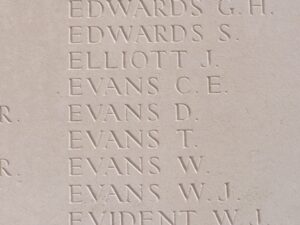
David Archibald Evans, Gunner, W/1648, Royal Field Artillery. David was born at Llanelli in 1898. He enlisted there into the Welsh Royal Field Artillery, and was posted to France with 78th Brigade, Royal Field Artillery, which was attached to the 17th (Northern) Division. David was wounded during the Second Battle of Bapaume, and died on 3 September 1918. He was 20 years old, and is buried at Thilloy Road Cemetery, Beaulencourt, France.
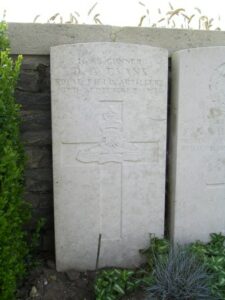
David Dudley Evans, Sergeant, 13377, Royal Fusiliers. David was born in 1876, and married Minerva Eugenia Jenkins at Llanelli in March 1901. The couple lived at 35, Bournevale Road, Streatham prior to the war, where David worked as a Draper. He enlisted into the army, and was posted to East Africa with the 25th Battalion (Frontiersmen), Royal Fusiliers. They sailed on the SS Neuralia for Mombasa, and arrived on 6 May 1915. The battalion served here for the duration of the war, centred mostly around Lake Tanganyika, British East African and German East African territory. The battalion was largely composed of older men who hailed from diverse backgrounds and varied occupations, some of whom were Boer War veterans. David was killed here on 24 June 1916, aged 40. He is buried at Dar Es Salaam War Cemetery, Tanzania.
David John Evans, Private, 8717, Welsh Regiment. David had enlisted into the Welsh Regiment during 1905. At the outbreak of war, he sailed for France with the 2nd Battalion, Welsh Regiment, which was attached to 3 Brigade, 1st Division. He took part in the retreat from Mons to the Marne, and was wounded at Gheluveldt on 3 November 1914. David returned to action, and was killed in action on 4 May 1915 near Neuve Chapelle. David was 31 years old, and is commemorated on the Le Touret Memorial, Richebourg L’Avoue, France.
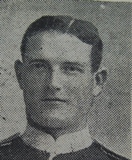
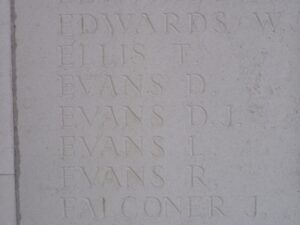
David Rees Evans, Flight Cadet, Royal Air Force. Very little is known of David, except that he was a Flight Cadet with the Royal Air Force when he died at Netheravon, Wiltshire on 17 December 1918, aged 19. He is buried at Rhondda (Trealaw) Cemetery, Mid-Glamorgan.
David Rees Evans, Private, 368284, Royal Army Medical Corps. David was the second son of John Vaughan Evans and Margaret Jane Evans, of Murray House, Llanelli. He enlisted on 25 May 1915 and was posted to the 2nd Lowland Field Ambulance, Royal Army Medical Corps, which was attached to the 52nd (Lowland) Division, and saw action at Gallipoli that year. After being evacuated from Gallipoli the Division moved to Egypt. It moved into Palestine early in 1917, and took part in the Palestinian Offensive, fighting at the Battles of Gaza, and taking part in the capture of Jerusalem. The Division received orders in March 1918 to proceed to the hard-pressed Western Front, where it then remained for the duration of the war. David was killed near Arras on 27 May 1918. He was 25 years old, and is buried at Ecoivres Military Cemetery, Mont-St-Eloi, France. His brother, Richard William Evans also fell.
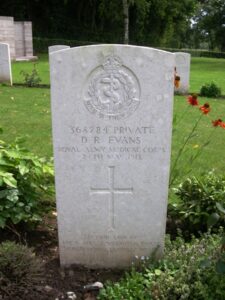
Edgar Herbert Evans, Private, 197, Welsh Guards. Edgar was born at Penarth, and resided at Llanelli prior to the war. He enlisted there into the Grenadier Guards, before transferring to the 1st Battalion, Welsh Guards upon their formation in February 1915. The battalion served throughout the war with the 3rd Guards Brigade, Guards Division. The Division, which was around Maubeuge at the Armistice, was ordered to the Rhine and crossed the frontier on 11 December 1918. Edgar was taken ill, and died in Germany on 22 February 1919. He was buried at Cologne Southern Cemetery, Germany.
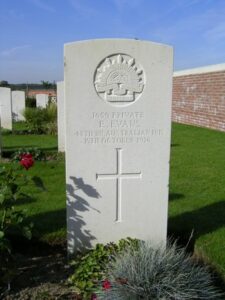
Edgar John Evans, Ordinary Seaman, WZ/4226, Royal Navy. Edgar was born at Coleford, Gloucester on 23 July 1896, the son of John and Margaret Evans. The family later resided at 21, High Street, Llanelli. Edgar served with the Royal Navy aboard HMS Osmanieh. On 31 December 1917, Osmanieh was nearing Alexandria, after having sailed from England with a large number of troops and medical staff, when she struck a mine and sank, with the loss of 209 lives. Edgar was 21 years old, and is buried in Alexandria (Hadra) War Memorial Cemetery, Egypt.
Edgar Prosser Evans, Private, 85951, Machine Gun Corps. Edgar was the son of David and Mary Evans, of 17, Emma Street, Llanelli. He served with the Welsh Regiment, before being posted to the 107th Company, Machine Gun Corps, which was attached to the 36th (Ulster) Division. Edgar probably served with the Division through the Battle of the Somme. They fought at the Battle of Messines the following year, before moving to Ypres, where they took part in the Battle of Langemarck. Edgar was killed here on 2 August 1917. He was 24 years old, and is buried at Vlamertinghe New Military Cemetery, Belgium.
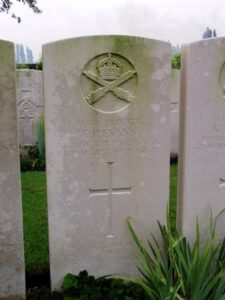
Edward Evans, Private, 1659, Australian Imperial Force. Edward was born at Llanelli in 1876, and had emigrated to Australia prior to the war, where he worked as a Bushman. He enlisted at Adelaide on 28 February 1916, and sailed for France with the 2nd reinforcements for the 48th Battalion, Australian Imperial Force, which was attached to the 12th Australian Brigade, 3rd Australian Division. He landed at Etaples, France on 24 September 1916, and joined the battalion at Ypres a month later. On 15 October 1916, Edward was in the Poppy Lane trench, near Ridge Wood, when it was shelled by German trench mortars. Edward was one of three men killed during the bombardment. He was 39 years old, and is buried at Ridge Wood Military Cemetery, Belgium. His personal possessions were sent to his brother-in-law, Herbert Hornsby, of Sydney, NSW.
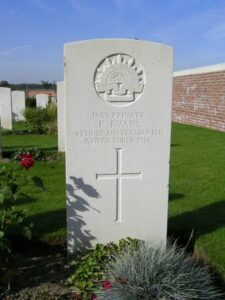
Evan John Evans, Stoker, 2901T, Royal Navy. Evan was born on 24 January 1885, the son of Mr. and Mrs. Evans, of New Dock, Llanelli, and the husband of Catherine Ann Evans, of 7, Tin Works Row, New Dock, Llanelli. He served with the Royal Navy aboard HMS Vala, which was one of the famous ‘Q Ships’. Evan was killed when Vala was sunk by the German submarine U-54 off Ireland on 21 August 1917. He was 33 years old, and is commemorated on the Plymouth Naval Memorial, Devon.
Frederick Evans, Private, 44943, South Wales Borderers. Frederick was the son of Thomas and Letitia Evans, of 51, Walters Road, Llanelli.He enlisted at Llanelli into the army, and was posted to the 7th Battalion, South Wales Borderers, which was attached to 67 Brigade, 22nd Division. The Division crossed to France in early September 1915, but were then sent to Salonika the following month, where it remained for the remainder of the war. Frederick was killed during the Battle of Doiran on 26 May 1917. He was 19 years old, and is buried at Karasouli Military Cemetery, Greece.
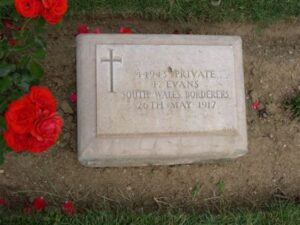
Haydn Stanley Evans, Private, 203096, Welsh Regiment. Haydn was the son of John and Hannah Evans, of 2, Cawdor Terrace, Cenarth. He had worked with his mother Hannah in their shop at Llanelli prior to 1911, before marrying, and living with his wife Margaret Evans, at 22, Wellfield Terrace, Llanelli. He enlisted there into the 1st Battalion, Welsh Regiment, which was attached to 84 Brigade, 28th Division. The Division formed in England between December 1914 and January 1915 from regular units returning from India, Singapore and Egypt. During January 1915 it moved to France, landing at Le Havre and moved to the Western Front, where it saw its first major action during the Second Battle of Ypres. Following serious casualties at Ypres, a Composite Brigade was formed, composing of the 2nd Battalion, the Buffs, 2nd Battalion, the Cheshire’s, 1st Battalion, the Welsh, and 1st Battalion, the York and Lancaster. It was dissolved on 19 May 1915, and the formation assumed its normal configuration, taking part in the Battle of Loos. During October 1915, the Division embarked at Marseilles, and proceeded to Egypt, and in November moved on to Salonika where the Division then remained. Haydn was felling trees on 22 May 1918, when he slipped and fell into a ravine, seriously injuring himself. The 28-year-old died two hours later. Haydn is buried in Sarigol Military Cemetery, Kriston. He is also remembered on the grave of his mother, at Box Cemetery, Llanelli.
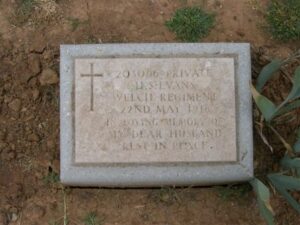
Herbert Ronald Evans, Acting Sergeant, C/1238, Kings Royal Rifle Corps. Hubert was the son of Thomas and Elizabeth Evans, of 8, Nevil’s Terrace, Dafen. He was a Tinworker prior to the war and enlisted at Llanelli into the Kings Royal Rifle Corps. Hubert was later transferred into the Kings African Rifles, and died of sickness in East Africa on 24 April 1918. He was 30 years old, and is buried at Pemba Cemetery, Mozambique.
Joseph Evans, Private, L/15904, Middlesex Regiment. Joseph was the son of John and Ann Evans, of Penygaer, Dafen. He was a Tinworker prior to enlisting into the Royal Hussars. He later transferred into the 1st Battalion, Middlesex Regiment, which had landed at Havre as L. Of C. Troops on 11 August 1914. On 22 August, 1914 they were attached to 19th Brigade, forming at Valenciennes, and on 12 October moved with 19th Brigade, to the 6th Division. On 31 May 1915 they again moved, to the 27th Division, and by 19 August were with the 2nd Division at Loos. Here they took part in the opening assault of the Battle of Loos, near Cambrin, on 25 September 1915. Joseph was killed in action this day, aged 23, and is buried at Cambrin Churchyard Extension, France.
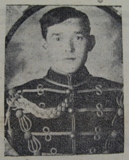
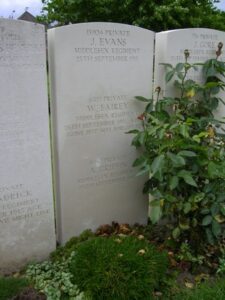
Lewis George Evans, Driver, 448237, Royal Engineers. Lewis was the son of David and Annie Evans, of 91, Llewellyn Street, Llanelli, and enlisted there into the Welsh Field Company, Royal Engineers. Lewis was posted to Egypt, joining the 436th Field Company, which was attached to the 53rd (Welsh) Division, and died of sickness during the Final Offensive beyond the Jordan on 17 October 1918, aged 26. Lewis is buried at Gaza War Cemetery, Israel.
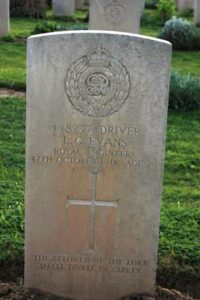
M. Evans, Sapper, Royal Engineers. This man cannot presently be identified.
Rees Evans, Private, 45371, Welsh Regiment. Rees was born at Treforest. He possibly worked at Llanelli prior to the war, and enlisted at Porth into the army, and was posted to France, where joining the 2nd Battalion, Welsh Regiment, which was attached to 3 Brigade, 1st Division. Rees probably joined the battalion late in 1915, when it was still in the Loos sector. During the summer of 1916 the Division moved south, to take part in the Somme offensive. Rees was killed here during the Battle of Guillemont, on 27 August 1916. He was 21 years old, and is buried at London Cemetery & Extension, Longueval, France.
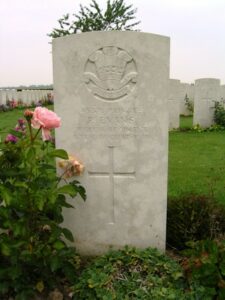
Richard William Evans, Sapper, Royal Engineers. Richard was the eldest son of John Vaughan Evans and Marga Jane Evans, of Murray House, Llanelli. He served with the Welsh Field Company, Royal Engineers, and died at home on 1 February 1916, aged 24. Richard is buried with his parents at Box Cemetery, Llanelli. He is not commemorated by the CWGC. His younger brother, David Rees Evans also fell.
S. Evans, Captain. This man cannot presently be identified, but his photograph was printed in an edition of the Llanelli Mercury.
Sydney Picton Evans, Lance Corporal, 488, Royal Engineers. Sidney was born in 1887, the son of David and Amelia Evans of Glanmor Road, Llanelli. He enlisted at Neyland into the 1/1st Welsh Field Company, which was attached to the 53rd (Welsh) Division. He landed in Gallipoli on 2 August 1915 and was sadly killed in action soon after, on 21 August 1915, aged 28, during the Defence of Helles. Sidney is buried at Green Hill Cemetery, Gallipoli. His brothers George and Harry also served with the Welsh Field Company, but survived the war.
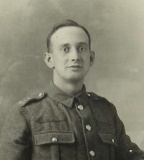
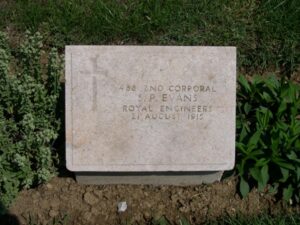
Theophilus James Evans, Private, 31588, South Wales Borderers. Theophilus was the son of David John Evans and Elizabeth Ann Evans, of 7, Sea View Terrace, Bwlch-y-Gwynt, Llanelli. He served with the 2nd Battalion, South Wales Borderers, which was attached to 87 Brigade, 29th Division. The Division took part in its first major action in France during the 1916 Somme Offensive, and fought at the Battles of Albert and Le Transloy, suffering heavy casualties. In the spring of 1917 they fought at the Battle of the Scarpe, which was part of the Arras Offensive, and then moved further north, taking part in the Third Battle of Ypres, before moving to Cambrai. Here they fought at the Battle of Cambrai in November and December 1917 before moving back to Flanders early in 1918. The German Spring Offensive hit the British on the Somme on 21 March 1918, and hit in Flanders just weeks later. Theophilus was killed during the resulting Battle of Estaires, on 11 April 1918. He was 19 years old, and is commemorated on the Ploegsteert Memorial, Belgium.
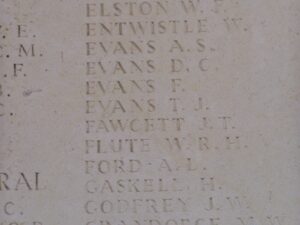
Thomas Evans, Private, 12866, Royal Welsh Fusiliers. Thomas was the son of Daniel and Mary Evans, of 40, Princess Street, Llanelli. He enlisted at Llanelli into the 9th Battalion, Royal Welsh Fusiliers, which moved to France in July 1915 as part of 58 Brigade, 19th (Western) Division. The Division fought at the Battle of Loos in September 1915, and moved to the Somme the following year, where it assaulted La Boiselle on 3 July 1916. Thomas was killed that day, aged 27. He has no known rave, and is commemorated on Pier and Face 4A of the Thiepval Memorial, France.
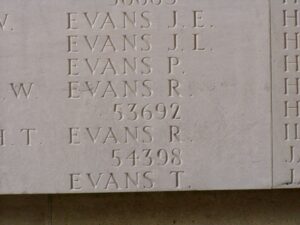
T. Evans, Sapper, Royal Engineers. This man cannot presently be identified.
Thomas John Evans, Guardsman, 20481, Grenadier Guards. Thomas was born at Llanelli, the son of John and Margaret Ann Evans. The family later moved to 11, Glanrhyd Street, Cwmaman, Aberdare, but Thomas returned to Llanelli, and enlisted there into the 3rd Battalion, Grenadier Guards, which was attached to the 2nd Guards Brigade, Guards Division. Thomas saw plenty of action during his time at war. He would have fought at the Battle of Loos in September 1915 and on the Somme in 1916. From July 1917 the Guards fought at the Third Battle of Ypres and at Cambrai later that year. The Guards also fought during the German offensive of 21 March 1918 onwards, before taking part in the great offensive from 21 August 1918. Thomas was killed during the Battle of Cambrai, on 9 October 1918. He was 22 years old, and is buried at Masnières British Cemetery, Marcoing, France.
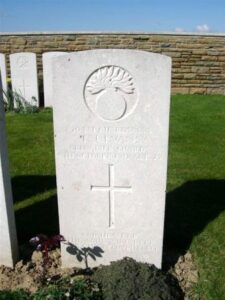
William Evans, Private, 18476, South Wales Borderers. William was born at Llanelli, the son of Evan Evans. The family later moved to 15, Beach Row, Pontyrhyl, Bridgend, and William enlisted at Tonyrefail into the 8th Battalion, South Wales Borderers. The battalion formed at Brecon on 19 September 1914 attached to 67 Brigade, 22nd Division, and sailed from Marseilles on 30 October 1915 for Salonika, where it remained for the duration of the war. William was wounded in Salonika, and died on 25 November 1917, aged 24. He is buried at Sarigol Military Cemetery, Kriston, Greece.
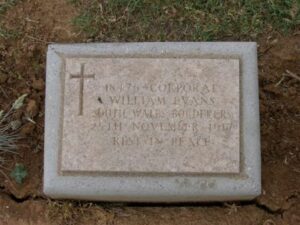
William Evans, Sapper, 156505, Royal Engineers. William was the son of Thomas Evans, of Myrtle Hill, Pwll, Llanelli. He had enlisted on 17 September 1914 into the 10th Battalion, Royal Welsh Fusiliers, and served with the battalion in France before being posted to the 250th Tunnelling Company, Royal Engineers on 25 May 1916. The Company was in the Messines ridge sector by October 1915, when it had begun work on the deep mines at Petit Bois, Peckham and Spanbroekmolen. William was accidentally killed during the Third Battle of Ypres, when he became trapped inside a hut which had been set on fire by a candle on 24 August 1917. He was 32 years old, and is buried at Kemmel Chateau Military Cemetery, Belgium.
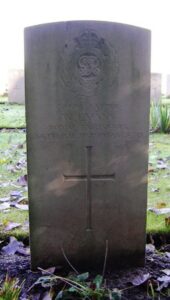
William Ivor Evans, Private, 3941, Welsh Regiment. William was born in Llanelli on 9 September 1891, the son of Maurice and Anne Evans, formerly of Laugharne. The family later resided at 64, High Street, Tumble. William was another local man to serve with the 1/4th Battalion (Carmarthen), Welsh Regiment. William embarked with the battalion as part of 159 Brigade, 53rd (Welsh) Division, and landed on Gallipoli on 8 August 1915, where the Welsh were plunged head first into terrible fighting. William was killed on his second day on Gallipoli, on 10 August 1915, during the Battle of Sari Bair (Attack on Scimitar Hill). He was 24 years old, and is commemorated on the Helles Memorial, Gallipoli.
William James Cadwallader Evans, MID, Sergeant, 448309, Royal Engineers. William was the son of Thomas and Mary Jane Evans, of 18, Mansel Street, Carmarthen. He served with the 1/1st Welsh Field Company, Royal Engineers, which was attached to the 53rd (Welsh) Division. William saw action with the Division at Gallipoli before it was moved to Egypt. He was Mentioned in Despatches during the war. William died in Egypt on 15 November 1918, aged 31. William is buried at Alexandria (Hadra) War Memorial Cemetery, Egypt. William is also remembered on the Christ Church, Carmarthen Memorial.
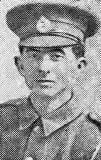
William Richard Evans, Private, 235034, Royal Welsh Fusiliers. William was the son of William John Evans and Hannah Evans, of 8, Llandafen Row, Llanelli. He enlisted at Llanelli on 6 June 1916 into the Royal Welsh Fusiliers, and was posted to France with the 10th Battalion, Royal Welsh Fusiliers, which landed at Boulogne on 27 September 1915, becoming attached to 76 Brigade, 3rd Division. In 1916 fought at the Actions of the Bluff, and at the St Eloi Craters. They were then moved south to the Somme, and fought there at the Battle of Albert, and the Battle of Bazentin, where they captured Longueval. They then took part in the Battle of Delville Wood, and the Battle of the Ancre, before settling into another bleak winter in France. In May 1917 the Division was at Arras. William was killed here during the Second Battle of the Scarpe, on 19 April 1917. He was 20 years old, and is commemorated on the Arras Memorial, France.
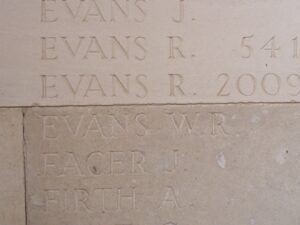
William Stephen Evans, Able Seaman, R/3420, Royal Naval Reserve. William was born on 16 March 1899, the son of David Samuel Evans, of Penlan, Tyrfran, Llanelli. He enlisted into the Pembroke Yeomanry, but transferred to the Royal Naval Reserve on 11 July 1917. On 6 August William was drafted to Nelson Battalion, which was attached to 189 Brigade, 63rd (Royal Naval) Division. He joined up with the battalion in time to take part in the Battle of Cambrai. William was killed in action during the Action of Welsh Ridge, on 31 December 1917. He was 29 years old, and is commemorated on the Thiepval Memorial, France.
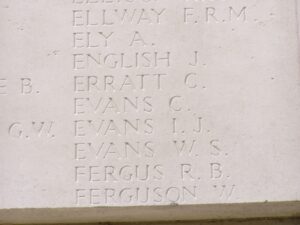
George Baker Featherstone, Sergeant, P.W.2342, Middlesex Regiment. George was born at Virginia Water, Surrey in 1879. He married Katherine Florence Ross in December 1915, and worked at Llanelli as a Fitter and Turner prior to the war. George enlisted at Llanelli on 5 May 1915 into the 18th Battalion, Middlesex Regiment, but was then was posted to the 19th Battalion, Middlesex Regiment, which was the Pioneer battalion to the 41st Division. The Division moved to France by 6 May 1916, and began familiarisation with trench warfare in the areas of Ploegsteert and the Douve valley, south of Ypres. They remained here until August 1916, when they moved to the Somme, and took part in the Battle of Flers-Courcelette. The Division remained in the line, pushing on to Courcelette over the next few days before coming out for a rest and re-fit. They then fought at the Battle of Le Transloy, before moving to positions south of Ypres in 1917. Here they took part in the Battle of Messines. George was wounded at Messines, and died on 8 June 1917, aged 38. He is buried at Lijssenthoek Military Cemetery, Belgium.
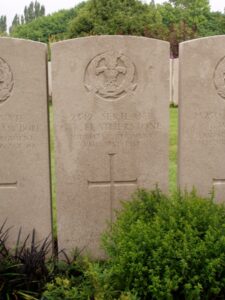
Walter Henry Field, Private, 260442, Gloucestershire Regiment. Walter was the son of William and Emily Field, of High Street, Corsham, Wilts. He resided at Llanelli prior to the war, and married Gertrude Maud Richards in 1913. The couple lived at 19, Pencoe Terrace, Llanelli. Walter served with the 12th (Bristol) Battalion, Gloucestershire Regiment, which was attached to 95 Brigade, 5th Division. March 1916 saw the Division moving to positions near Arras. On 1 July 1916 the Battle of the Somme opened, and the Division moved south fighting at High Wood, Guillemont, Flers-Courcelette, Morval and Le Transloy. On 5 October, after suffering heavy casualties, the Division moved to Festubert, where they remained until March 1917. They next saw action at the Battle of Arras, fighting at the Battle of Vimy in April 1917, and the attack on La Coulette. On 3 May they fought in the Third Battle of the Scarpe, and captured Oppy Wood. On 7 September, they were pulled out of the line again, and moved north to join the great offensive in Flanders, known as Third Ypres, or Passchendaele. Walter was killed during the Battle of Broodseinde, on 4 October 1917, aged 31. He is commemorated on the Tyne Cot Memorial, Belgium.
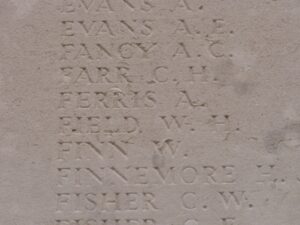
William Finn, Private, 4666, Royal Army Ordnance Corps. William was the son of Matthew and Henrietta Finn, of Fethard, County Wexford. He worked at Llanelli prior to the war, and enlisted there into the Royal Army Ordnance Corps. William served with them in Egypt, before becoming ill, and returning to England. He died on 26 February 1916, aged 32, and is buried at Wandsworth (Earlsfield) Cemetery, England.
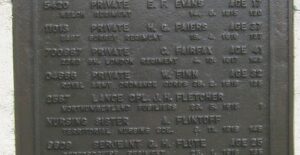
Peter Flanagan, Gunner, Royal Garrison Artillery. Peter lived at 93, Old Castle Road, Llanelli. He cannot be traced, but reportedly served with the Royal Garrison Artillery. He was 24 years old in 1916.
James Edward Forster, Private, 10890 (CH), Royal Marine Light Infantry. James was born at Walworth, London on 11 November 1881, and was the husband of Annie Forster (nee Hughes), of 65, Princess Street, Llanelli. He served with the Royal Marine Light Infantry aboard HMS Laurentic. Laurentic was a White Star cruise liner, which had been requisitioned for use as a troop transport ship for the Canadian Forces. James took ill aboard ship, and died on 27 June 1916, aged 34. He was buried at Hong Kong Cemetery.
Ethelbert Harold Foster, Lieutenant, Welsh Regiment. Ethelbert was the son of Obed and Eliza Jane Foster (nee Williams), of Llantwit Fardre. He was a Science Master at Llanelli for several years prior to the war, and was commissioned into the 4th Battalion, Welsh Regiment. Ethelbert was then attached to the 1/8th Battalion, London Regiment (Post Office Rifles). He was killed in action during an attack on the Hindenburg Line on 8 October 1918, aged 35, and is buried at Bois-Des-Angles British Cemetery, Crevecouer-Sur-L’Escaut, France.
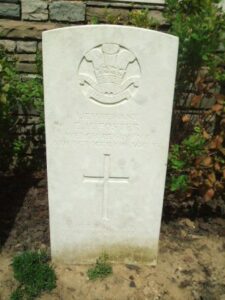
John Bowden Foster, Second Lieutenant, West Yorkshire Regiment. John was the son of Francis Frederick Foster and Elizabeth Jane Foster (nee Bowden), of Auckland, Co. Durham. He married Violet Holmes, of 62, King’s Road, Harrogate, in Leeds on 10 December 1912. The couple had lived at Llanelli for a time prior to the war. John had served with the Army Service Corps in France from 26 August 1915 before being commissioned into the 7th Battalion, West Yorkshire Regiment on 29 January 1918. The battalion was in France attached to 146 Brigade, 49th (West Riding) Division. It saw heavy fighting during the German Lys offensive in April 1918, and fought in Flanders until the beginning of the 100 days offensive in August 1918, before taking part in the great advance eastwards. John was killed in action during the pursuit to the Selle on 11 October 1918, aged 36, and is buried in Wellington Cemetery, Rieux-en-Cambresis, France.
Joseph Samuel Bailey Foster, Gunner, 21581, Royal Field Artillery. Joseph was the husband of Margaret Foster, of 31, Toppings Row, Boldon Colliery, Co. Durham. He resided at Dynevor Castle Hotel prior to the war, and was an employee of the Llanelli Steel Works. Joseph originally enlisted into the Royal Field Artillery, but was attached to the 8th Divisional Train, Army Service Corps in France. Joseph was wounded during the great offensive of 1918, and died on 29 October 1918, aged 34. He is buried at Duisans British Cemetery, Etrun, France.
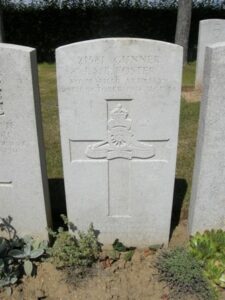
Cecil Gascoin Fowler, Private, 80231, Royal Welsh Fusiliers. Cecil was the son of Frederick and Elizabeth Fowler, of 11, Penywarc Road, Llanelli. He was posted to France early in 1918, where he joined the 14th Battalion, Royal Welsh Fusiliers, which was attached to 113 Brigade, 38th (Welsh) Division. Cecil would have taken part in the Divisions famous crossing of the River Ancre on 21 August 1918. The Division then drove eastward towards the mighty Hindenburg Line over the coming weeks. Cecil was killed during the Battle of Epehy, on 18 September 1918. He was 19 years old, and is buried at Gouzeaucourt New British Cemetery, France.

Albert Francis, Private, 20211, Welsh Regiment. Albert was the husband of Sarah Francis, of 99A, Lower Ann Street, Llanelli. He was one of the original men who enlisted into the 15th Battalion, Welsh Regiment, which was known as the Carmarthen Pals battalion, and trained at Kinmel Park, Rhyl during the months after its creation. Albert took ill at Rhyl, and died in Bangor Hospital on 14 June 1915. He was 42 years old, and was brought home for burial with full military honours at Box Cemetery, Llanelli.
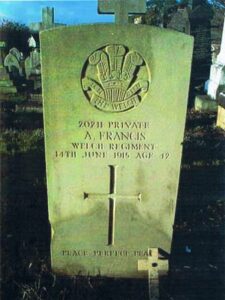
Albert Francis, Sapper, 67029, Royal Engineers. Albert was born at Fron, Furnace, and was the husband of May Francis. He served with the 130th Field Company, Royal Engineers, which was attached to the 25th Division. The Division landed in France on 26 September 1915, and were posted to the Vimy area, where they defended Vimy Ridge against a German attack in May 1916. They then moved to the Warloy area and attacked on 3 July near Thiepval. They fought throughout the Battle of the Somme, and then moved to Ploegsteert, where they held the line for the months leading up the Battle of Messines in June 1917. After fighting at Messines, the Division moved north, and fought at Pilckem Ridge. Albert was killed at Ypres on 1 September 1917. He was 28 years old, and is buried at Ypres Reservoir Cemetery, Belgium.
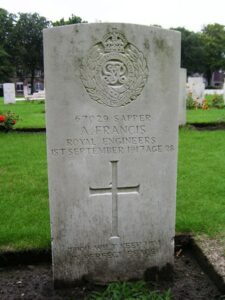
Gwilym Francis, Corporal, 20449, Welsh Regiment. Gwilym was the son of Daniel and Esther Francis, of 73, Llewellyn Street, Llanelli. He was one of the original enlistees into the 15th Battalion, Welsh Regiment, which was known as the Carmarthen Pals battalion, attached to 114 Brigade, 38th (Welsh) Division. On 2 December 1915 the battalion moved to France, and the entire Division moved to the Fleurbaix sector, where it was initiated into trench warfare. During June 1916 the Division marched south to the Somme, and on 7 July 1916 attacked Mametz Wood. The initial attack failed, and it was three days later, on 10 July, that a fresh attack was mounted. Gwilym was killed while fighting in the wood on 11 July 1916. He was 31 years old, and is commemorated on the Thiepval Memorial, France.
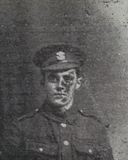
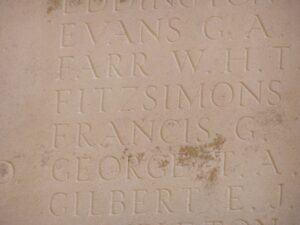
Joseph Francis, Lance Corporal, 15581, Royal Welsh Fusiliers. Joseph was the son of Matthew and Mary Francis, of 5, Llewellyn Street, Llanelli. He enlisted at Llanelli into the 9th Battalion, Royal Welsh Fusiliers, which was attached to 58 Brigade, 19th (Western) Division. The Division crossed to France during July 1915, and moved to positions near Loos, where it took part in the opening attack of the Battle of Loos on 25 September 1915. The following year the Division moved to the Somme, where it took part in the second wave of the attack on Ovillers-La Boiselle on 1 July, capturing the village at heavy cost. It then fought through the Somme Battles of Pozieres and the Ancre in 1916. In 1917 the Division moved north to Ypres, taking part in the Battle of Messines. Joseph was killed here on 15 June 1917. He was 29 years old, and is buried at Dickebusch New Military Cemetery Extension, Belgium.
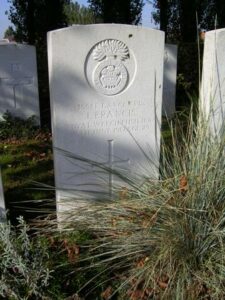
Sidney Thomas Edward Gann, Assistant Examination Officer, Mercantile Marine. Sidney was born at Llanelli in March 1874. He was a Merchant Mariner, and during the Great War was an Assistant Examination Officer at Harwich. Sidney died there as a result of an accident on 21 June 1918. He was 44 years old. Nothing more is presently known of Sidney, as he is not commemorated by the CWGC.
Alban Henry Gaunt, Private, CMT/377, Royal Army Service Corps. Henry was the son of George and Harriet Gaunt, of Burton Joyce, Nottinghamshire. He had resided at Haverfordwest prior to 1907, and married Jessie Evelina John in 1907. The couple then spent periods living at Skewen, Coedfranc and at Swansea and Llanelli prior to the outbreak of war, with Henry working as a Driver for Buckleys Breweries. When war erupted, Henry enlisted at Llanelli as a Driver with the Base M.T. Depot, Army Service Corps. Jessie by now had moved with their children to The Bull Inn, Prendergast, Haverfordwest, to be back with her family. Henry moved to France with the BEF at the outbreak of war, and was wounded by shell fragments at the Battle of Mons. He died of wounds on 24 August 1914, aged 28. Henry has no known grave, and is commemorated on the La Ferte-Sous-Joarre Memorial, France. Jessie remarried twice afterwards, and died in Staffordshire in 1953.
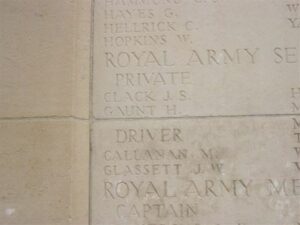
Rene Gautier, Private, 10462, Gloucestershire Regiment. Rene was born in Paris, but lived at Spitalfields, London prior to moving to Llanelli prior to the war. He returned to London to enlist into the 7th (Service) Battalion, Gloucestershire Regiment, which was attached to 39 Brigade, 13th (Western) Division. On 13 June 1915 the Division sailed for Alexandria, then moved to Mudros, preparatory for landing at Cape Helles, Gallipoli from 6 July 1915, relieving the 29th Division. They left and returned to Mudros at the end of the month, and the entire Division landed at ANZAC Cove between 3 and 5 August 1915, taking part in the Battles of Sari Bair, Russell’s Top, and Hill 60, ANZAC. Rene was killed during the Battle of Sari Bair, on 8 August 1915, aged 27. He is commemorated on the Helles Memorial, Gallipoli.
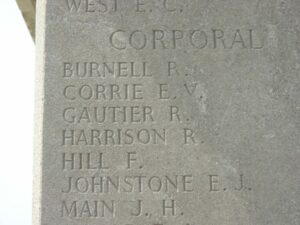
Alcwyn Morland Gibson, Second Lieutenant, West Yorkshire Regiment. Alcwyn was born in 1896, the son of George Gibson and Sarah Jane Gibson (nee Jones), of Dock House, Llanelli. His mother died when he was just two years old, so his father moved back with Alcwyn to his parents’ home at 58, Alban Road, Llanelli. Alcwyn was educated at the Llanelli Intermediate School. He had played several games at forward for the Scarlets prior to the war and was also a talented footballer and cricketer. Alcwyn was articled to Mr Leslie Williams, Solicitor at Llanelli, but left his position to enlist into the 1/28th Battalion, London Regiment, the Artists Rifles. From there Alcwyn was commissioned as Second Lieutenant into the 7th Battalion, West Yorkshire Regiment on 11 July 1916. After a brief spell home on leave, Alcwyn was drafted to France in August 1916, and was posted to the 1/6th Battalion, West Yorkshire Regiment, which was attached to 146 Brigade, 49th (West Riding) Division. The division had suffered heavy casualties whilst assaulting Thiepval Ridge on the opening day of the Somme offensive, capturing the Leipzig Salient. After a long spell in the line, the 1/6th West Yorks had a brief rest before taking part in another costly assault near Authille on 3 September. Alcwyn joined the battalion at Forceville, where the men were undertaking a brief spell of rest and company training prior to going back into the line again, taking over positions at Paisley Avenue on 21 September. Alcwyn was killed in action during an assault on Thiepval village on 27 September 1916. The 20-year-old has no known grave and is commemorated on the Thiepval Memorial, France.
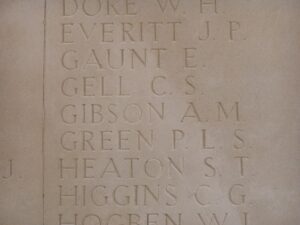
Denis Joseph Gleeson, Private, 74723, Machine Gun Corps. Dennis was born at Llanelli in December 1885, the son of Robert and Honorah Gleeson. The family later resided at 8, Albert St., Canton, Cardiff. Denis worked as a Clerk at Brains Brewery prior to the war, and had also served with the Glamorgan Yeomanry since 1911. During March 1916 he sailed with the Yeomanry for Egypt, where the Pembroke and Glamorgan Yeomanry formed the 4th Dismounted Brigade with the Welsh Border Mounted Brigade. On 2 February 1917 the regiment merged with the Pembroke Yeomanry to form the 24th (Pembroke and Glamorgan Yeomanry) Battalion, Welsh Regiment, which was attached to 231 Brigade, 74th (Yeomanry) Division, and took part in the Palestinian campaign before moving to France in May 1918. Denis was then attached to the 74th Battalion, Machine Gun Corps, which was attached to the 74th (Yeomanry) Division. He was killed during the Battle of Épehy on 23 September 1918. Denis was 32 years old, and is commemorated on the Vis-En-Artois Memorial, France.
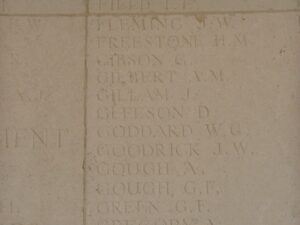
Henry William Glover, Private, 12906, Welsh Regiment. Henry was the son of Richard Montague and Martha Glover, of 6, Greenfield Villas, Llanelli. At the outbreak of war he joined the 3rd Welsh, and was posted to France in March 1915, where he joined the 1st Battalion, Welsh Regiment, which was attached to 84 Brigade, 28th Division. Henry was killed a month later, during the Second Battle of Ypres, on 18 April 1915. He was 21 years old, and is buried at Bedford House Cemetery, Belgium.
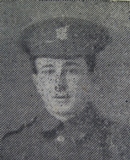
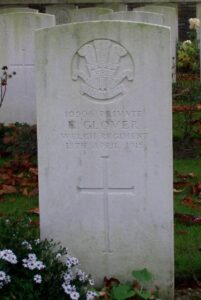
William George Gosling, Private, 12603, King’s Liverpool Regiment. William was the son of Sarah Gosling, of Roaden Pit, Stockland, Honiton, Devon. He worked at Llanelli as a miner prior to the war, and enlisted there into the army. William was posted to France, where he joined the 4th Battalion, King’s Liverpool Regiment, which was attached to 98 Brigade, 33rd Division. The Division moved to France during November 1915, and saw its first major action during the Battles of the Somme, from July 1916 onwards. William was killed on 5 July 1916. He was 34 years old, and is buried at Chocques Military Cemetery, France.
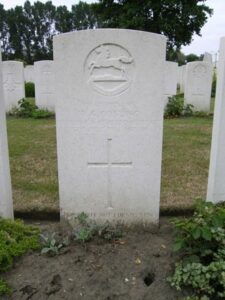
Harry Percy Bright Gough, MC and Bar, Major, Welsh Regiment. Harry was the son of Frederick George and Sarah Ann Gough, of Llanelli, and the husband of Martha Reid Gough (nee Fullerton). They had two children, and the family home was at The Firs, Gowerton, Swansea. Henry was educated at Llandovery College, played rugby at half-back both for Llanelli and Vale of Lune, Lancaster. At the outbreak of war, Henry was Science Master at Oakham Grammar School, but left to enlist in the 14th (Swansea) Battalion, Welsh Regiment. In 1915 Henry was commissioned and posted to the 17th Battalion, Welsh Regiment and in 1916 he was promoted to Captain, at the time of the Battalion’s departure for France. The Battalion joined 119 Brigade, 40th (Bantam) Division, and moved to the front near Loos. Late in 1916 they moved south to the Somme, and fought at the Battle of the Ancre, and remained in the area over the winter. In March 1917 the Germans withdrew to their shortened line, called the Hindenburg Line, and the 40th Division was one of the Divisions that followed the withdrawal. Henry distinguished himself in a successful action, south of La Vacquerie on 18 May, when a trench raid resulted in the capture of an enemy machine-gun and two unwounded prisoners, at no loss of life to his own men. For his part in the operation, Henry was awarded the Military Cross. During the autumn of 1917, his Battalion was in support of 12th SWB and 19th RWF in the attempt to capture the stronghold of Bourlon Wood, during the Battle of Cambrai. They suffered Heavy casualties, losing 17 officers and 301 other ranks. Henry found himself in command of the Battalion. He was awarded a Bar to his MC for his actions here, however, by this time the 17th Battalion had virtually ceased to exist. The Division was caught up in heavy fighting during the spring of 1918, during the German Offensive on the Lys. Henry was sent to command a section of the East Surrey Regiment, which was defending a support trench system running north to south through Strazeele, but on 22 April 1918 was severely wounded, and died at the 62nd London Casualty Clearing Station that day. He was 38 years old, and is buried at Arneke British Cemetery, France.
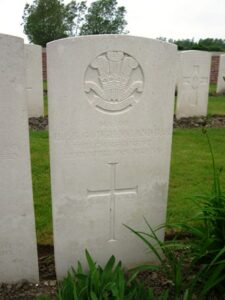
Alfred Goulder, Lance Corporal, 13478, Northumberland Fusiliers. Alfred was the son of Edwin and Elizabeth Goulder, of 6, Graham Street, Radford, Nottingham. He resided at Llanelli prior to the war, and enlisted back at Nottingham into the 12th Battalion, Northumberland Fusiliers, which was attached to 62 Brigade, 21st Division. The Division crossed to France during September 1915, and was thrown into action at Loos within weeks. Alfred was killed at the Battle of Loos on 25 September 1915. He was 22 years old, and is commemorated on the Loos Memorial, France.
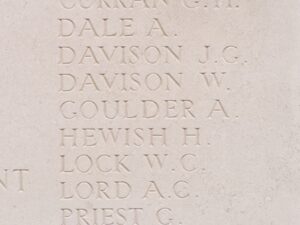
Albert Graham, Lance Corporal, 12695, Welsh Regiment. Albert was a Boer War veteran from York, who had moved to Llanelli prior to the war, and lived there with his wife, Mary Catherine Graham (nee Evans) and three children, at 33, Copperworks Road, Llanelli. Albert was recalled at the outbreak of war, and joined the 2nd Battalion, Welsh Regiment, which moved to France attached to 3 Brigade, 1st Division. The Division took part in the Battle of Mons, and the retreat to the Marne, where the Germans were stopped. They then fought at the Aisne, and at Chivy, before being moved north to Ypres. Here they fought at the First Battle of Ypres, where they again stopped the German Offensive, before wintering in Flanders. The following year saw them in action again at the Battle of Aubers, before moving South to Loos, where they fought during the Battle of Loos. Albert was killed at Loos on 25 September 1915. He is commemorated on the Loos Memorial, France.
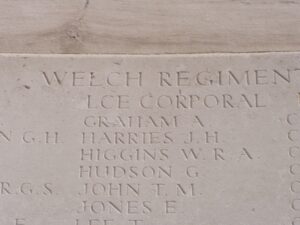
Isaac Grant, Stoker, 6542S, Royal Navy. Isaac was born on 3 February 1886, the son of John and Hannah Grant, of Llanelli. He married Blodwen Evans in 1908, and the couple raised two children at 3, Robinson Street, Llanelli. Isaac served with the Royal Navy aboard HMS Indefatigable, which was attached to the Battlecruiser Squadron of the Grand Fleet. Isaac was killed when Indefatigable was blown up at the Battle of Jutland on 31 May 1916, with the loss of all but two of her crew. He was 30 years old, and is commemorated on the Plymouth Naval Memorial, Devon.
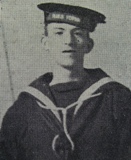
Oswald Robert John Green, Lieutenant, Welsh Regiment. Oswald was the son of William Arthur and Sophia Green of the Foundry, Aberystwyth, and the husband of Winifred Gwendoline Green, of Buchland House, Neath Abbey, Neath. George was educated at Jasper House and Aberystwyth University. He was a Holder of the Royal Humane Society Medal for life saving from drowning, and always to the fore in local sport, excelling swimming, cricket, golf and especially football. He was a successful captain of Aberystwyth Town Football Club prior to the war and spurned many offers to turn professional. Oswald returned from America at the end of 1914 to take up a commission in the 9th Battalion, Welsh Regiment, which was attached to 58 Brigade, 19th (Western) Division. The Division moved to France during July 1915, and moved to positions near Loos, where it took part in the opening attack of the Battle of Loos on 25 September 1915. The following year the Division moved to the Somme, where it took part in the second wave of the attack on Ovillers-La Boiselle on 1 July 1916, capturing the village at heavy cost. The 9th Welsh had played a big part in the taking of Ovillers, but Oswald had been mortally wounded. He died on 5 July 1916, aged 35, as a result of his wounds, and is buried at Heilly Station Cemetery, Mericourt-L’Abbe, France. His sister was the wife of Maurice Thomas, of Norwood, Old Castle Road, Llanelli.
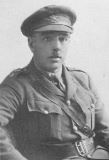
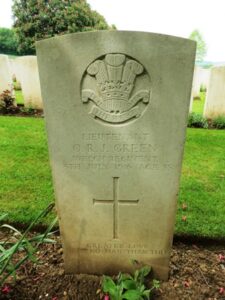
Zedekiah Green, Driver, 98325, Royal Field Artillery. Zedekiah was born at Silkstone, Yorkshire, and enlisted at Llanelli into the Royal Artillery. He was posted to the 83rd Small Arms Ammunition Column, Royal Field Artillery, which was attached to the 28th Division. During October 1915, the Division embarked at Marseilles, and proceeded to Egypt, and in November moved on to Salonika where the Division then remained. Zedekiah was taken ill in Salonika, and died on 13 September 1917, aged 32. He is buried at Mikra British Cemetery, Kalamaria, Greece.
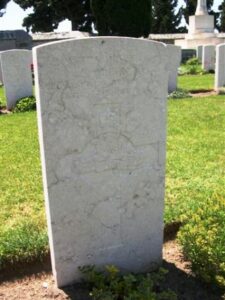
Thomas Walter Greenwood, Private, 288065, Welsh Regiment. Thomas was the son of Thomas and Emily Greenwood, of Leicester. He resided at Llanelli prior to the war, and enlisted at Swansea into the 1/6th Battalion, Welsh Regiment. The battalion landed in France on 29 October 1914, and moved to work on Lines of Communication. On 5 July 1915 it was attached to 84 Brigade, 28th Division, before transferring to the 1st Division, where it became the Pioneer battalion. They fought during the Somme Offensive in 1916. The Division followed the German retreat to the Hindenburg Line in early 1917, and were then briefed for an operation on the Flanders Coast, and moved there during the summer of 1917. Thomas was killed here on 2 July 1917. He was 42 years old, and is buried at Ramscappelle Road Military Cemetery, Belgium.
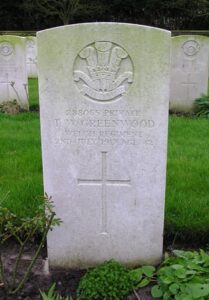
William Llewelyn Griffith, Second Lieutenant, Welsh Regiment. William was the son of Alfred Howell Griffith and Alice Mary Griffith, of 12, Brookfield Terrace, Caerphilly. He had been educated at St. Oswald’s College, Ellesmere before moving to Llanelli to train as an engineer at the Glanmor Engineering Works. William enlisted into the Public Schools Battalion, Royal Fusiliers, and served with it in France from 14 November 1915. He saw action during the attacks on High Wood, during the Battle of the Somme, and on 4 August 1916 was commissioned into the 9th Battalion, Welsh Regiment. The battalion was attached to 58 Brigade, 19th Division, and had seen heavy fighting on the Somme that year before moving to positions south of Ypres. William would have seen his first action with the 9th Welsh during the Battle of Messines in June 1917, and the battalion remained in the area over the coming months, before taking part in the Battle of the Menin Road. William was wounded during the battalions’ assault on Hessian Wood on 20 September 1917. He was evacuated to Locre, where he died of his wounds on 22 September 1917, aged 22. William is buried in Locre Hospice Cemetery, Belgium. William is possibly the man named at H L Griffiths on the County memorial roll.
D. J. Griffiths, Private. This man cannot presently be identified.
David Griffiths, Private, 20584, Welsh Regiment. David was the son of William and Harriet Griffiths of Llanelli. He enlisted during a recruitment drive at Llanelli in February 1915 into the 15th Battalion, Welsh Regiment, which was known as the Carmarthen Pals battalion. The battalion initially trained at Rhyl, suffering from severe shortages of equipment. David took ill at Rhyl, and died in hospital at Bangor on 22 June 1915. He was 35 years old, and is buried at Bangor (Glanadda) Cemetery.
David Arthur Griffiths, Ordinary Seaman, Z/5091, Royal Navy. David was born on 22 June 1900, the son of David and Ellen Griffiths, of 2, Annesley Street, Llanelli. He was a Boy Writer at Pembroke Dockyard, prior to serving as Ordinary Seaman in the Royal Navy, at HMS Victory VI. The base was a training base for recruits, based at Crystal Palace. David took ill while training here, and died of pneumonia on 14 October 1918. He was only 18 years old. His remains were brought home for burial at Box Cemetery, Llanelli.
David John Griffiths, Private, 13134, Welsh Regiment. David was the son of William and Bridget Griffiths, of 7, Cornish Place, New Dock. He enlisted at Llanelli into the 9th Battalion, Welsh Regiment, which was attached to 58 Brigade, 19th (Western) Division. David landed in France with the battalion on 1 June 1915. He fought at the Battle of Loos in September that year, and over the winter took ill, and returned home. David died on 7 May 1916, aged 31. He is buried at Llanelli (Old Road) Church Cemetery.
Frank Griffiths, Sapper, 204515, Royal Engineers. Frank was born in Burry Port, the son of David John Gibson Griffiths and Caroline Griffiths. The family later resided at 32, Hedley Terrace, Llanelli. He enlisted at Llanelli into the 134th Army Troops Company, Royal Engineers. The Army Troops Companies were established similar to Field Companies, but for behind-the-lines bridging and water work. Frank was at Ypres during the Battle of Passchendaele, when he was killed in action on 4 October 1917. He was just 20 years old, and is buried at Canada Farm Cemetery, Belgium.
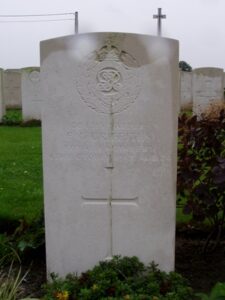
H. L. Griffiths, Lieutenant, Royal Air Force. This man cannot presently be identified, but is possibly William Llewelyn Griffith, above.
James Griffiths, Private, 39580, South Wales Borderers. James was the son of David and Dinah Griffiths, of 15, Clifton Terrace, Llanelli. He worked at the Emporium, Llanelli, and The Hayes, Cardiff prior to the war. James enlisted at Carmarthen into the Pembroke Yeomanry in 1916, and was posted to France, where he joined the 2nd Battalion, South Wales Borderers, which was attached to 87 Brigade, 29th Division. James probably fought at Third Ypres with the battalion, during the late summer of 1917. The 2nd SWB remained at Ypres over the winter, and it was here, during a routine spell in the trenches, that James was killed by a German shell on 22 March 1918, while leading his gun team out of the line after a six day spell. He was 24 years old, and was buried at Oxford Road Cemetery, Belgium.
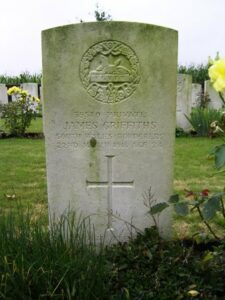
John Henry Griffiths, Private, 4035, London Regiment. John was the son of John and Mary Esther Griffiths, of Trevethin-y-Graig, Pwll, Llanelli. He worked at London prior to the war, and enlisted into the 15th Battalion, London Regiment, which was known as the Civil Service Rifles, attached to 140 Brigade, 47th (2nd London) Division. The battalion landed in France on 18 March 1915, and fought at the Battle of Aubers, and the Battle of Festubert during May 1915 and in September fought at the Battle of Loos, and subsequent Action of Hohenzollern Redoubt. They were north of Arras when the Germans attacked Vimy Ridge, and then moved south to the Somme, where they fought at the Battle of Flers-Courcelette. John was killed here on 15 September 1916. He was 20 years old, and is buried at Cerisy-Gailly French National Cemetery, France.
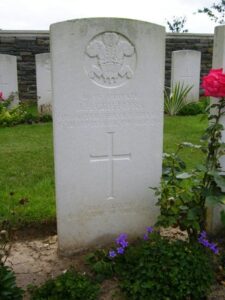
Martin Griffiths, Private, 13331, South Wales Borderers. Martin was the son of Anthony and Rebecca Griffiths, of 2, Bethania Terrace, Llanelli. He enlisted at Llanelli into the 4th Battalion, South Wales Borderers, which was attached to 40 Brigade, 13th (Western) Division. The Division fought at Gallipoli from July 1915 onwards, suffering heavy casualties over the coming months. Martin doesn’t look to have served overseas, but took ill, and died at Gloucester on 14 December 1915. He was 30 years old, and is buried at Loughor (St. Michael) Churchyard.
Rhys Emlyn Griffiths, Private, 428, Australian Imperial Force. Rhys was born at Llanelli in June 1892, the son of Maggie Griffiths. Maggie later lived at 4, Vlei Street, Krugersdorp, Transvaal, South Africa, while Rhys moved to 67, Union Road, Ascot Vale, NSW, Australia. Rhys enlisted at Melbourne on 19 August 1914 into the 7th Battalion, Australian Imperial Force. The battalion was raised by Lieutenant Colonel H. E. Pompey Elliott within a fortnight of the declaration of war in August 1914 and embarked just two months later. After a brief stop in Albany, Western Australia, the battalion proceeded to Egypt, arriving on 2 December. It later took part in the ANZAC landing on 25 April 1915, as part of the second wave. Rhys was killed in action during the desperate attempt to get off the beaches that day. He was 24 years old, and is commemorated on the Lone Pine Memorial, Gallipoli.
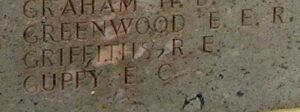
Royston Swire Griffiths, Major, Royal Garrison Artillery. Royston was born at Pembrey on 8 November 1885, the son of William and Edith Griffiths. He married Gladys Edwards in March 1912, and the couple lived at 27, Barnfield Road, Exeter. Royston enlisted into the Royal Marines on 24 September 1914, and joined the Royal Marine Engineers. He was discharged to a commission in the Royal Artillery on 12 January 1915, and was posted to 123rd Siege Battery, Royal Garrison Artillery, moving to France on 21 July 1916. Royston must have been a capable officer, as he was promoted to Acting Major by 1917. He became ill in France, suffering an embolism, which killed him on 17 March 1917. Royston was 31 years old, and is buried at Faubourg D’Amiens Cemetery, Arras, France.
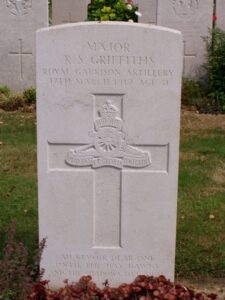
W. Griffiths, Seaman, Royal Navy. This man cannot presently be identified.
William James Griffiths, Gunner, W/5476, Royal Field Artillery. William was born at Llanelli, and enlisted there into the Welsh Royal Artillery. He was posted to France with B Battery, 107th Brigade, Royal Field Artillery, which was attached to the 24th Division. William was killed during the Battle of Messines on 14 June 1917. He is buried at Railway Dugouts Burial Ground, Belgium.
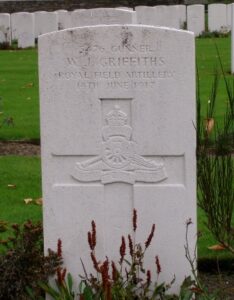
Robert John Guy, Private, 4538, Monmouthshire Regiment. Robert was born in 1898, the son of John and Mary Guy, of Penallt Road, Llanelli. He enlisted on 1 May 1916 into the 1st Battalion, Monmouthshire Regiment, which was a Territorial unit, which became one of the first TA battalions to move to France on 13 February 1915. It is not known if Robert served in France, but he was discharged on 15 September 1916 due to sickness. He survived the war, but died on 23 February 1921, aged 23, after an accident at work. He is not eligible for commemoration by the CWGC.
David Gwilym, Private, 52896, Welsh Regiment. David was the son of John and Ann Gwilym, of 11, Cambrian Cottage, Llanelli. He enlisted at Cardiff into the Welsh Regiment, and was posted to Egypt in 1917, where he joined the 24th Battalion, Welsh Regiment. The battalion had been formed by the merger of the Pembroke and Glamorgan Yeomanry battalions in March 1917, becoming attached to 231 Brigade, 74th (Yeomanry) Division. In April 1917 the Division moved into Palestine, where it fought at the Second and Third Battles of Gaza, and the capture of Jerusalem. During the following year it took part in several smaller operations in the Jordan Valley, and it was there that David was killed on 10 March 1918, aged 29. He is buried at Jerusalem War Cemetery, Israel.
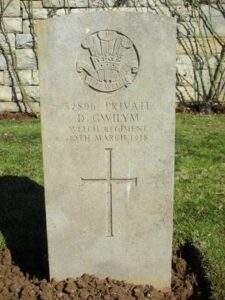
Clarence John Hallam, Private, G/25487, Queen’s Royal West Surrey Regiment. Clarence was born at Hanley, Staffordshire in 1882, the son of John and Mary Hallam. He resided at Llanelli prior to the war, working as a baker for the GWR. He enlisted there into the Army Service Corps, but was later posted to a battalion of the Queen’s Royal West Surrey Regiment. Clarence was then posted to the 1/22nd Battalion, London Regiment, which was attached to 142 Brigade, 47th (2nd London) Division. The Division fought at Aubers, and Festubert during May 1915 and in September fought at the Battle of Loos. They were north of Arras when the Germans attacked Vimy Ridge, and then moved south, taking part in the Somme offensive. Early in 1917 the Division moved north to Belgium, and took part in the Battle of Messines, and then in November 1917 fought at the Battle of Cambrai. In March 1918 the Division were situated near St. Quentin, and faced the German Spring Offensive here on 21 March, fighting at the Battle of St Quentin, and then in the rearguard action at the First Battle of Bapaume. Clarence was killed here on 4 April 1918, aged 36, and is buried at Martinsart British Cemetery, France. Clarence is not commemorated locally.
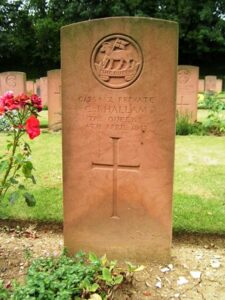
Edward Douglas Maine Hallam, Corporal, 290338, Pembroke Yeomanry. Edward was the son of William and Martha Hallam, of Llanelli. He originally enlisted at Farnborough into the Royal Flying Corps on 1 November 1915, but was discharged within days. He re-enlisted at Llanelli into the Pembroke Yeomanry, and served on Home Service with their 2/1st Battalion. Edward took ill towards the end of the war, and died at York on 5 December 1918, aged 24. He is buried at Llanelli (Old Road) Church Cemetery.
Thomas Pryce Hamer, Lieutenant, South Wales Borderers. Thomas was the son of Edward and Martha Hamer, of Summerfield Park, Llanidloes, Montgomeryshire. He was a local celebrity prior to the war, and played association football for Llanelli for two seasons, and had represented Wales at international level, as well as being a wealthy industrialist. He was commissioned on 1 April 1915, and joined the 11th Battalion, South Wales Borderers in France, which was attached to 115 Brigade, 38th (Welsh) Division. The Division had landed in France during December 1915 and had spent their first winter in the trenches near Armentieres. In June they marched south to the Somme, where they were tasked with the capture of Mametz Wood. The attack on the wood began on 7 July, but met with fierce resistance, and it took until 14 July to totally clear the wood. Thomas was killed during the first attack on the Wood, on 7 July 1916. He was 33 years old, and is commemorated on the Thiepval Memorial, France.
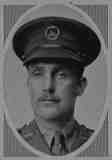
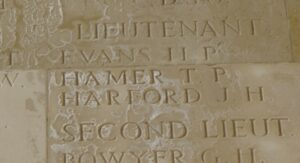
Benjamin James Hanbury, Private, 49782, Welsh Regiment. Benjamin was the son of Benjamin and Emily Hanbury, of 81, James Street, Llanelli. He enlisted at Llanelli into the 1/4th Battalion, Welsh Regiment, which was the local Territorial Battalion, attached to 159 Brigade, 53rd (Welsh) Division. The Division landed at Cape Helles, Gallipoli, on 9 August 1915, and was immediately thrown into action, spending the next few days in isolated pockets, fighting against a Turkish counter-attack during the Battle of Sari Bair, and then at the Attack on Scimitar Hill. The Division remained here throughout the coming months, and suffered severe losses in manpower strength during the great November 1915 blizzard on Gallipoli, when its total strength was reduced to less than that of a full-strength Brigade. On 11 December 1915 the Division was evacuated to Mudros, and by 23 December 1915 were moved to Egypt. They remained on the Suez Canal Defences for the next twelve months, where it took part in operations against the Sultan of Darfur, and in March 1917 took part in the advance into Palestine. Benjamin was discharged Category E on 14 October 1919, and died during the last Quarter of 1920, aged 27. No more is known of him, as he is not commemorated by the CWGC.
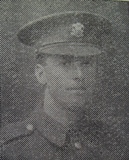
William Henry Hancock, Private, Royal Marine Light Infantry. William was the son of Thomas and Sarah Hancock, of 73, New Dock Road, Llanelli. He served with the Royal Marine Light Infantry aboard the dreadnought battleship HMS Neptune during the war. Nothing else is known of William, but he possibly died on 14 March 1921, aged 25, and is buried in Stoke-on-Trent (Hanley) Cemetery.
Albert Clarence Handley, Private, 190224, Royal Garrison Artillery. Albert was born at Kidderminster in March 1893, the son of David and Sarah Handley. The family had moved to Llandebie by 1911, before Albert found work at Llanelli. He enlisted there into the Royal Garrison Artillery. Albert was posted to France with the 405th Siege Battery, Royal Garrison Artillery. He died during the time of the Battle of the Lys, on 12 July 1918, aged 25, and is buried at Aubigny Communal Cemetery Extension, France.
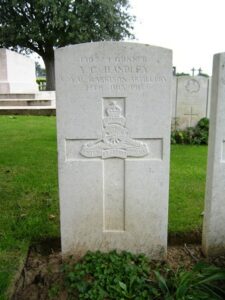
James Harland, Private, 26528, Welsh Regiment. James was the son of Marshal and Caroline Harland, of Long Row, Llanelli. He enlisted at Cardiff into the army, and was posted to France, where he joined the 2nd Battalion, Welsh Regiment, which was attached to 3 Brigade, 1st Division. James was probably in France by early 1916, and would have fought with the Division on the Somme that year. They followed the German retreat to the Hindenburg Line in early 1917, and then moved to the Flanders Coast. While training on the coast, the Battle of Third Ypres had stalled in the mire, and the Division was recalled to Ypres, where they fought at the Second Battle of Passchendaele. After spending another winter in Flanders, they were near Estaires when the German Spring Offensive caught them, fighting through the Battles of Estaires, Hazebrouck, and Bethune before being moved south again to Arras, fighting at the Battle of Drocourt-Queant, and at the Battle of Epehy, after the tide had been turned in the favour of the Allies. The Division pushed on towards the St. Quentin Canal. James was killed on 22 September 1918, aged 36, during the advance on the Hindenburg Line. He is buried at Marteville Communal Cemetery, Attilly, France. His brother William had been killed on the Somme two years previously.
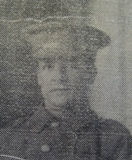
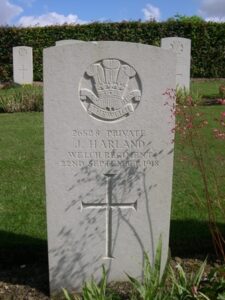
William Joseph Harland, Private, 13668, Welsh Regiment. William was born in 1880, the son of Marshal Harland and Caroline Harland (nee Williams), of New Buildings, Long Row, Llanelli. He had played rugby for the Scarlets at forward prior to the war. William enlisted at Llanelli into the 9th Battalion, Welsh Regiment soon after the outbreak of war. The battalion had formed at Cardiff in September 1915, moving to Salisbury Plain to join 58 Brigade, 19th (Western) Division. The battalion embarked for France with the division on 18 July 1915, and the division moved to positions north of Loos in the Givenchy area, to begin trench initiation and training. The division then took part in a very costly diversionary attack here on 25 September 1915, intending to draw German attention away from the main assault at Loos. The Division remained in Flanders until being relieved at the end of April 1916 and moved into the rear areas around Flesselles for training, then in the middle of June moved into the Somme sector, near Albert, where it took part in the second wave of the attack on Ovillers-La Boiselle on 2 July, capturing the village at heavy cost and remained in the line for several days before being relieved. After a brief rest the 19th Division then moved into the shattered remains of Mametz Wood on 21 July, in readiness for another assault, moving into positions at Bazentin-le-Petit on 23 July, in support of the 9th RWF. The men worked hard over the coming days, digging new communication trenches, in terrible conditions. William was killed in action here during a particularly heavy German artillery barrage which hit the battalion on 24 July 1916. The 36-year-old has no known grave and is commemorated on the Thiepval Memorial, France. His brother James was killed in France two years later, whilst another brother, Thomas, died in 1925 as a result of illness contracted during the war.
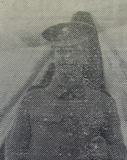
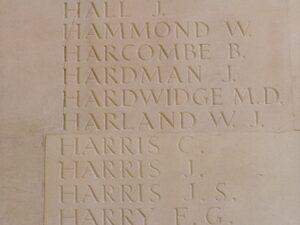
George Harney, Private, 12376, Royal Welsh Fusiliers. George was the son of James and Adelaide Harney, of Manchester, and the husband of Ellen Harney, of Glanmor Road, Llanelli. He worked as a Moulder at the South Wales Works, at Llanelli prior to the war, and enlisted at Llanelli into the 8th Battalion, Royal Welsh Fusiliers. The battalion was attached to 40 Brigade, 13th (Western) Division. On 13 June 1915 the Division sailed for Alexandria, and moved to Mudros before being landed at Cape Helles, Gallipoli from 6 July 1915, relieving the 29th Division. George was killed here during the Battle of Sari Bair, on 6 August 1915. He was 35 years old, and is buried at Shrapnel Valley Cemetery, Gallipoli.
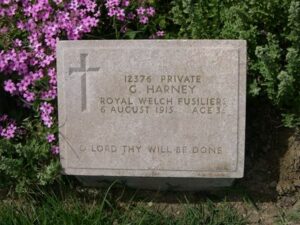
Frank Harris, Private, 31819, Royal Welsh Fusiliers. Frank was the son of Arthur and Annie Harris, of Dantzic Cottage, Tremont Road, Llandrindod Wells. He resided at Llanelli prior to the war, and enlisted at Llandrindod Wells on 29 June 1915 into the 3rd Battalion, Royal Welsh Fusiliers. Frank was posted to France on 30 September 1915, where he joined the 1st Battalion, Royal Welsh Fusiliers, which was attached to 22 Brigade, 7th Division. In the summer of 1916, the Division were on the Somme, and took part in the Battle of Albert, where they captured Mametz, one of the few successes of 1 July 1916. Frank was killed that day. He was 18 years old, and is buried at Dantzig Alley British Cemetery, Mametz, France.
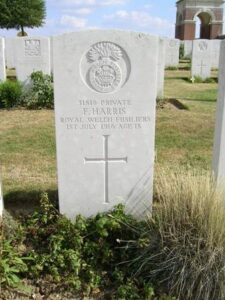
John Harries, Private, 235444, King’s Own Yorkshire Light Infantry. John was the son of Mrs. Isabella Harries, of 6, Island Place, Llanelli. He enlisted at Llanelli into the army, and served with the Middlesex Regiment, before being transferred into the 2/4th Battalion, King’s Own Yorkshire Light Infantry, which was attached to 187 Brigade, 62nd (2nd West Riding) Division. The Division concentrated in France during January 1917, and followed the German Retreat to the Hindenburg Line. They fought at Arras, and the Battle of Cambrai later that year. On 5 January 1918, the Division took over the front line in the Arras area, between Gavrelle and Oppy. The enemy launched a major offensive on 21 March 1918, and the Division saw heavy fighting for the next week. The Division was then relieved and moved to the Aisne, where it saw further heavy fighting during the Battle of the Tardenois, where the Division took part in the fighting for the Ardre Valley. From 25 August 1918 the Division took part in the great advance on the Somme, and fought through the Hindenburg Line towards Le Cateau. John was captured by the Germans at some time, and died in captivity on 24 October 1918. He was 26 years old, and is buried at Mons Communal Cemetery, Belgium.
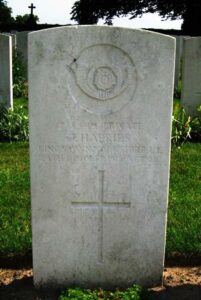
Joseph Harries, Private, 33742, Welsh Regiment. Joseph was the son of Josiah and Mary Harries, of St. David’s Cottages, Incline, Dafen, Llanelli. He enlisted there into the 9th Battalion, Welsh Regiment, which was attached to the 58th Brigade, 19th (Western) Division. The Division crossed to France between the 11th and the 21st July 1915, and moved to positions near Loos. The Division fought during the opening attack of the Battle of Loos, and then moved to the Somme, where they took part in the second wave of the attack on Ovillers-La Boiselle on the 1st July, capturing the village at heavy cost, and fought through the Somme Battles of Pozieres and the Ancre in 1916. They then moved north to Ypres, taking part in the Battle of Messines, where Joseph was wounded. He died of wounds on 8 June 1917, aged just 20, and is buried at Lijssenthoek Military Cemetery, Belgium. His brothers Josiah and William also fell.
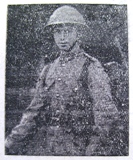
Josiah Harries, Private, 5728, Royal Warwickshire Regiment. Josiah was the son of Josiah and Mary Harries, of St. David’s Cottages, Incline, Dafen. He enlisted at Llanelli into the Welsh Regiment, but later transferred into the 2/7th Battalion, Royal Warwickshire Regiment, which was part of the 182nd Brigade, 61st (2nd South Midland) Division. This Second Line Territorial Division was formed in January 1915, composed of the Home Service units of the associated First Line 48th (South Midland) Division. Men of the First Line who did not undertake the Imperial Service Obligation were transferred to these units. Early clothing and equipment for these men was haphazard to say the least. Many had to train in civilian clothes and it was only between November 1915 and March 1916 that proper equipment was received. The battalion moved to and trained in the Chelmsford area from April 1915, moving on to Salisbury Plain in January 1916. The introduction of the Military Service Act 1916 cleared the way for the Second Line units to be sent overseas, and the Division entrained for the Western Front on the 21st May 1916, moving to positions at Fromelles. The first major action in which the Division was engaged turned out to be a disaster. An attack was made on the 19th July 1916 at Fromelles, a subsidiary action to the much larger battle taking place further south on the Somme. The Division suffered very heavy casualties for no significant gain and no enemy reserves were diverted from the Somme. Josiah was killed in action here on 17 July 1916, aged 24, and is buried at Laventie Military Cemetery, La Gorgue, France. His brothers Joseph and William also fell.
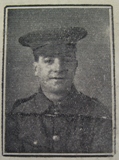
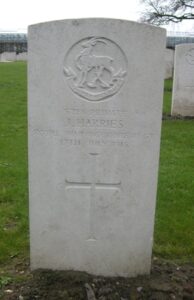
Thomas Harries, Private, 13164, Royal Welsh Fusiliers. Thomas was the son of William and Catherine Harries, of Coed-y-Cefn, Sandy Road, Llanelli. He worked for the Great Western Railway at Pembrey prior to the war, and married Elizabeth Evans in 1912. She later moved to 110, Conran Street, Harpurhey, Manchester. Thomas enlisted at Llanelli into the 9th Battalion, Royal Welsh Fusiliers, which was attached to 58 Brigade, 19th (Western) Division. The Division crossed to France between 11 and 21 July 1915, and moved to positions near Loos, where it took part in the opening attack of the Battle of Loos on 25 September 1915. The following year the Division moved to the Somme, where it took part in the second wave of the attack on Ovillers-La Boiselle on 1 July, capturing the village at heavy cost. Thomas was killed here by shrapnel on 3 July 1916, and was buried on the battlefield by his friend, Sid Phillips of Llanelli. He was 26 years old, and is today commemorated on the Thiepval Memorial, France, as his grave was lost during further fighting over the area.
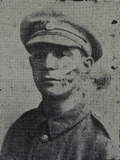
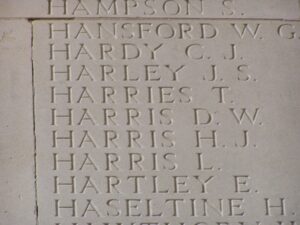
Thomas Harries, Private, 91688, Durham Light Infantry. Thomas was the son of John and Mary Ann Harries, of New Road, Pwll. He enlisted at Llanelli into the Pembroke Yeomanry, then transferred into the Welsh Regiment, before being reposted to the 1/6th Battalion, Durham Light Infantry, which was attached to 151 Brigade, 50th (Northumbrian) Division. He probably joined the battalion in the spring of 1918, after it had been hard hit by the German Spring Offensive of 21 March 1918, during the Battle of St Quentin. They took part in a gallant rearguard action during the Actions at the Somme Crossings, and then at the Battle of Rosieres. After suffering terrible casualties, the Division moved north to Flanders to rest and rebuild, but in April the Germans launched an attack in Flanders, around the Lys, and the Division took part in the Battle of Estaires, and the Battle of Hazebrouck. Following a most trying time on the Somme and Lys battlefields, the Division was withdrawn and sent to IX Corps, then on the Aisne, believed to be a much quieter area. This was unfortunately not the case, as the Division was hit hard by a surprise enemy attack, and fought at the Battle of the Aisne 1918. Thomas was killed here on 28 July 1918, aged 34. He is buried at Glageon Communal Cemetery Extension, France.
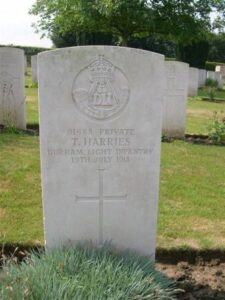
Thomas Daniel Harries, Private, 201213, Welsh Regiment. Thomas was the son of Morgan and Eleanor Harries, of 22, Ropewalk Road, Llanelli. He enlisted at Llanelli into the 1/4th Battalion, Welsh Regiment, which was the local Territorial Battalion, attached to 159 Brigade, 53rd (Welsh) Division. The Division landed at Cape Helles, Gallipoli, on 9 August 1915, and was immediately thrown into action, spending the next few days in isolated pockets, fighting against a Turkish counter-attack during the Battle of Sari Bair, and then at the Attack on Scimitar Hill. The Division remained here throughout the coming months, and suffered severe losses in manpower strength during the great November 1915 blizzard on Gallipoli, when its total strength was reduced to less than that of a full-strength Brigade. On 11 December 1915 the Division was evacuated to Mudros, and by 23 December 1915 were moved to Egypt. They remained on the Suez Canal Defences for the next twelve months, where it took part in operations against the Sultan of Darfur, and in March 1917 took part in the advance into Palestine. Thomas was killed here during the First Battle of Gaza, on 26 March 1917. He was 21 years old, and is commemorated on the Jerusalem Memorial, Israel.
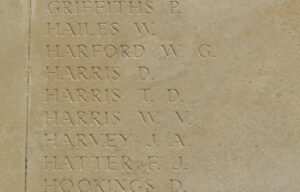
William John Harries, Private, 21539, South Wales Borderers. William was the son of Josiah and Mary Harries, of St. David’s Cottages, Incline, Dafen, Llanelli. He enlisted into the 11th Battalion, South Wales Borderers, which was attached to the 115th Brigade, 38th (Welsh) Division. The Division had landed in France during December 1915 and had spent their first winter in the trenches near Armentieres. In June they marched south to the Somme, where they were tasked with the capture of Mametz Wood. The attack on the wood began on the 7th July, but met with fierce resistance, and it took until the 11th July to clear the wood. William was killed during the first attack on the wood, on 7 July 1916. He is buried at Flatiron Copse Cemetery, Mametz, France. His brothers Joseph and Josiah also fell.
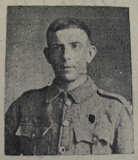
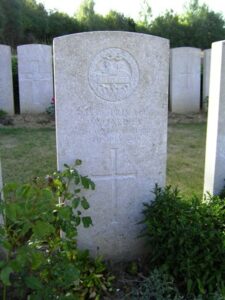
William J. Harries, Private, 200091, Welsh Regiment. William served with the 1/4th Battalion, Welsh Regiment, which was the local Territorial Battalion, attached to 159 Brigade, 53rd (Welsh) Division. The Division landed at Cape Helles, Gallipoli, on 9 August 1915, and was immediately thrown into action, spending the next few days in isolated pockets, fighting against a Turkish counter-attack during the Battle of Sari Bair, and then at the Attack on Scimitar Hill. The Division remained here throughout the coming months, and suffered severe losses in manpower strength during the great November 1915 blizzard on Gallipoli, when its total strength was reduced to less than that of a full-strength Brigade. On 11 December 1915 the Division was evacuated to Mudros, and by 23 December 1915 were moved to Egypt. They remained on the Suez Canal Defences for the next twelve months, where it took part in operations against the Sultan of Darfur, and in March 1917 took part in the advance into Palestine. He was discharged, Category E, on 28 April 1919, and died in 1920, as a result of his wounds. No more is currently known about William, as he is not commemorated by the CWGC.
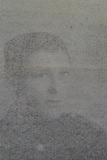
William George Harris, Private, 4081, Welsh Regiment. William was the son of Elias Charles Harris and Margaret Harris, of 12, Raby Street, Llanelli. He enlisted at Llanelli into the 1/4th Battalion, Welsh Regiment, which was the local Territorial Battalion, attached to 159 Brigade, 53rd (Welsh) Division. The Division landed at Cape Helles, Gallipoli, on 9 August 1915, and was immediately thrown into action, spending the next few days in isolated pockets, fighting against a Turkish counter-attack during the Battle of Sari Bair. William was killed during the latter stages of the campaign, on 16 November 1915. He was 24 years old, and is buried at Lala Baba Cemetery, Gallipoli.
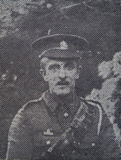
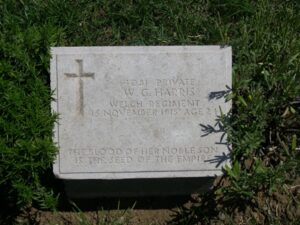
William Reginald Harries, Third Engineer, Mercantile Marine. William was the son of Thomas and Jane Harries. The family had lived at Llanelli for many years before moving to 2, Sea View Terrace, Cadoxton, Barry. William was educated at Cadoxton and Barry Schools before taking up an engineering apprenticeship at the Taff Vale Engineering Works. He then began a career in the Mercantile Marine, and was posted aboard the S.S. Emma. On 20 April 1917 the S.S. Emma was on route from Baltimore for the Clyde, carrying a cargo of grain, when she was torpedoed and sunk by the German submarine U-50. William was 22 years old when he died that day, and is commemorated on the Tower Hill Memorial, London.
George Frederick Harry, Private, 27800, Hampshire Regiment. George was the son of Fred and Matilda Harry, of Parnell Road, Bristol, and resided at Llanelli prior to the war. He enlisted at Clevedon, Somerset into the army, and was posted to the 2nd Battalion, Hampshire Regiment, which was in France attached to 88 Brigade, 29th Division. The Division moved to the Western Front on 15 March 1915, seeing its first major action in France during the 1916 Somme Offensive. In the Spring of 1917 they fought at the Battle of the Scarpe, which was part of the Arras Offensive, and then moved further north to Ypres. George was killed during the Battle of Polygon Wood, on 27 September 1917, aged 29. He is commemorated on the Tyne Cot Memorial, Belgium.
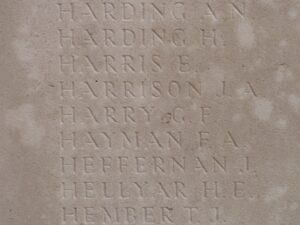
William John Hawkins, Lance Corporal, 38185, Welsh Regiment. William was the son of William and Emma Hawkins, of Droitwich. He had married by 1905, and lived with his wife, Emma Hawkins (nee Roberts), and their daughter Annie, at 1, Laburnum Cottage, Swansea Road, Llanelli. William had served during the Boer War of 1899-1902. He enlisted at Llanelli into the 8th Battalion, Welsh Regiment, the Pioneer battalion to the 13th (Western) Division. On 13 June 1915 the Division sailed for Alexandria, and landed at Gallipoli during July 1915, relieving the 29th Division. On 8 January 1916, the Division was evacuated from Helles, and by 31 January was concentrated at Port Said, where they held forward posts in the Suez Canal defences. On 12 February, 1916 the Division began to move to Mesopotamia, to strengthen the force being assembled for the relief of the besieged garrison at Kut al Amara. By 27 March, the Division had assembled near Sheikh Saad and came under orders of the Tigris Corps, and then took part in the attempts to relieve Kut. William took ill in Mesopotamia, and died on 21 June 1916, aged 36. He is buried at Amara War Cemetery, Iraq.
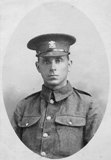
Arthur Hearn, Lance Corporal, 20418, Welsh Regiment. Arthur was the son of Thomas and Mary Hearn, of Castle Street, Northam, Devon. He enlisted at Llanelli into the 15th Battalion, Welsh Regiment, the Carmarthen Pals, which was attached to 114 Brigade, 38th (Welsh) Division. Arthur landed in France with the Battalion in December 1915, where it trained in the line near Fleurbaix. In June 1916 the 38th Division made the long march south to the Somme, where on 7 July 1916 it assaulted Mametz Wood. The initial assault was called off after heavy casualties, and a fresh attempt was made on 10 July. Over the next 48 hours, the Welshmen were embroiled in a titanic struggle in the wood, which fell on the night of 11/12 July 1916. Arthur was killed in the Wood on 11 July 1916. He was 28 years old, and is commemorated on the Thiepval Memorial, France.
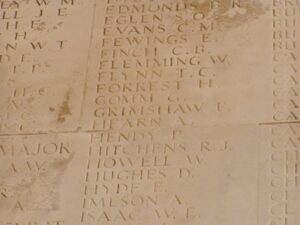
Charles Edwin Henry, Company Quarter Master Sergeant, 3319, Welsh Regiment. Charles was the son of Gavin and Eliza Henry, of Llanelli. He lived with his wife Sarah Henry (nee Lewis) at 16, Als Street, Llanelli in 1882, and had enlisted there into the Welsh Regiment Militia in 1900, and fought during the Boer War. At the outbreak of the Great War he was mobilised with the 1/4th Battalion, Welsh Regiment, which was the local Territorial Battalion, attached to 159 Brigade, 53rd (Welsh) Division. The Division landed at Cape Helles, Gallipoli, on 9 August 1915, and was immediately thrown into action, spending the next few days in isolated pockets, fighting against a Turkish counter-attack during the Battle of Sari Bair. Charles was killed here on 10 August 1915, aged 32. He is commemorated on the Helles Memorial, Gallipoli.
Ivor Thomas Henshaw, Private, 200910, Welsh Regiment. Ivor was the son of William and Mary Jane Henshaw, of the Boars Head, Swansea Road, Llanelli. He enlisted at Llanelli into the 1/4th Battalion, Welsh Regiment, which was the local Territorial Battalion, attached to 159 Brigade, 53rd (Welsh) Division. The Division landed at Cape Helles, Gallipoli, on 9 August 1915, and was immediately thrown into action, spending the next few days in isolated pockets, fighting against a Turkish counter-attack during the Battle of Sari Bair, and then at the Attack on Scimitar Hill. The Division remained here throughout the coming months, and suffered severe losses in manpower strength during the great November 1915 blizzard on Gallipoli, when its total strength was reduced to less than that of a full-strength Brigade. On 11 December 1915 the Division was evacuated to Mudros, and by 23 December 1915 were moved to Egypt. They remained on the Suez Canal Defences for the next twelve months, where it took part in operations against the Sultan of Darfur, and in March 1917 took part in the advance into Palestine. Ivor was killed during the First Battle of Gaza, on 21 April 1917. He was 26 years old, and is buried at Gaza War Cemetery, Israel. His cousin Thomas also fell.
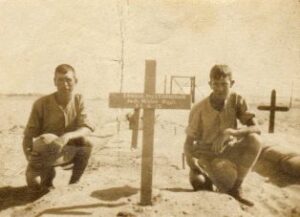
Thomas Henshaw, Private, 13179, Royal Welsh Fusiliers. Thomas was born on 10 September 1891, the son of David and Margaret Henshaw, of the Boars Head, Swansea Road, Llanelli. He enlisted at Llanelli into the 9th Battalion, Royal Welsh Fusiliers, which was attached to 58 Brigade, 19th (Western) Division. The Division crossed to France during July 1915, and moved to positions near Loos, where it took part in the opening attack of the Battle of Loos on 25 September 1915. Thomas was killed during the Divisions attack near Givenchy that day. He was 25 years old, and is commemorated on the Loos Memorial, France. His cousin Ivor also fell.
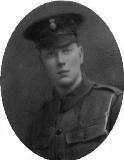
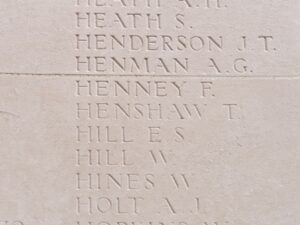
William Harold George Henshaw, Private, 7946, Royal Army Ordnance Corps. William was the son of David Henshaw (a policeman) and Mary Ann Henshaw, of 82, Swansea Road, Llanelli. He enlisted at Llanelli on 23 May 1915 into the Army Ordnance Corps, and was posted to Woolwich. He served there until discharged due to ill health on 22 April 1916 and returned to Llanelli. William died on 12 December 1917 aged 23 as a result of tuberculosis brought about by his military service. William is buried in Llanelli District Cemetery. He was accepted for commemoration by the CWGC on Saturday 26 April 2014 as a result of my research.
Benjamin Charles Esmond Herbert, Corporal, S4/161738, Royal Army Service Corps. Benjamin was the son of Benjamin and Ellen Herbert, of Harwood, New Road, Llanelli. He enlisted at Cardiff into the Army Service Corps, and was posted to the Middle East attached to the 1st Echelon, G.H.Q. Benjamin drowned in Egypt on 3 August 1918. He was 24 years old, and is buried at Alexandria (Hadra) War Memorial Cemetery, Egypt.
John Hirst, Private, 20791, Welsh Regiment. John was the son of Margaret Hirst, of 55, Villa Road, Oldham. Margaret had since married, and had four more children with her husband Anthony King. John lived at 13, Water Street, Llanelli prior to the war, where he worked as a Haulier. John enlisted at Llanelli on 17 March 1915 into the 15th Battalion, Welsh Regiment, which was known as the Carmarthen Pals battalion, attached to 114 Brigade, 38th (Welsh) Division. On 2 December 1915 the battalion moved to France, and the entire Division moved to the Fleurbaix sector, where it was initiated into trench warfare. During June 1916 the Division marched south to the Somme, and on 7 July 1916 attacked Mametz Wood. The initial attack failed, and it was three days later, on 10 July, that a fresh attack was mounted. John was killed here on 11 July 1916, Aged 29. He was buried near Mametz Wood by a burial party from the 1st South Wales Borderers, but his grave was not located after the war, so John is commemorated on the Thiepval Memorial, France.
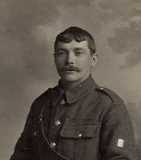
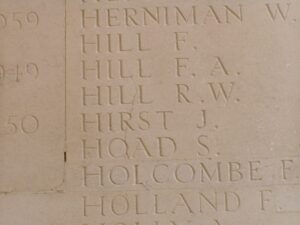
Clifton Samuel Hocking, Private, 8011, Gloucester Regiment. Clifton was the son of William and Elizabeth Hocking, of Truro, Cornwall. He was an army reservist and had moved to Prospect Place Llanelli, and was a Postman prior to the war. He rejoined the army at Llanelli in August 1914, and was posted to France with the 1st Battalion, Gloucester Regiment, which was attached to 3 Brigade, 1st Division. The division took part in the retreat from Mons to the Marne, and helped stem the German drive on Paris. It then took part in the advance from the Marne, and the subsequent Battle of the Aisne. Clifton was killed in action on the Aisne on 14 September 1914, aged 32. He has no known grave, and is commemorated on the La Ferte-Sous-Joarre Memorial, France.
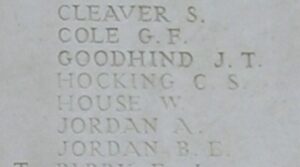
David Alfred Hodges, Z/2750, Ordinary Seaman, Royal Naval Reserve. David was born on 17 February 1896, the son of Thomas and Mary Hodges, of 41, Robinson Street, Llanelli. He worked for the GWR at Llanelli prior to the war, and enlisted into the Royal Naval Reserve on 24 December 1915, training as a Wireless Operator. He was posted to Milford Haven, where he served as a Wireless Operator aboard HM Trawler Imelda, which had been requisitioned by the Admiralty for use as a minesweeper. David survived the war, but died of tuberculosis on 3 June 1919, aged 23. He is buried with his parents at Box Cemetery, Llanelli. His details were passed to the CWGC by myself on 6 February 2013, and he has finally been accepted for commemoration by them on Friday 5 July 2013, after almost 94 years of being forgotten. David will be temporarily commemorated on the UK Book of Remembrance at Maidenhead, Berkshire, until the location of his grave can be verified.
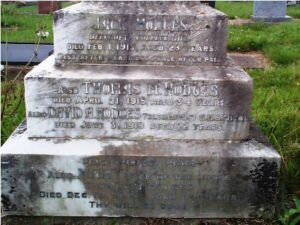
James Holland, Private, A/189, King’s Royal Rifle Corps. James was born at Grimsby. He worked for the GWR at Llanelli prior to the war, and enlisted there into the 8th Battalion, King’s Royal Rifle Corps, which was attached to 41 Brigade, 14th (Light) Division. The Division was to see its first action during the Action of Hooge, where the Division were the first to be attacked by the German use of flamethrowers. They then fought at the Second attack on Bellewaarde. James was killed at Hooge on 3 August 1915. He is commemorated on the Ypres (Menin Gate) Memorial, Belgium.
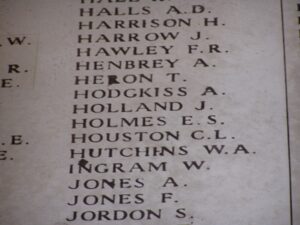
George Arthur Holt, Rifleman, 263013, Monmouthshire Regiment. George was the son of Benjamin Holt, of Leeds. He lived at Bont Farm, Abergwili prior to the war and enlisted at Carmarthen into the 4th Welsh Reserve Battalion in December 1914. George went AWOL in March 1916, and married Elizabeth Ada Davies, of 6, Cilheol, Llanelli, while on the run. He was then arrested, and imprisoned at Carmarthen, where he was found guilty of having carnal knowledge with a 15 year old girl. After being released from prison on 26 January 1917, George was posted to the 1st Battalion, Monmouth Regiment. He was sent to France on 4 February 1917, where he was attached to the 2nd Battalion, South Wales Borderers. George had only been in France for two months when he was killed at Arras on 23 April 1917. He was 30 years old, and is commemorated on the Arras Memorial, France.
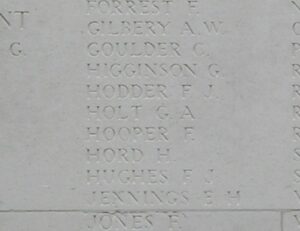
Thomas Hopkins, Private, 16251, South Wales Borderers. Thomas was born at Llanelli in 1886, the son of David and Margaret Hopkins, and prior to 1911 had moved with his wife Rose Hopkins, to 86, King Street, Cwm, Monmouthshire. He enlisted at Newport into the 8th Battalion, South Wales Borderers, which was attached to 67 Brigade, 22nd Division. The Division crossed to France in early September 1915, but on 27 October 1915 embarked from Marseilles for Salonika, where it remained for the war. Thomas was killed here on 7 May 1917, aged 31, during the Battle of Doiran. He is buried at Karasouli Military Cemetery, Greece.
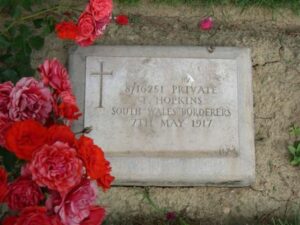
Alfred Horne, Private, 201621, Welsh Regiment. Alfred was born at Bristol, and by 1911 had moved to Llanboidy, where he worked as a farm hand. He then moved on to live at Pwll, and married Mary Jane Evans of Pwll in 1914. Alfred enlisted at Llanelli into the army. He was posted to France late in 1916, where he joined the 15th Battalion, Welsh Regiment, which was known as the Carmarthen Pals battalion, attached to 114 Brigade, 38th (Welsh) Division. The battalion had been in France since December 1915, and had fought at Mametz Wood in July 1916. After two days of heavy hand to hand fighting within the wood, the Germans withdrew, and the battered Welshmen moved via Hebuterne to Boesinghe, on the Yser Canal, where it remained until launching its attack on Pilckem Ridge on 31 July 1917. Alfred was killed during the build up to the main attack, on 27 July 1917. He was 30 years old, and is buried at Dragoon Camp Cemetery, Belgium.
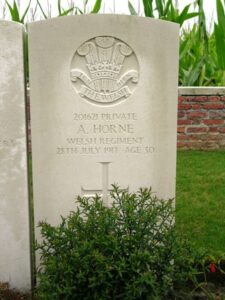
Henry George Howell, Sapper, 448445, Royal Engineers. Henry was the son of Mr. and Mrs. Howell, of Llanelli. He enlisted at Llanelli into the Welsh Field Company, Royal Engineers, which served at Gallipoli with the 53rd (Welsh) Division. After being evacuated from Gallipoli in January 1916 the Division remained in Egypt for just over a year, when it took part in the offensive into Palestine. By now Henry was serving with the 437th Field Company. Henry died of sickness during the Final Offensive beyond the Jordan on 19 October 1918, aged 29, and is buried at Gaza War Cemetery, Israel.
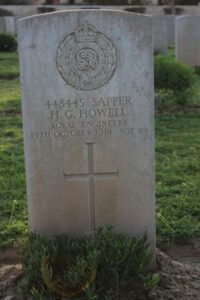
Brinley Joshua Howells, Private, 6278, Royal Fusiliers. Brinley was born in 1890, the son of John Howells and Esther Howells (nee Davies), of Lynholme, 14, Glenalla Road, Llanelli. He was educated at Llanelli Grammar School, prior to becoming a schoolteacher. Brinley was a highly regarded rugby player who also excelled in tennis. He moved to Abertridwr prior to the war, where he worked as a schoolmaster at Senghenydd, and enlisted there into the Royal Fusiliers. Brinley was posted to the 21st Battalion, Royal Fusiliers, which was known as the 4th Public Schools battalion, and was attached to 19 Brigade, 33rd Division. (The members of the battalion were later known as the Chocolate Soldiers by members of the 2nd RWF in the same Brigade, due to the amount of goods sent to them by loved ones back home). The battalion embarked for France at Folkestone aboard the SS Princess Victoria on 14 November 1915 and disembarked at Calais, then entrained for Boulogne, before the entire division moved to positions near Bethune, taking over trenches near Beuvry. The Division endured a hard time during its first few months in the line, holding such notorious sectors as Cambrin and Cuinchy, where underground warfare was prevalent. Brinley was killed in action here during a routine spell in the trenches on 8 February 1916. The 26-year-old was buried in Cambrin Churchyard Extension, France.
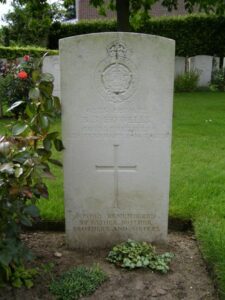
Llewellyn Howells, Private, 260389, Gloucestershire Regiment. Llewellyn was the son of John and Mary Ann Howells, of 16, Biddulph Street, New Dock, Llanelli. He enlisted there into the Monmouthshire Regiment. He was later transferred into the 12th (Bristol) Battalion, Gloucestershire Regiment, which landed in France on 21 November 1915, becoming attached to 95 Brigade, 5th Division the following month. March 1916 saw the Division moving to positions between St. Laurent-Blangy and Vimy, near Arras. On 1 July 1916 the Battle of the Somme opened, and the Division moved south, fighting at High Wood, Guillemont, Flers-Courcelette, Morval and Le Transloy. On 5 October 1916, after suffering heavy casualties, the Division moved to Festubert, where they remained until March 1917. They next saw action at the Battle of Arras. On 7 September 1917, they were pulled out of the line again, and moved north to join the great offensive in Flanders. Llewellyn was killed here during the Battle of Broodseinde, on 10 October 1917, aged 18. He is buried at Hooge Crater Cemetery, Belgium.
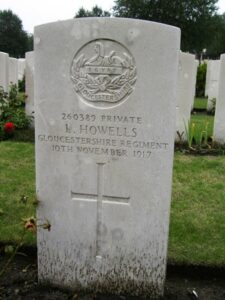
Trevor Howells, Sergeant, 12868, Royal Welsh Fusiliers. Trevor was the son of David and Mary Howells, of 9, Dolau Fach, Llanelli. He lived at Bryn Road, Llanelli prior to the war, working as a Behinder at the Tinplate Works, and enlisted at Llanelli into the 9th Battalion, Royal Welsh Fusiliers, which was attached to 58 Brigade, 19th (Western) Division. The Division moved to France during July 1915, and took up positions around Givenchy, near Loos. Trevor was killed during the opening assault of the Battle of Loos, on 25 September 1915, aged 25, while attempting to rig up a stretcher to rescue a wounded comrade. His grave was found after the war, and Trevor was re-interred at Cabaret Rouge British Cemetery, Souchez, France.
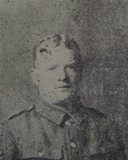
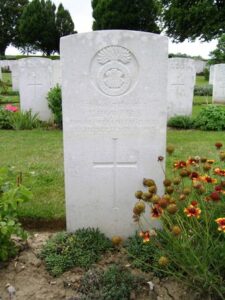
Arthur James Hughes, Private, 59733, Royal Welsh Fusiliers. Arthur was the son of Hugh and Margaret Hughes, of Penmaenmawr. He resided at Llanelli prior to the war, and enlisted there into the Welsh Regiment. He was then transferred to the 17th Battalion, Royal Welsh Fusiliers, which was in France attached to 115 Brigade, 38th (Welsh) Division. Arthur probably joined the battalion at Boesinghe, after the Division had been pulled from the Somme battlefield, after the capture of Mametz Wood. The Division held the line along the Yser Canal at Boesinghe until launching their assault on Pilckem Ridge on 31 July 1917. Arthur was 32 years old when he was killed that day, during fighting around Iron Cross. He is commemorated on the Ypres (Menin Gate) Memorial, Belgium.
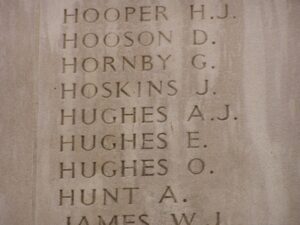
Brinley Thomas Hughes, Wireless Operator, Mercantile Marine. Brinley was the only son of Thomas and Mary Hughes (nee Williams), of 11, Havard Road, Llanelli. He served as a wireless operator aboard the SS Leasowe Castle. She had been built for a Greek company, but due to the war was taken over by the British government in 1917. Soon after going into service she was torpedoed off Gibraltar on 20 April 1917, but managed to reach port, where she was repaired. On 27 May 1917 she was in convoy from Egypt to Marseilles when she was torpedoed and sunk 104 miles off Alexandria. She was carrying 3,000 troops at the time. Brinley was one of ninety-two people who drowned aboard her that day. He was 22 years old, and is commemorated on the Tower Hill Memorial, London.
David Joseph Hughes, Private, 201404, Welsh Regiment. David was the son of William and Amelia Hughes, of Llanelli. He enlisted there into the 1/4th Battalion, Welsh Regiment, which was the local Territorial Battalion, attached to 159 Brigade, 53rd (Welsh) Division. The Division landed at Cape Helles, Gallipoli, on 9 August 1915, and was immediately thrown into action, spending the next few days in isolated pockets, fighting against a Turkish counter-attack during the Battle of Sari Bair, and then at the Attack on Scimitar Hill. The Division remained here throughout the coming months, and suffered severe losses in manpower strength during the great November 1915 blizzard on Gallipoli, when its total strength was reduced to less than that of a full-strength Brigade. On 11 December 1915 the Division was evacuated to Mudros, and by 23 December 1915 were moved to Egypt. They remained on the Suez Canal Defences for the next twelve months, where it took part in operations against the Sultan of Darfur, and in March 1917 took part in the advance into Palestine. David was killed in Palestine on 12 May 1917, aged 24. He is buried at Gaza War Cemetery, Israel.
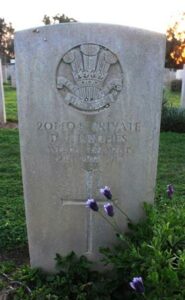
David Thomas Hughes, Private, 20609, Welsh Regiment. David was the son of John and Catherine Hughes, of Greenfields, Llanelli. He worked at the Bynea Steelworks prior to enlisting at Llanelli in February 1915 into the 15th Battalion, Welsh Regiment, which was known as the Carmarthen Pals battalion. After training at Rhyl and Winchester, the battalion joined 114 Brigade, 38th (Welsh) Division, and landed in France on 2 December 1915. David was attached to the 16th Battalion at some time after this, which was the Cardiff City battalion, serving with the same division. After several months in the line around Fleurbaix and Givenchy, the Division marched south to the Somme in June 1916, and on 7 July 1916 launched their first assault on Mametz Wood. The 16th Welsh were mown down by German machine-gun fire while attempting to cross open fields into the wood, and David became one of hundreds of men killed that day. He was 25 years old, and is commemorated on the Thiepval Memorial, France.
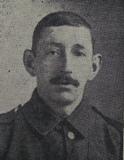
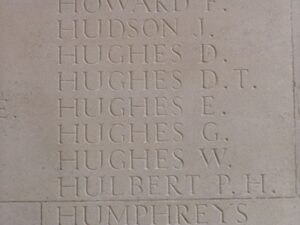
David Walter Hughes, Private, 23531, Dorsetshire Regiment. David was the son of John and Margaret Hughes, of 25, Old Castle Road, Llanelli, and the husband of Henrietta Griffiths (formerly Hughes), of Goring Villa, 21, Ellington Rd., Burry Port. David had been an Ironmonger’s Assistant prior to enlisting at Llanelli into the 6th Battalion, Dorsetshire Regiment. The Battalion was attached to 50 Brigade, 17th (Northern) Division, which had been in France since 17 July 1915. They spent their initial period of trench familiarisation and then holding the front lines in the southern area of the Ypres salient. Here they took part in fighting at the Bluff during February 1916 before moving south, where they fought at the Battle of Albert, where the Division captured Fricourt at heavy cost during the opening of the Somme Offensive. They then saw action during the Battle of Arras, at the First and Second Battles of the Scarpe and the Capture of Roeux, before moving back to Ypres, and taking part in the First and Second Battles of Passchendaele. In March 1918 the Division were on the Somme, and faced the German Spring Offensive there, fighting at the Battle of St Quentin, and retreated back, fighting at the First Battle of Bapaume. After a period out of the line to rest and rebuild, the Division moved to the southernmost sector of the Somme area, where they fought at the Battle of Amiens on 8 August 1918, a day which saw the war swing in the favour of the Allies. The Allies then advanced on the Somme, and the Division fought at the Battle of Albert later that month. It was here that David was killed in action on 24 August 1918. He was 26 years old, and is buried at Mill Road Cemetery, Thiepval, France.
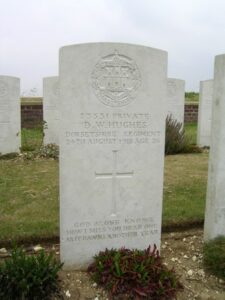
Thomas Hughes, Corporal, 12226, Royal Welsh Fusiliers. Thomas was born at Llanelli, and enlisted at Ammanford into the 8th Battalion, Royal Welsh Fusiliers. The battalion was attached to 40 Brigade, 13th (Western) Division. On 13 June 1915 the Division sailed for Alexandria, and moved to Mudros before being landed at Cape Helles, Gallipoli from 6 July 1915, relieving the 29th Division. They left and returned to Mudros at the end of the month, and the entire Division landed at ANZAC Cove by 5 August 1915. Thomas was killed here during the Battle of Sari Bair, on 12 August 1915. He is commemorated on the Helles Memorial, Gallipoli.
Thomas Hughes, Private, 200789, Welsh Regiment. Thomas was the son of Thomas and Harriet Hughes, of Island Place, Llanelli. He enlisted at Llanelli into the 1/4th Battalion, Welsh Regiment, which was the local Territorial Battalion, attached to 159 Brigade, 53rd (Welsh) Division. The Division landed at Cape Helles, Gallipoli, on 9 August 1915, and was immediately thrown into action, spending the next few days in isolated pockets, fighting against a Turkish counter-attack during the Battle of Sari Bair, and then at the Attack on Scimitar Hill. The Division remained here throughout the coming months, and suffered severe losses in manpower strength during the great November 1915 blizzard on Gallipoli, when its total strength was reduced to less than that of a full-strength Brigade. On 11 December 1915 the Division was evacuated to Mudros, and by 23 December 1915 were moved to Egypt. They remained on the Suez Canal Defences for the next twelve months, where it took part in operations against the Sultan of Darfur, and in March 1917 took part in the advance into Palestine. Thomas was killed during the First Battle of Gaza, on 26 March 1917. He was 31 years old, and is commemorated on the Jerusalem Memorial, Israel.
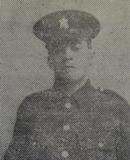
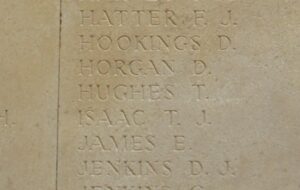
William Trevor Hughes, Private, 53967, Welsh Regiment. William was born at Llanelli in December 1895, the son of Elizabeth Jane Hughes. The family later resided at 18, Roseberry Terrace, Plasmarl, Swansea. William enlisted at Swansea into the army, and sometime in 1917 was posted to France, where he joined the 15th Battalion, Welsh Regiment, which was the Carmarthen Pals battalion, attached to 114 Brigade, 38th (Welsh) Division. William would have probably joined the battalion at Ypres. He would have fought at Pilckem Ridge in July and August 1917. The Division wintered in the Armentieres Sector, before being moved to the Somme in April 1918, taking up positions around Aveluy Wood, north of Albert. William was wounded here early in May, and died on 4 May 1918. He was 22 years old, and is buried at Bagneux British Cemetery, Gezaincourt, France.
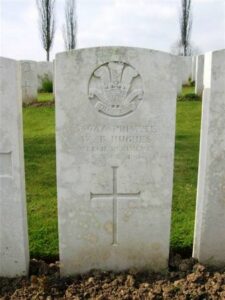
Idwal Machno Humphreys, Private, 125585, Machine Gun Corps. Idwal was the son of Rev. Richard Machno Humphreys and Jane Elizabeth Humphreys, of 19, Shirley Road, Roath Park, Cardiff. He served during the war with the 121st Company, Machine Gun Corps, and was taken prisoner by the Germans at sometime, probably during their offensive of 21 March 1918 onwards. Idwal survived the war, but died in London just hours after arriving home following repatriation from Germany, on 11 January 1919. He was 25 years old, and was brought home for burial at Box Cemetery, Llanelli.
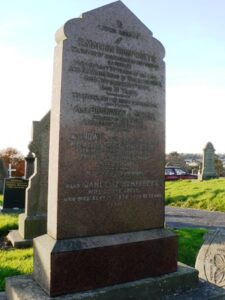
Hubert Murray Hussey, MC, Second Lieutenant, South Staffordshire Regiment. Hubert was born in Ireland in 1898, the son of John Edward Hussey and Gladys Marianne Hussey (nee Buckley). His mother’s family owned Bryncaerau Castle, at Llanelli, and Hubert spent a lot of time with his maternal family. He was commissioned into the 2nd Battalion, South Staffordshire Regiment in April 1917, and posted to France, joining the 1/6th Battalion, South Staffordshire Regiment. The battalion was attached to 137 Brigade, 46th (North Midland) Division. Within months, Hubert was awarded the Military Cross. The citation was published in the London Gazette of 18 July 1918, and read: ‘For conspicuous gallantry and devotion to duty during an enemy attack. He continually took messages to other companies and to isolated positions under heavy fire. He reconnoitred the position, and obtained most valuable information and organised the ammunition supply. His energy and fearlessness were an inspiring example to all.’ Hubert was sadly killed just weeks after, on 6 August 1918, aged 20. He is buried in Chocques Military Cemetery, France.
William George Hutt, Lance Corporal, 1822, Oxfordshire and Buckinghamshire Light Infantry. William was the son of Robert and Mary Hutt, of North-End Square, Buckingham. He had worked as a Charger at the South Wales Works, Llanelli prior to the war, but returned home to Buckingham to enlist into the 1st/1st Bucks Battalion, Ox and Bucks Light Infantry, which was attached to the South Midland Brigade, South Midland Division. The battalion landed at Boulogne on 30 March 1915, and moved to positions near Ploegsteert Wood. William was on patrol, repairing barbed wire entanglements in front of the trenches when he was shot and killed by a German sniper on 27 April 1915. He was 25 years old, and is buried at Ploegsteert Wood Military Cemetery, Belgium.